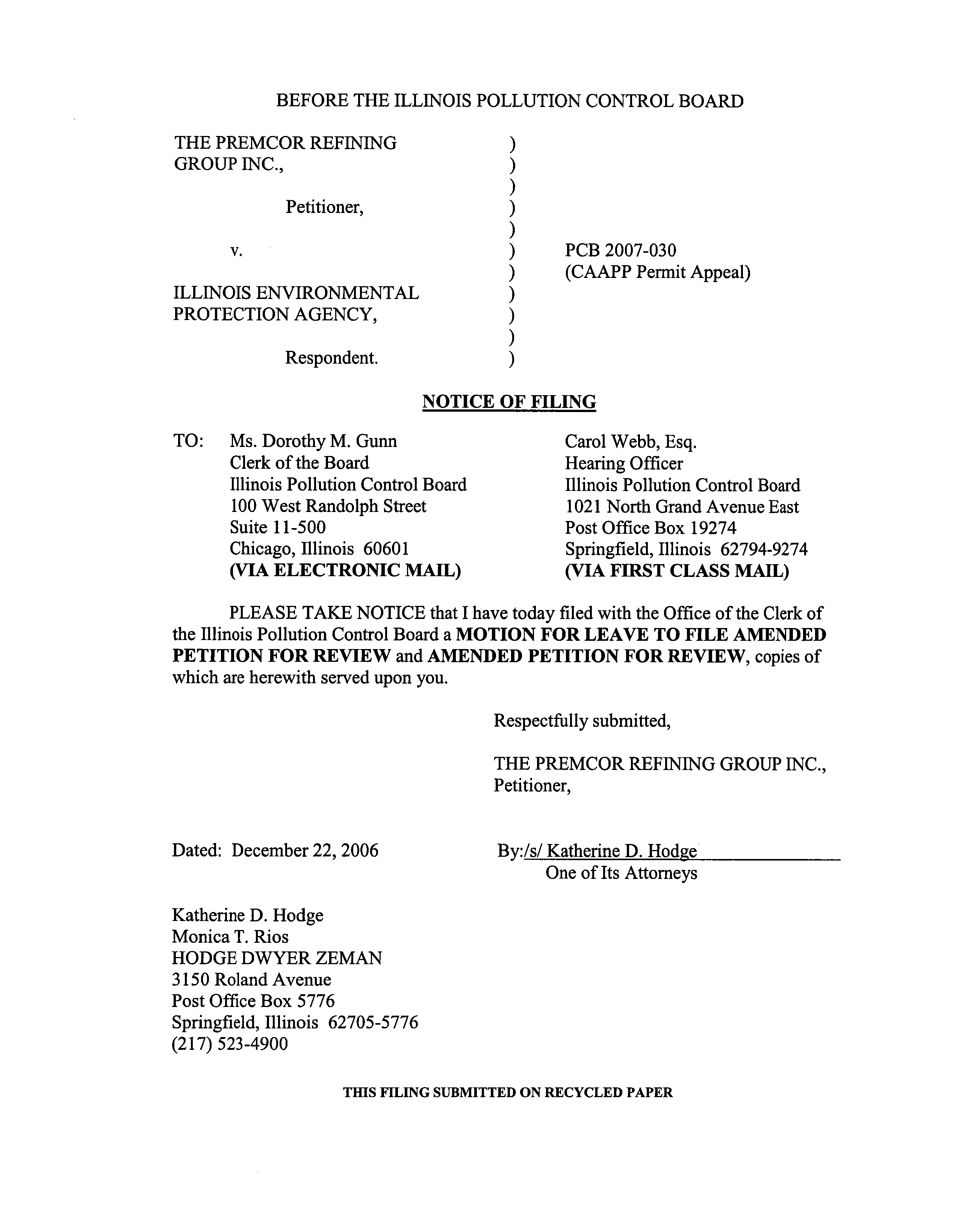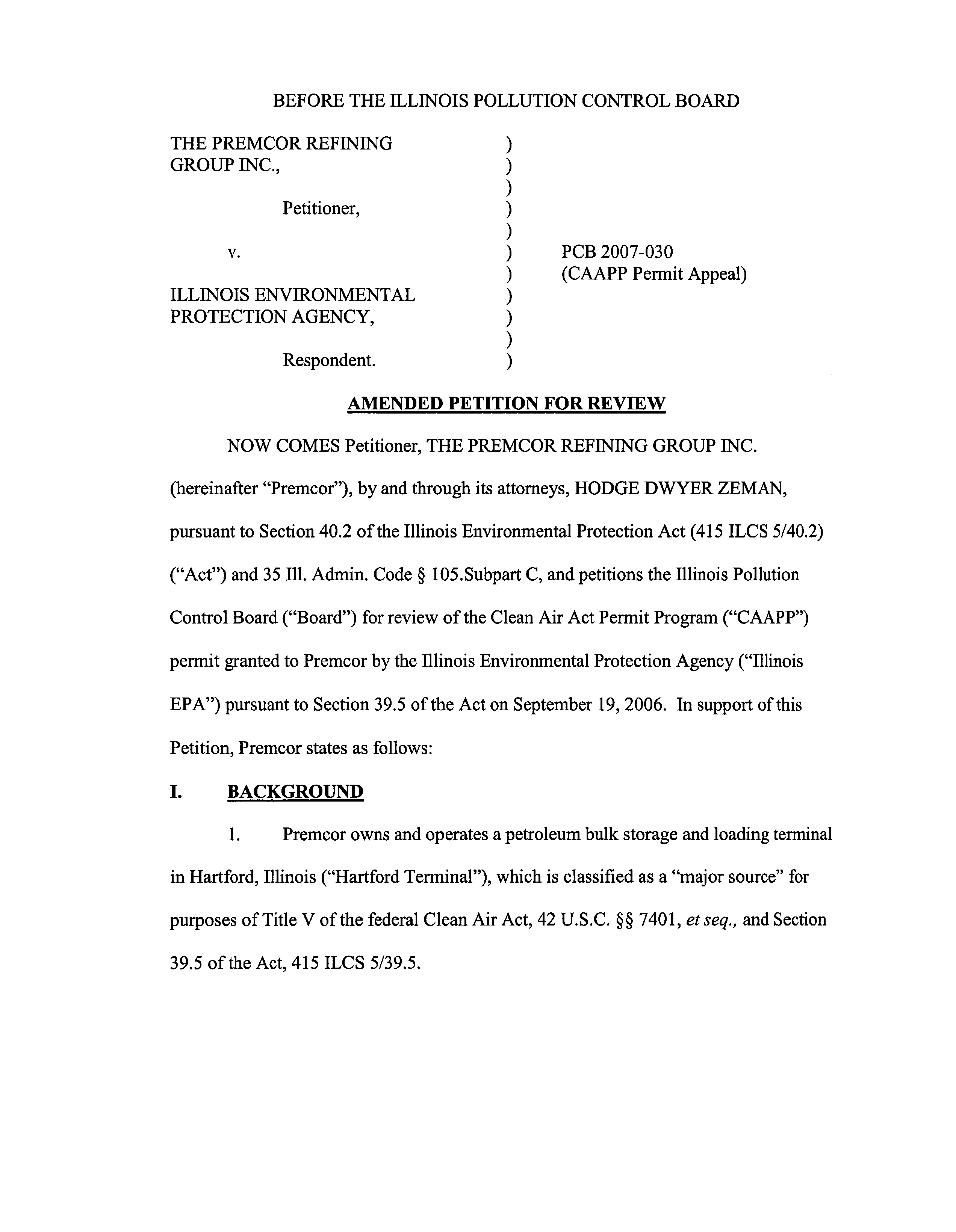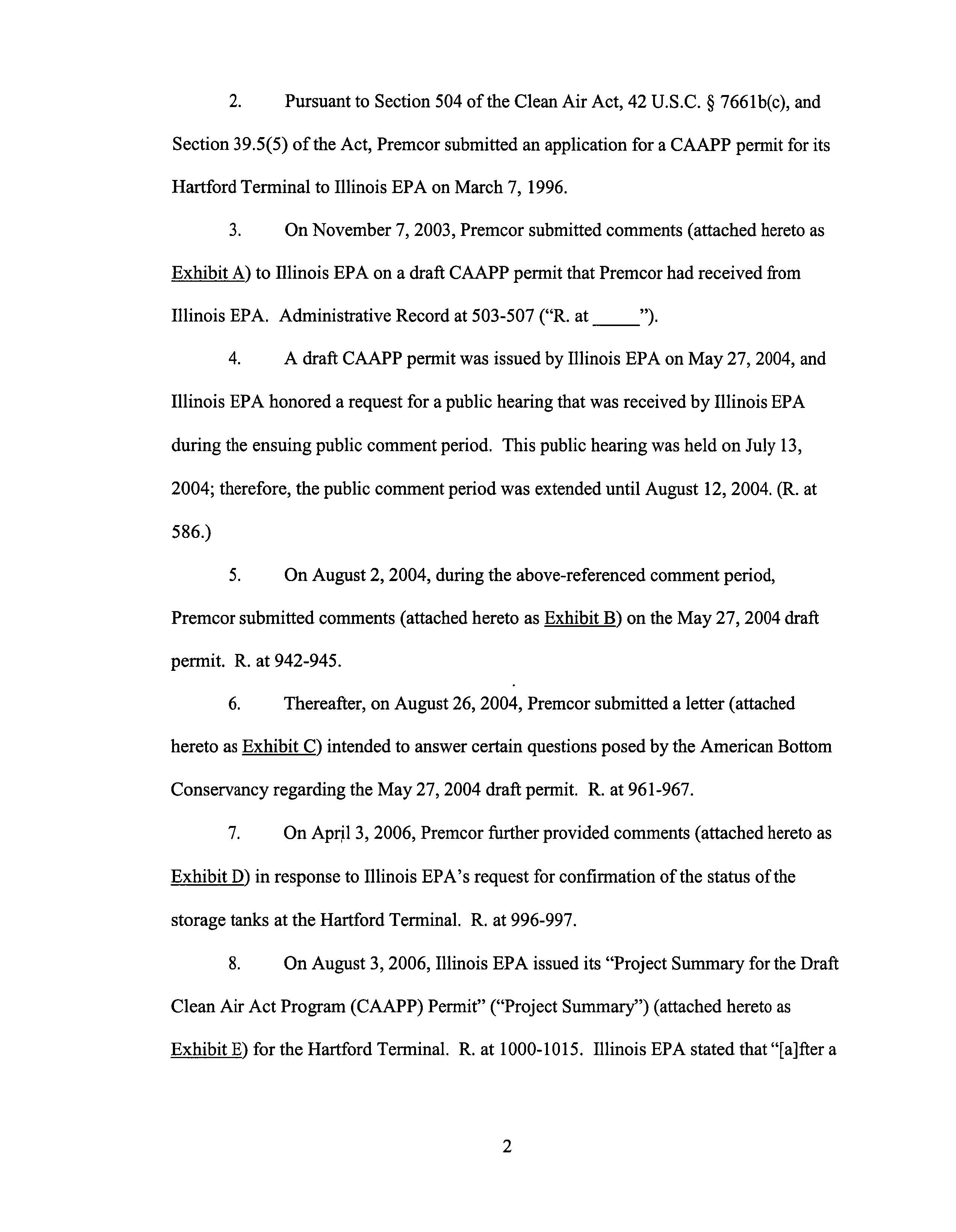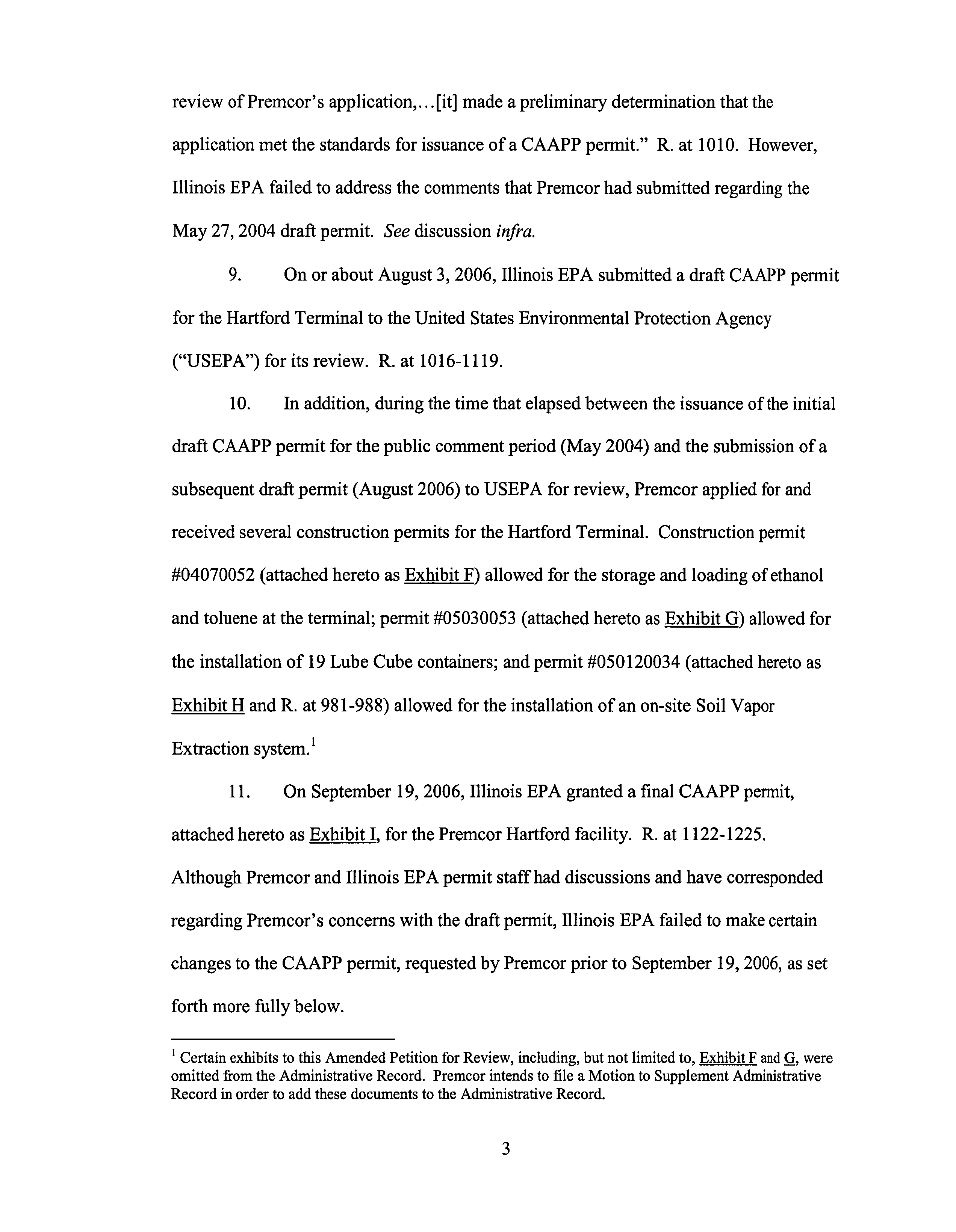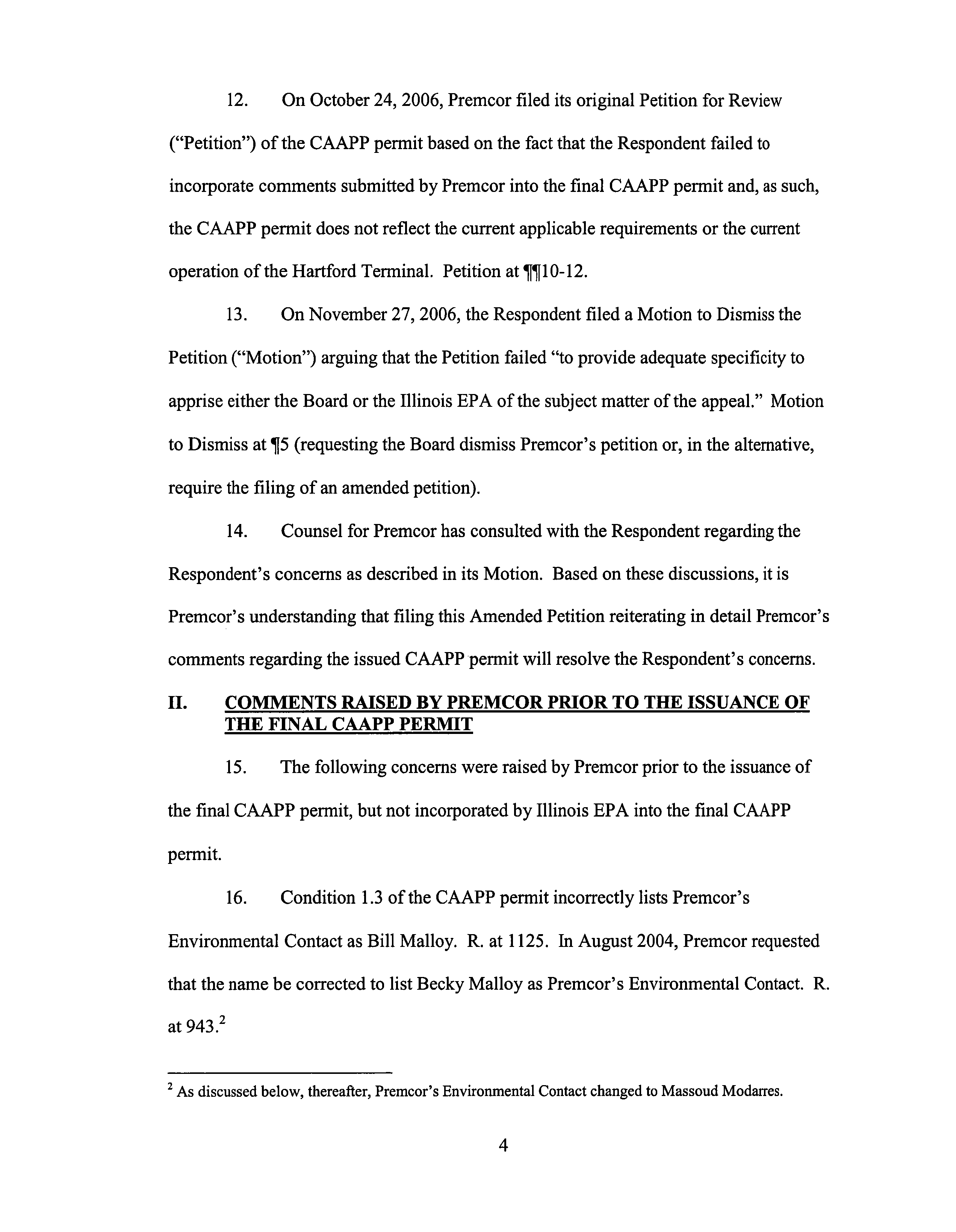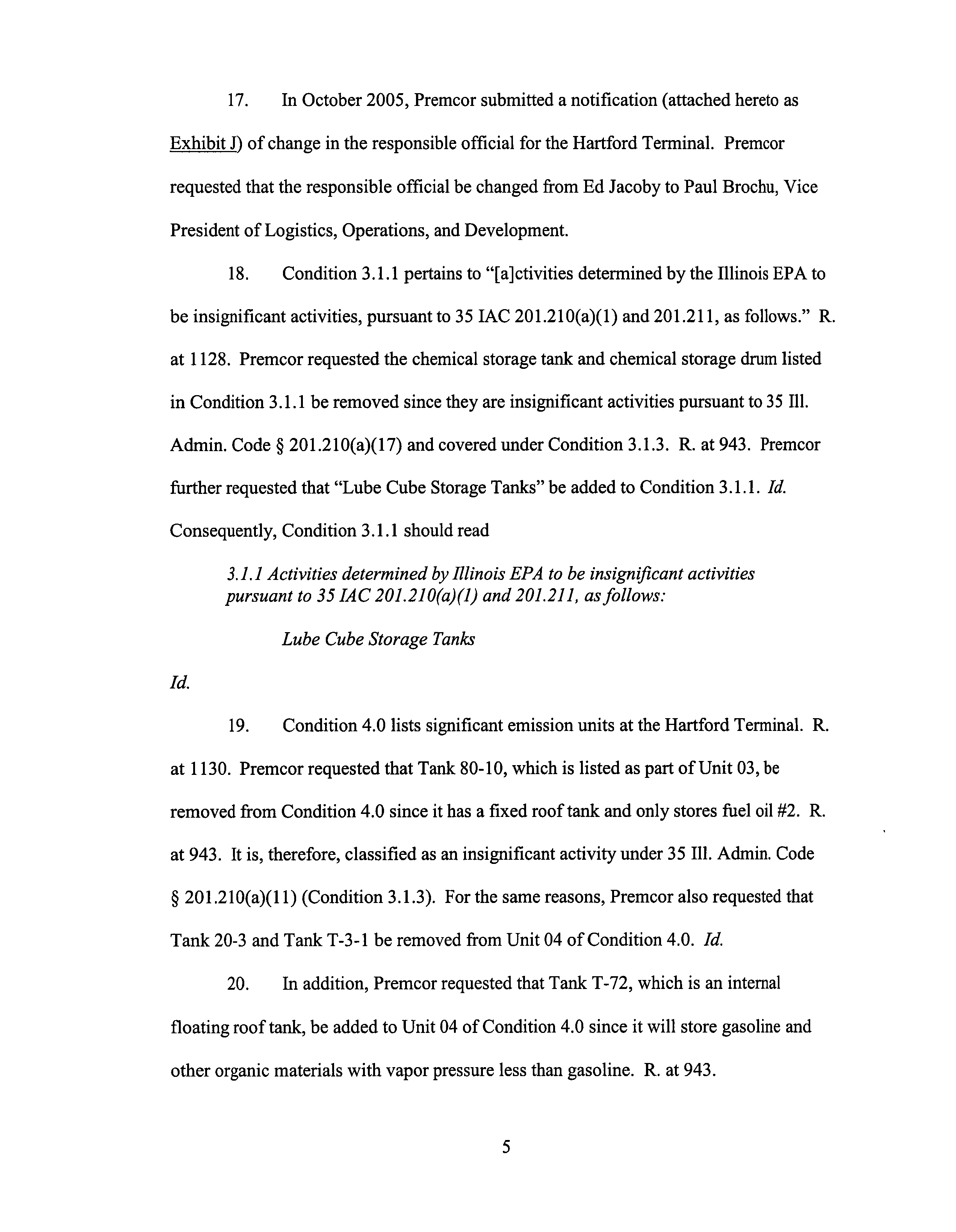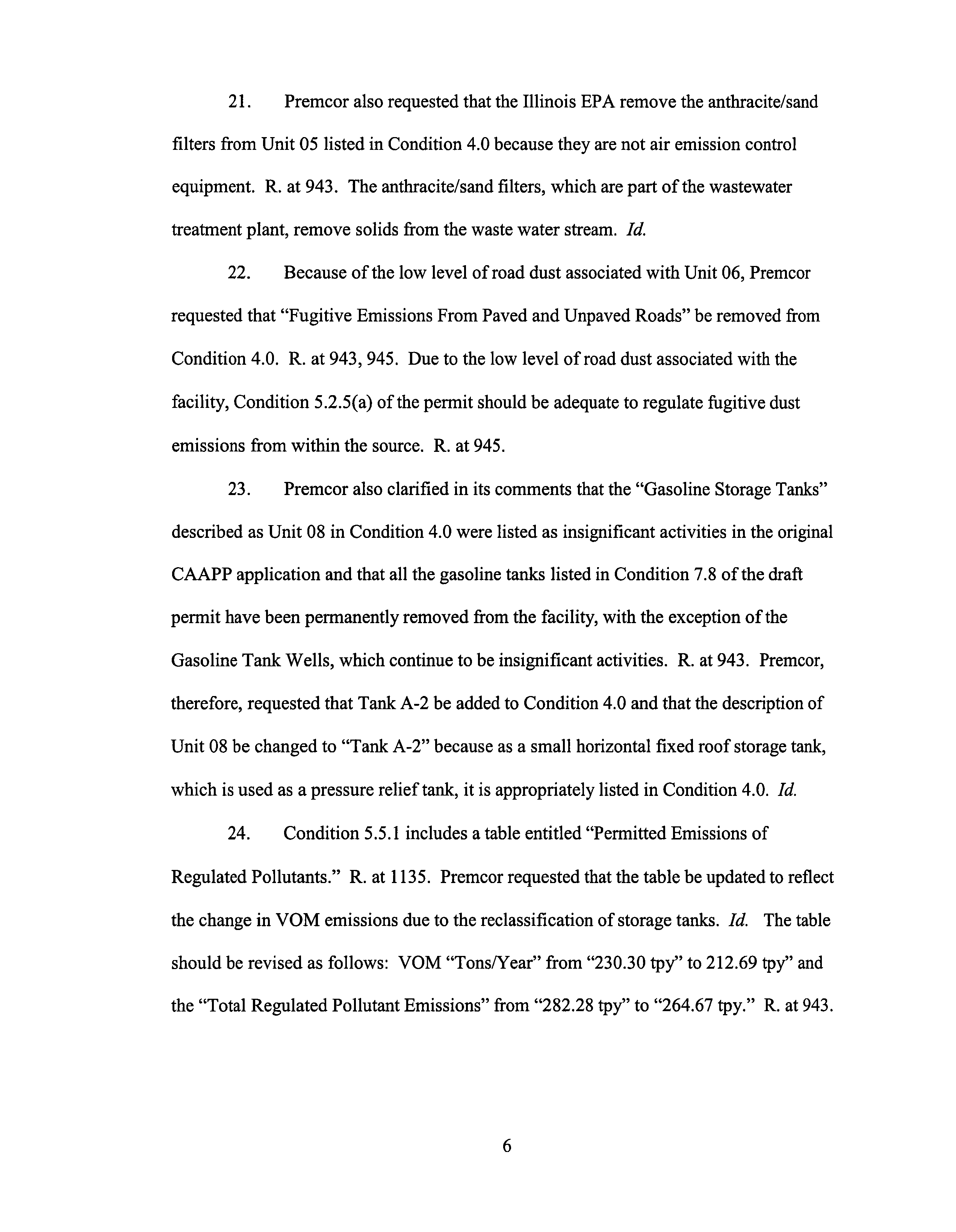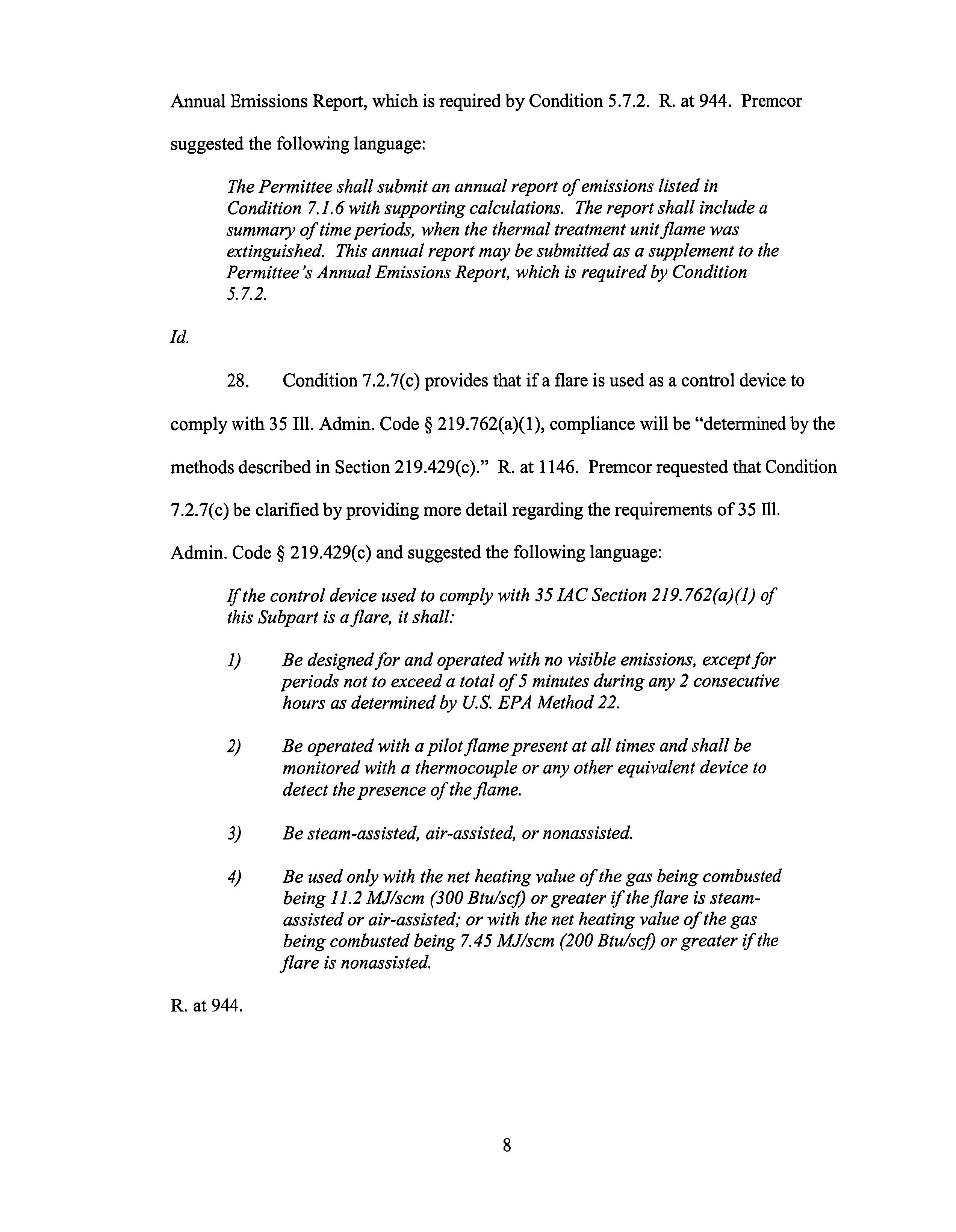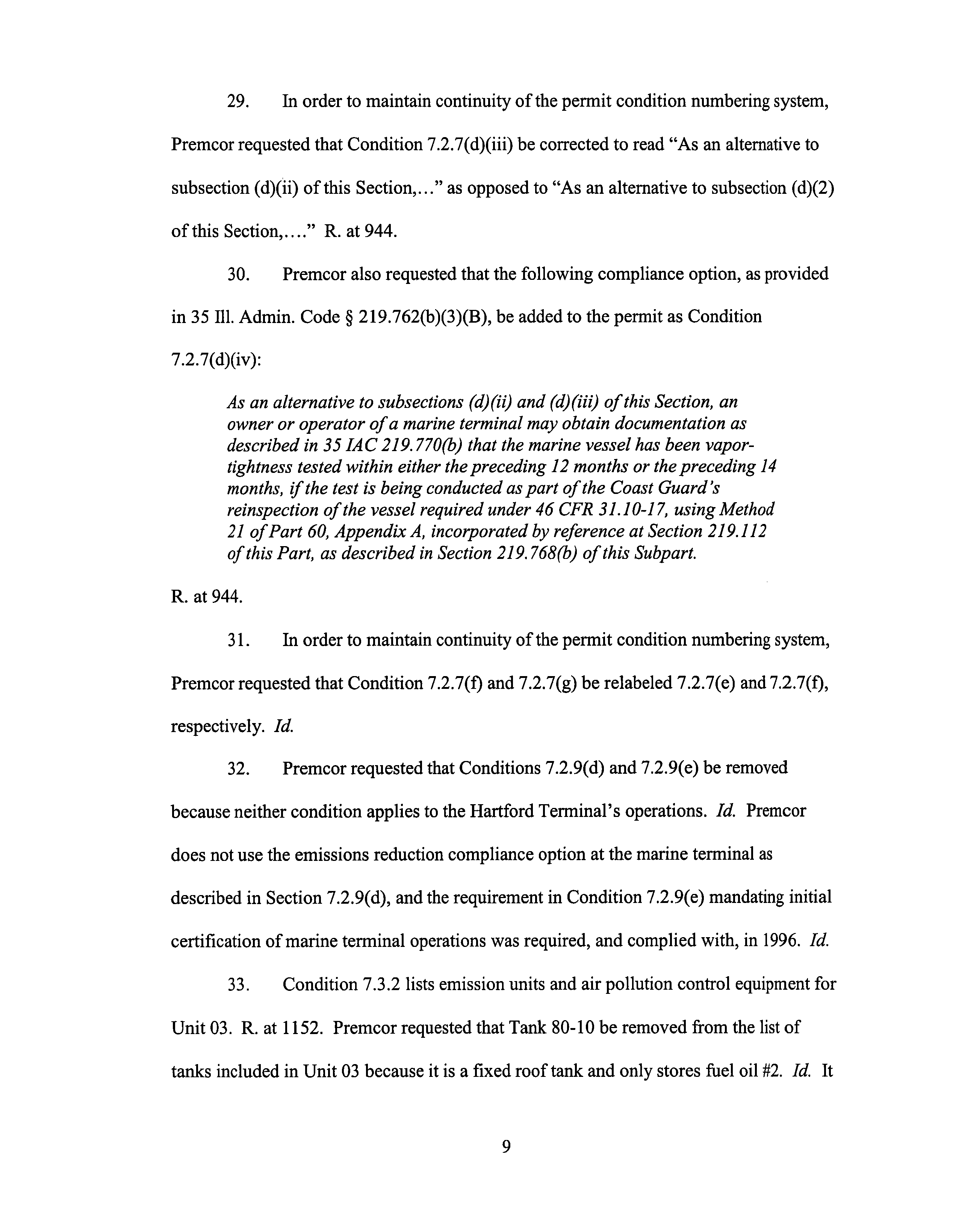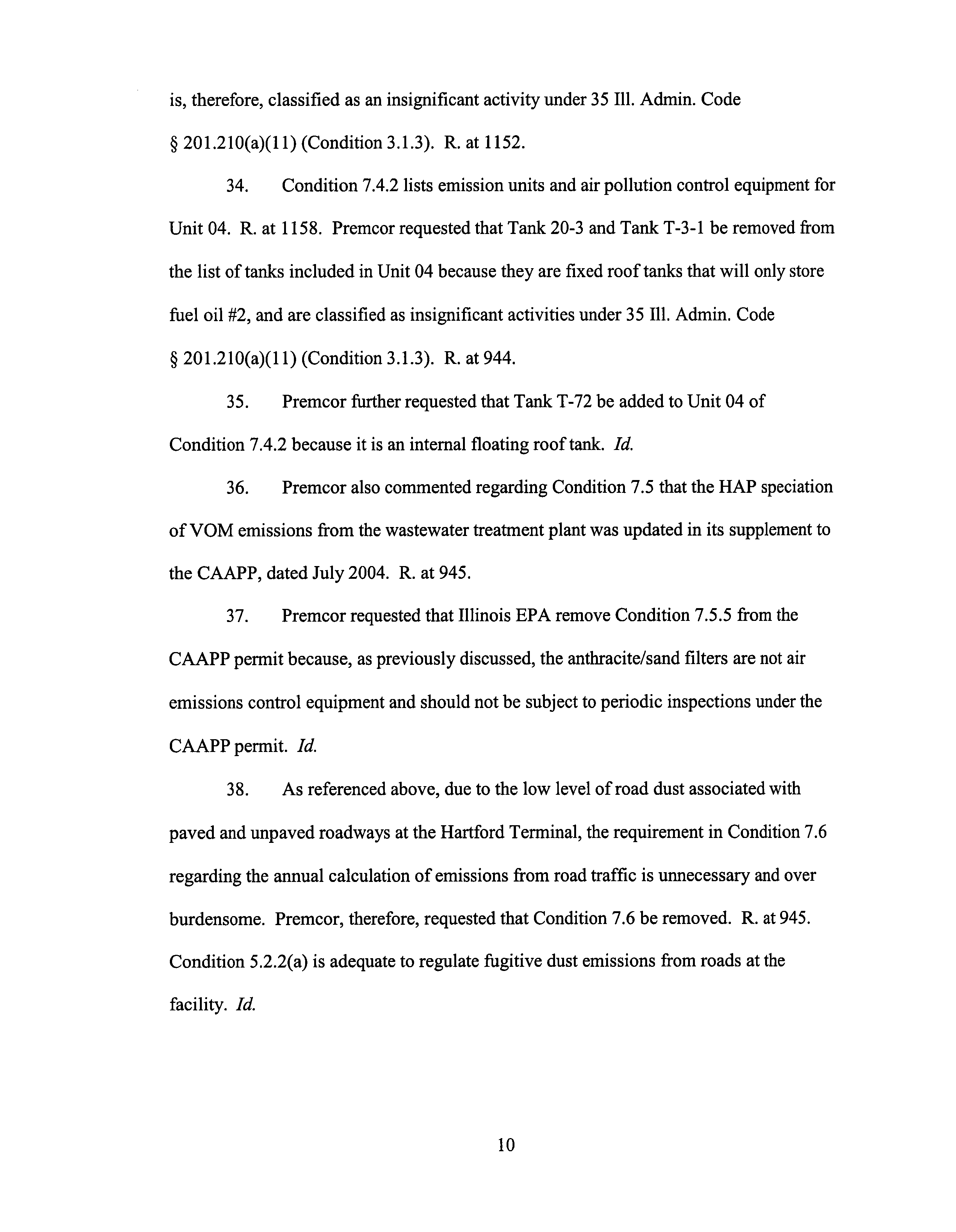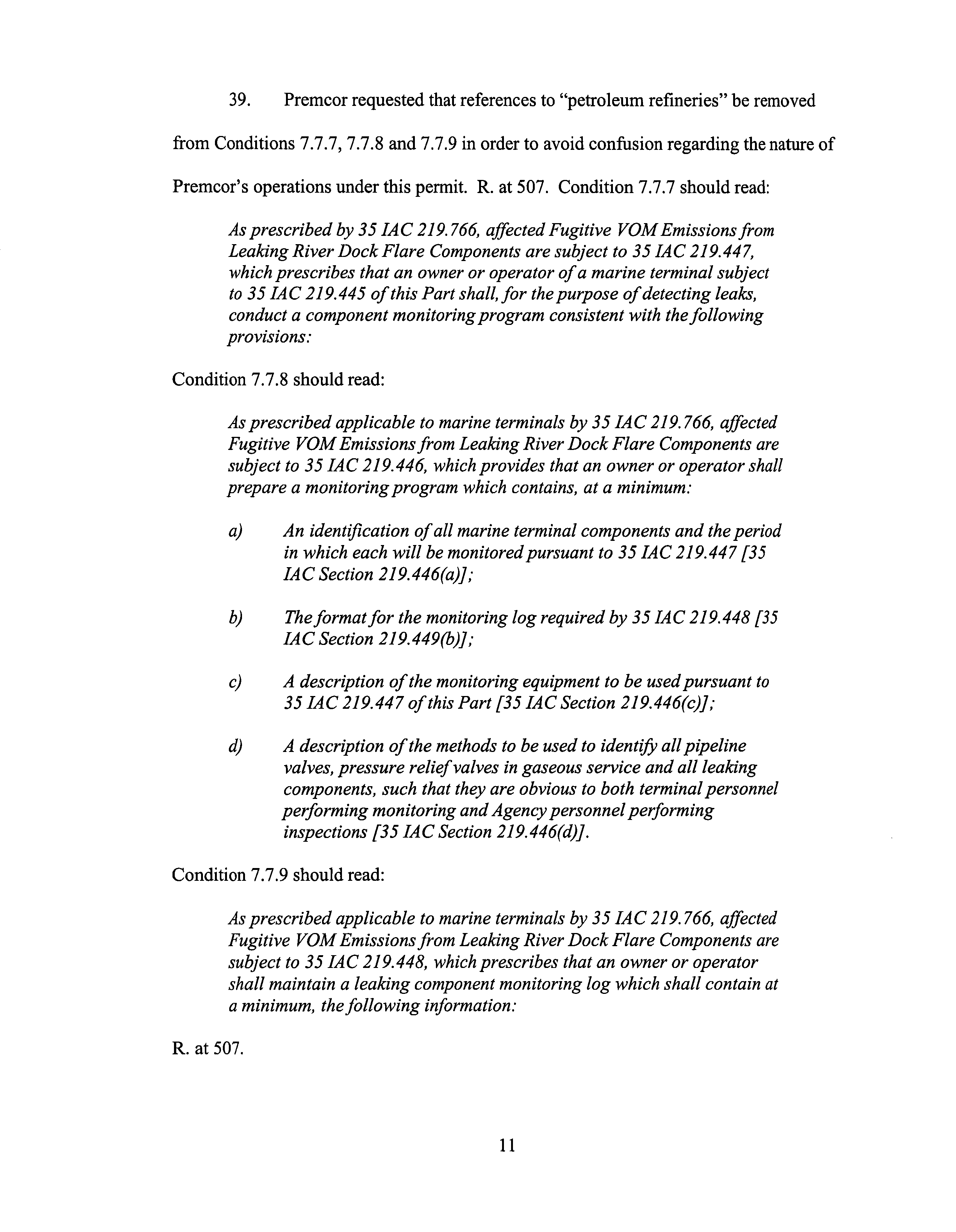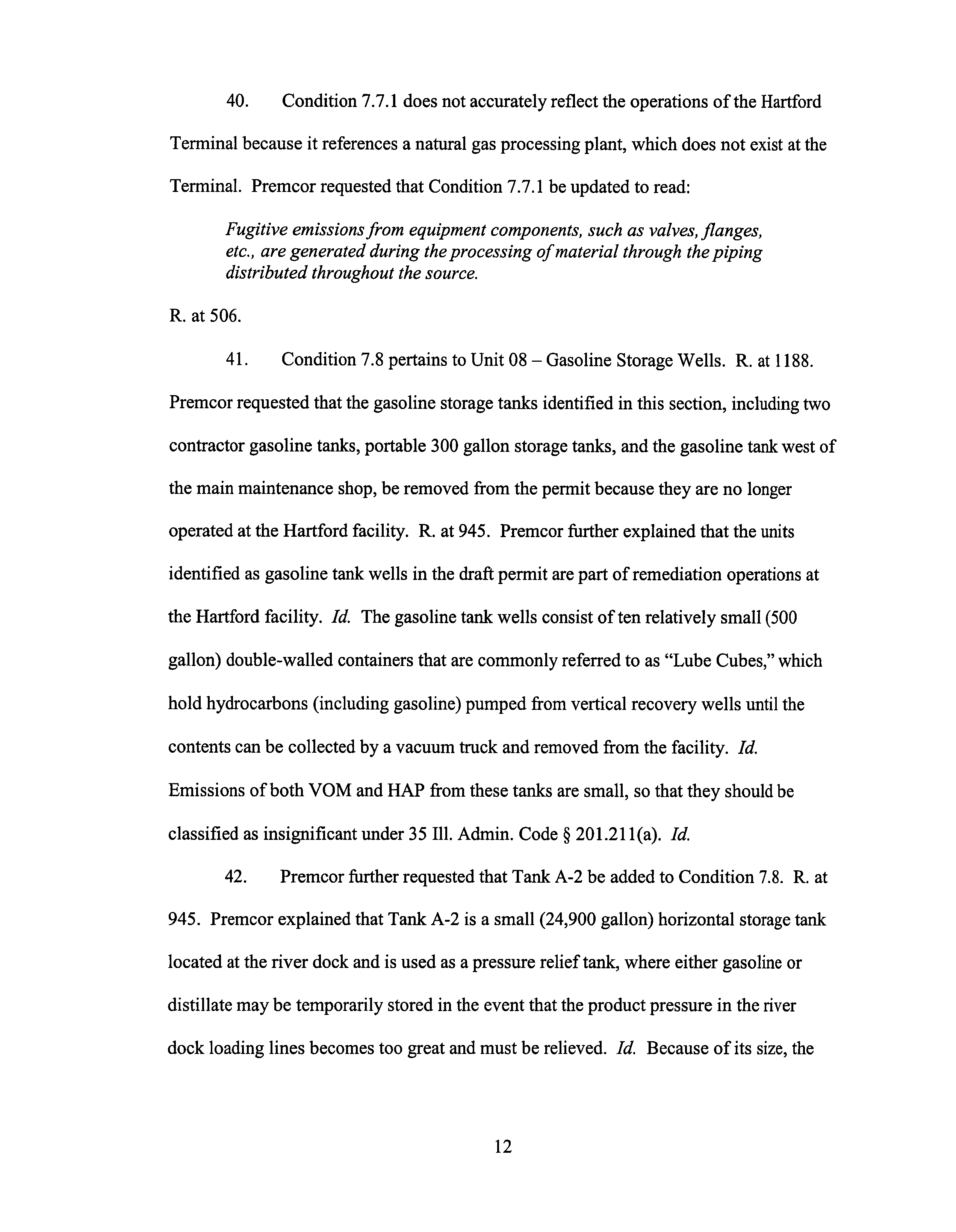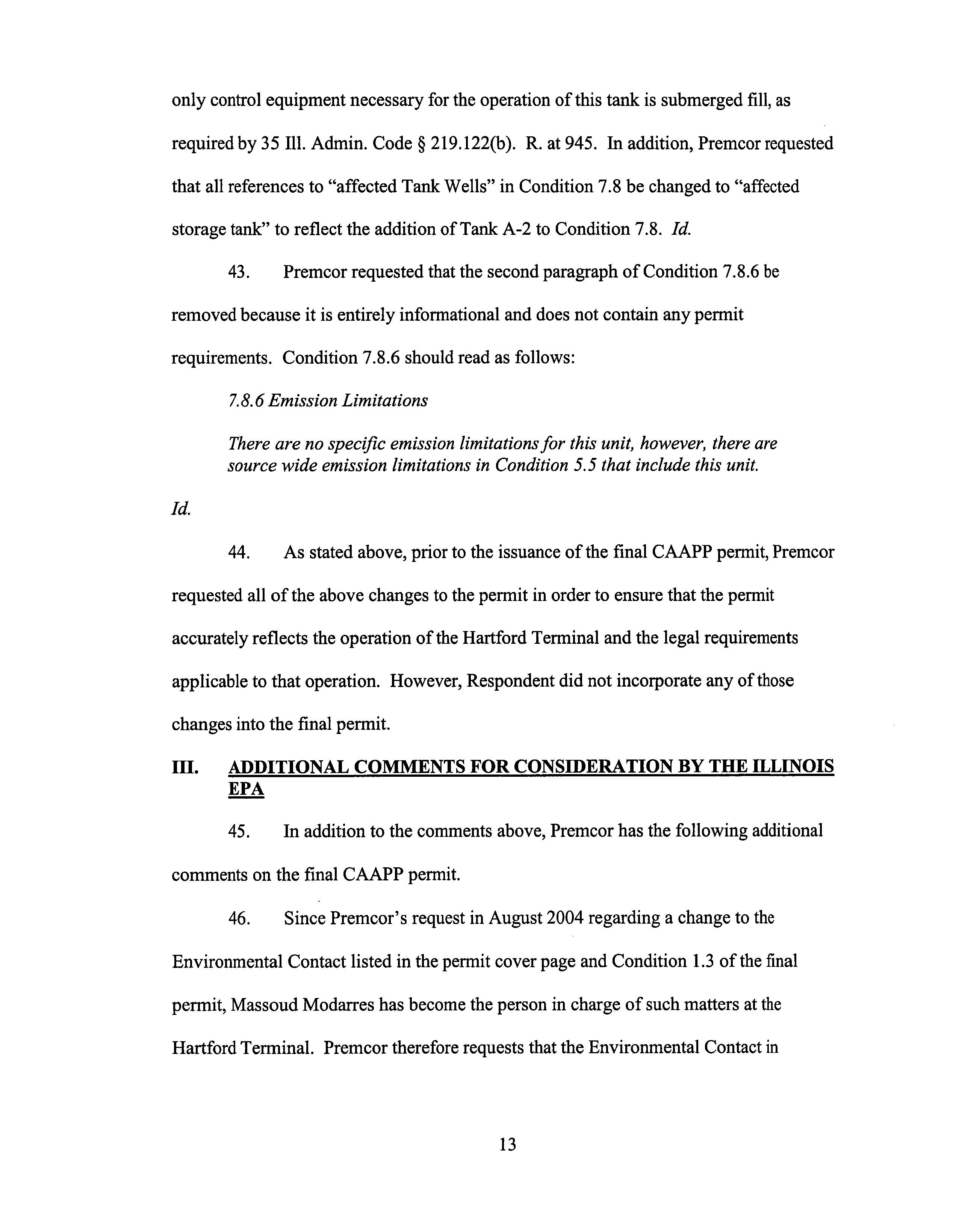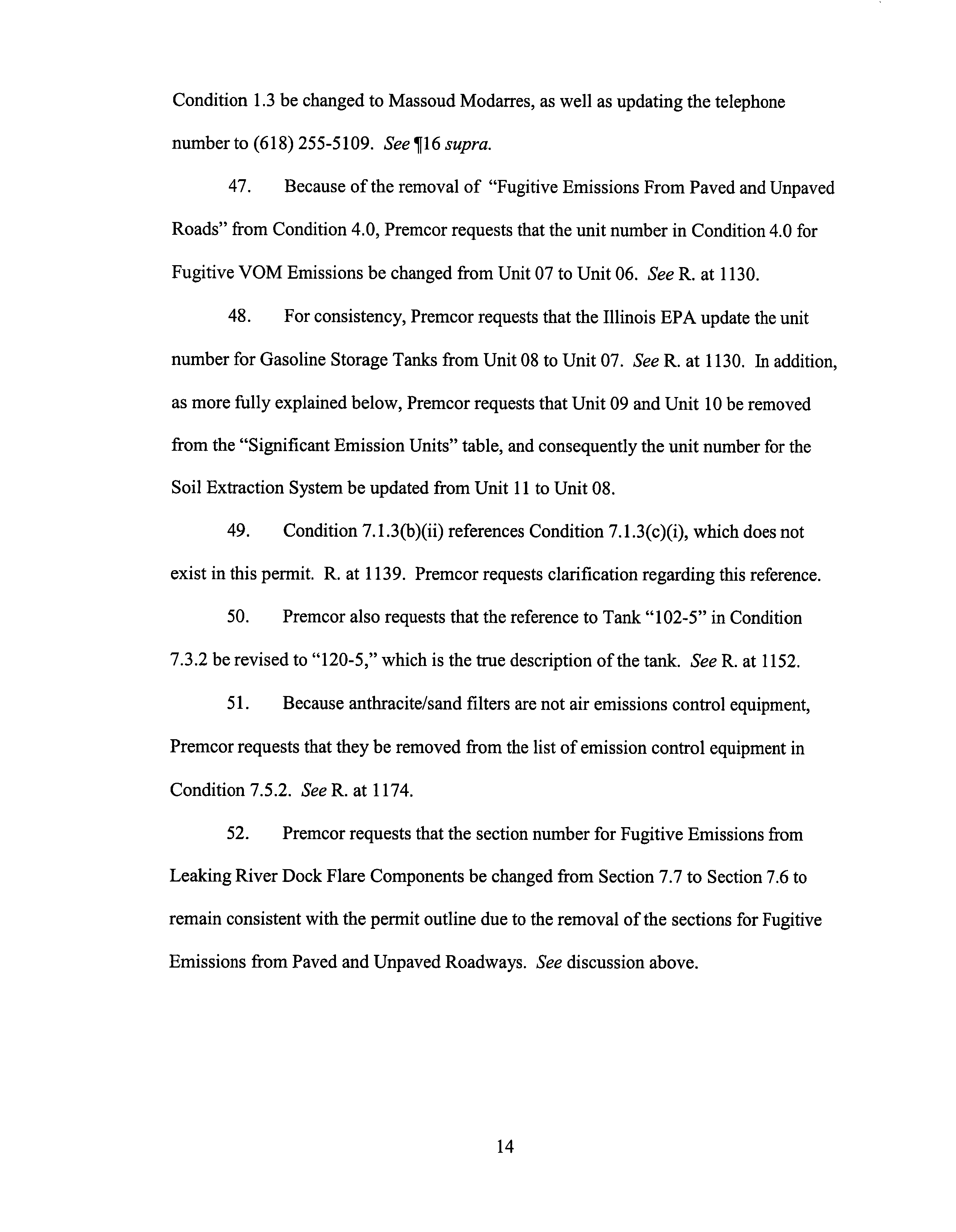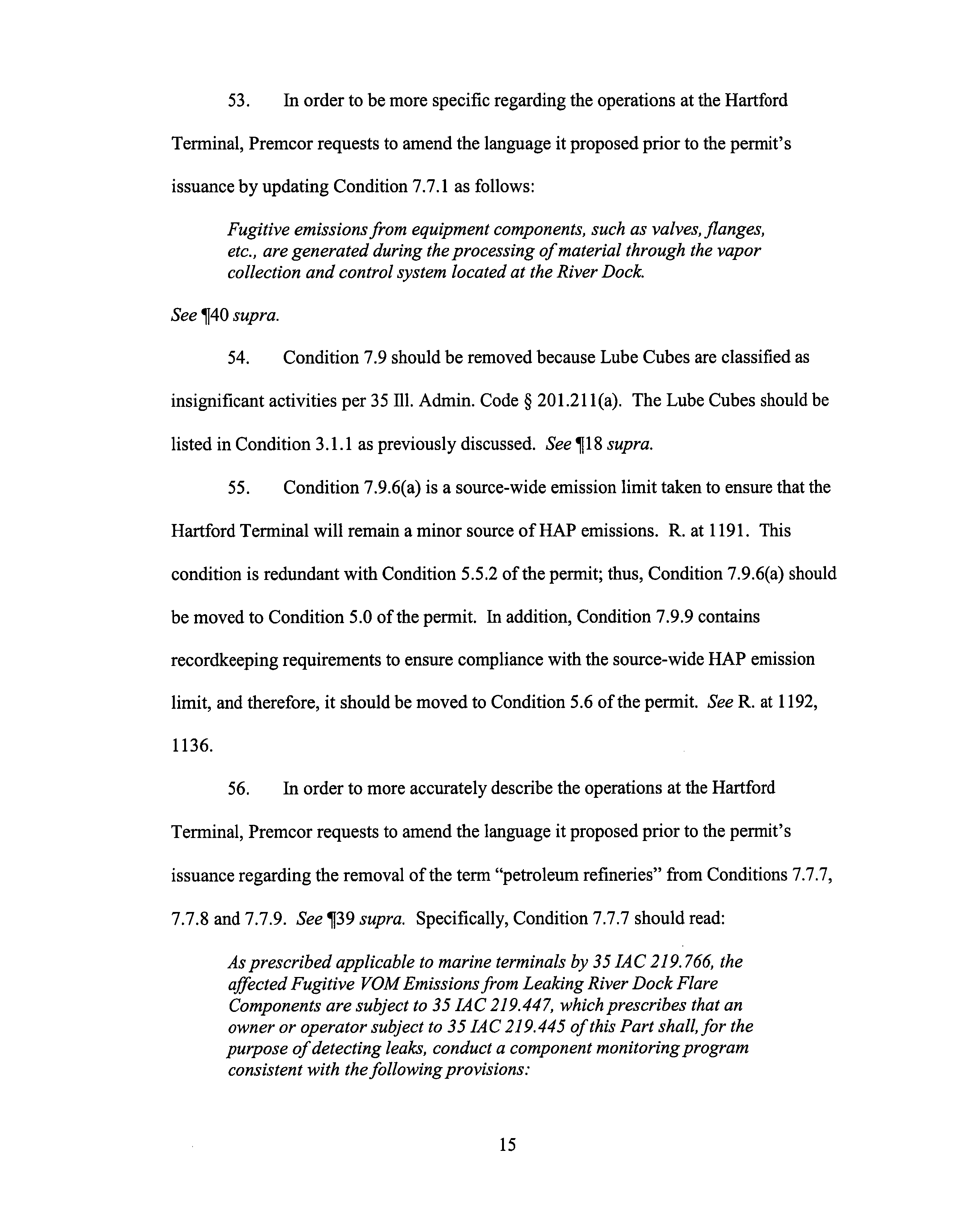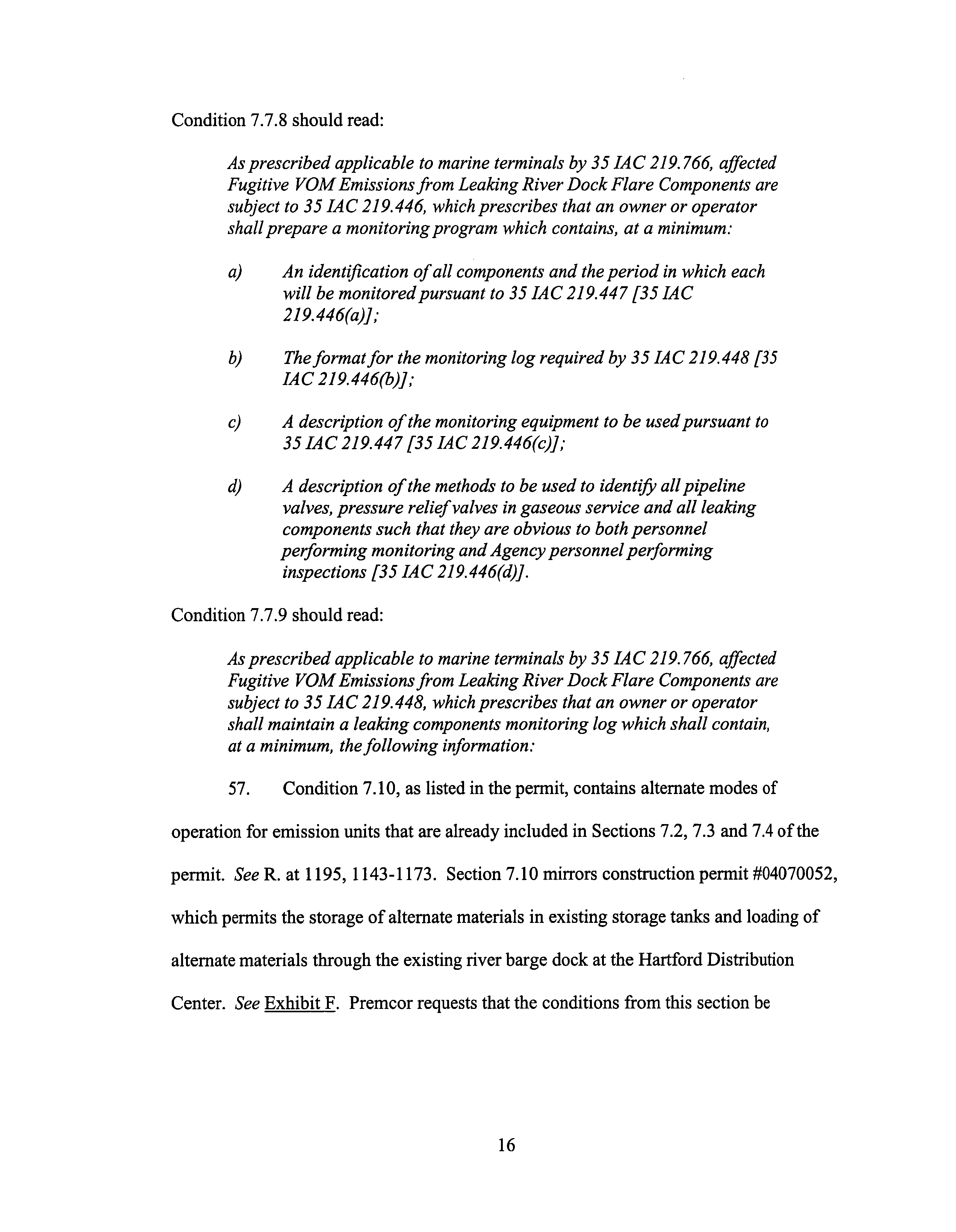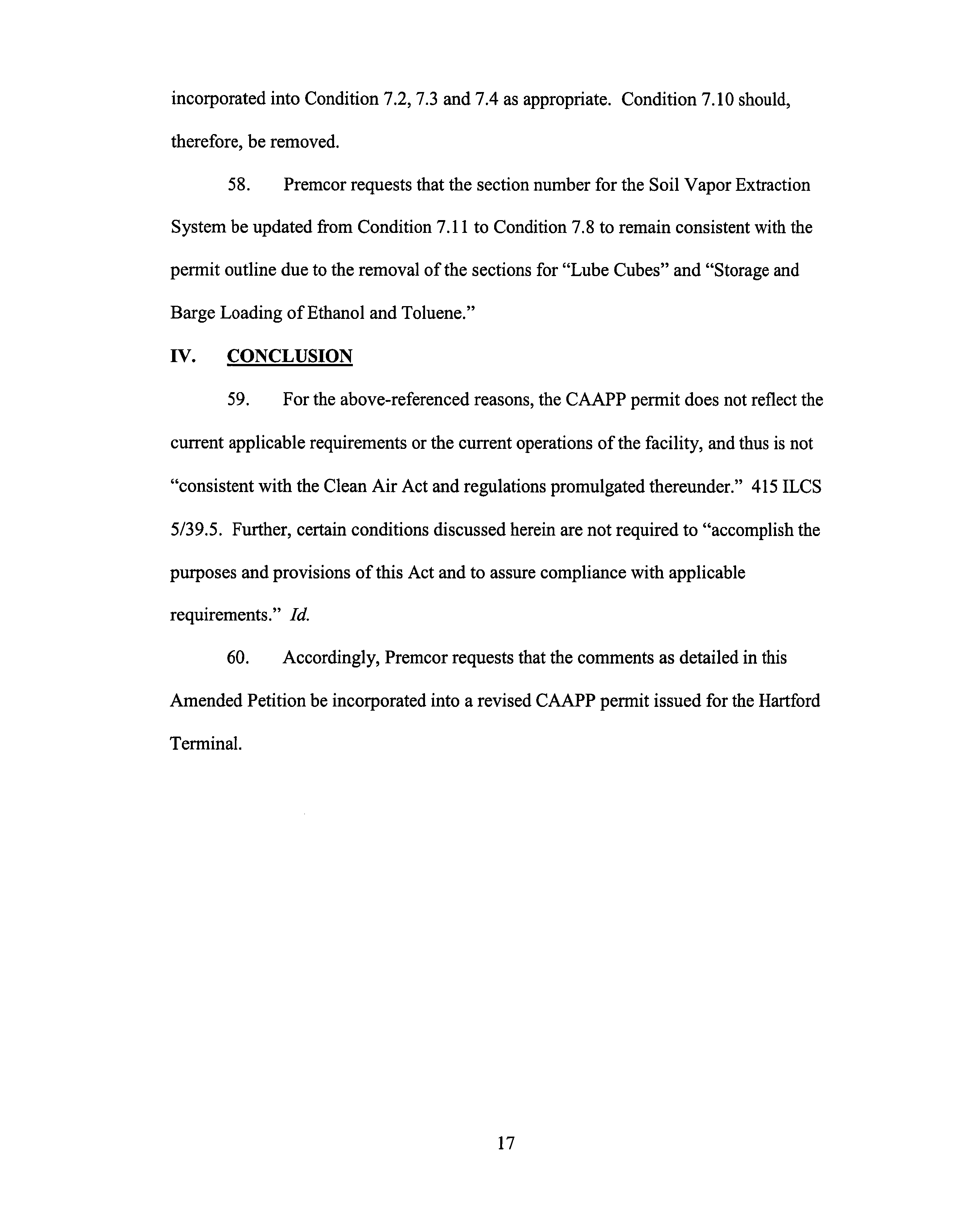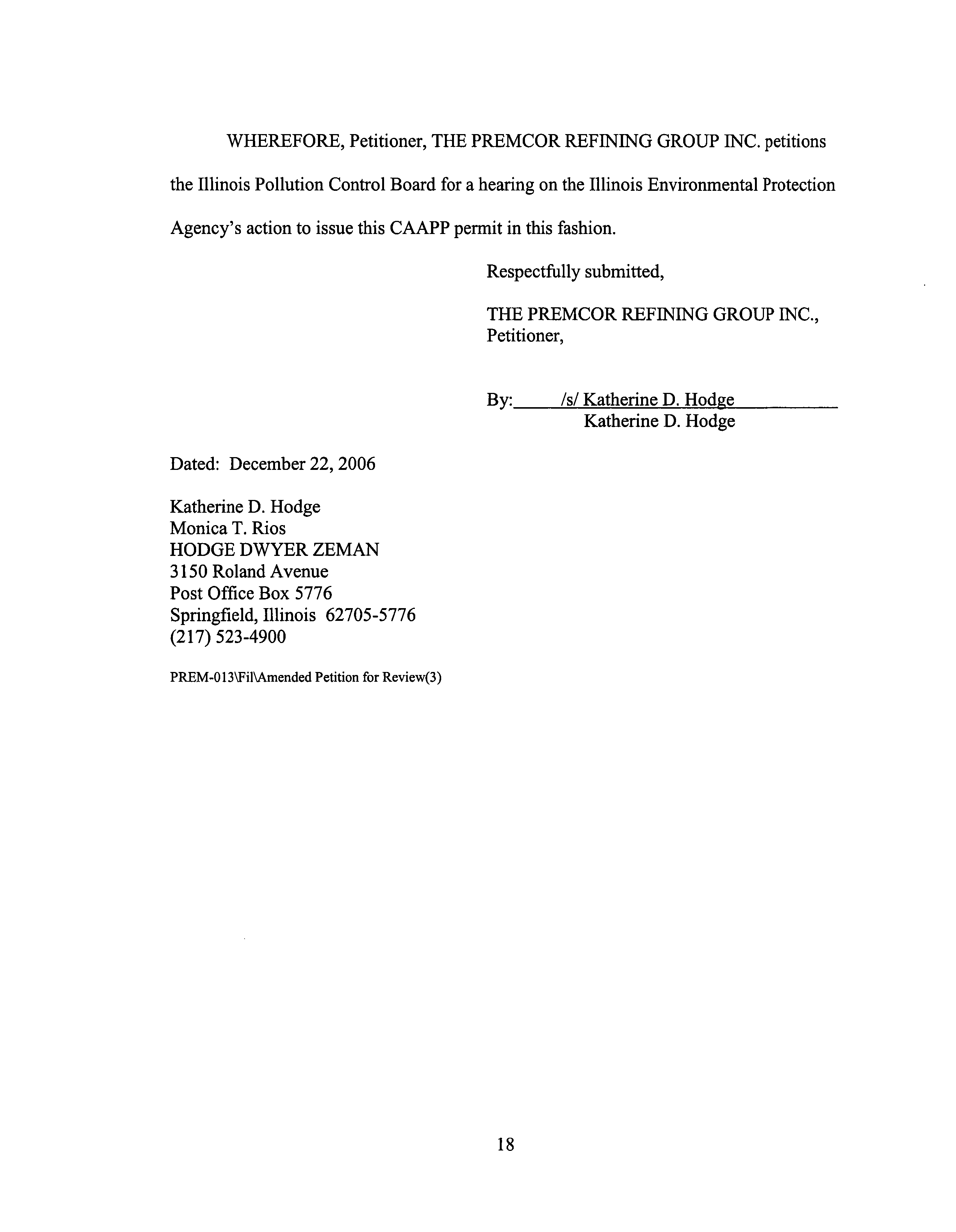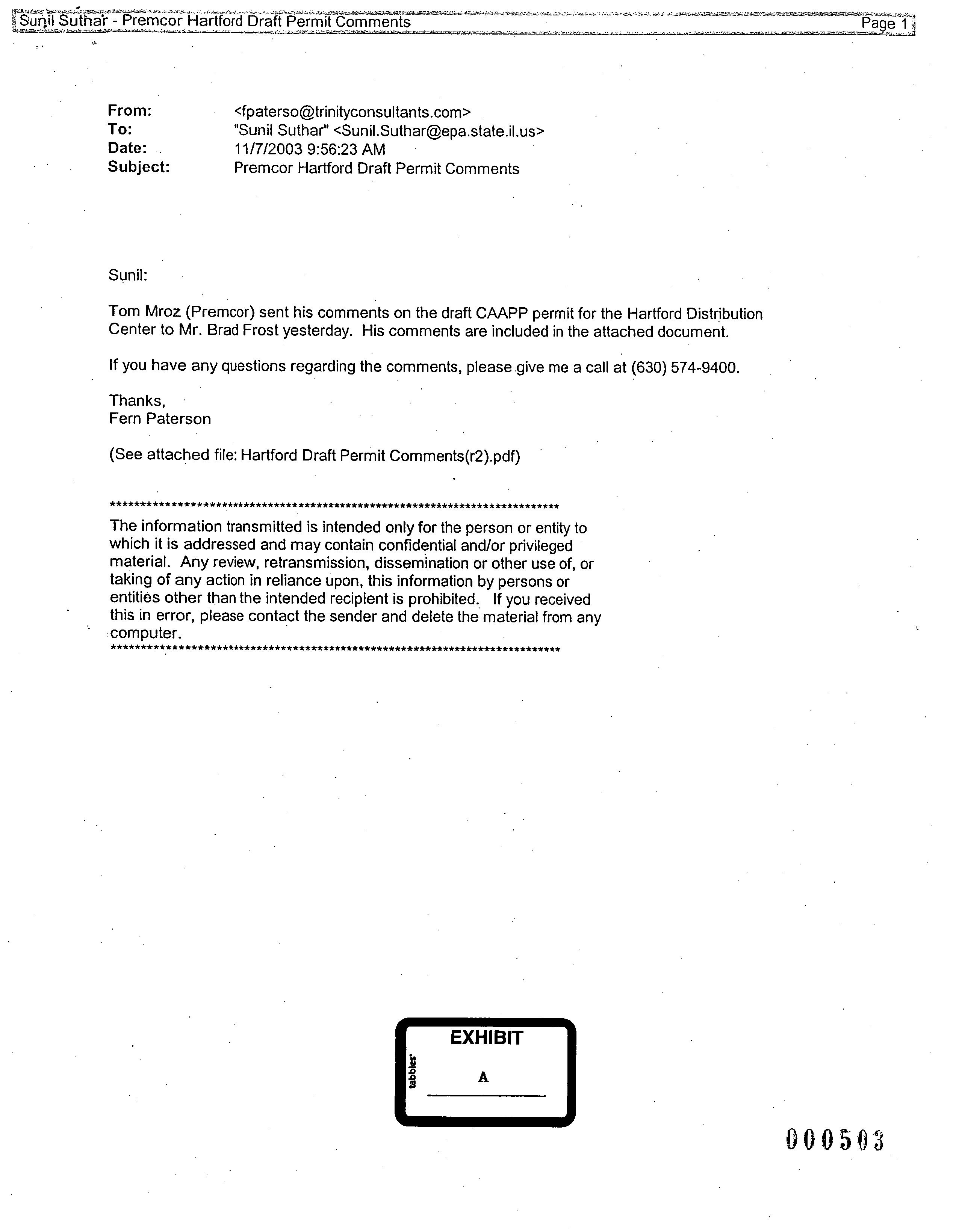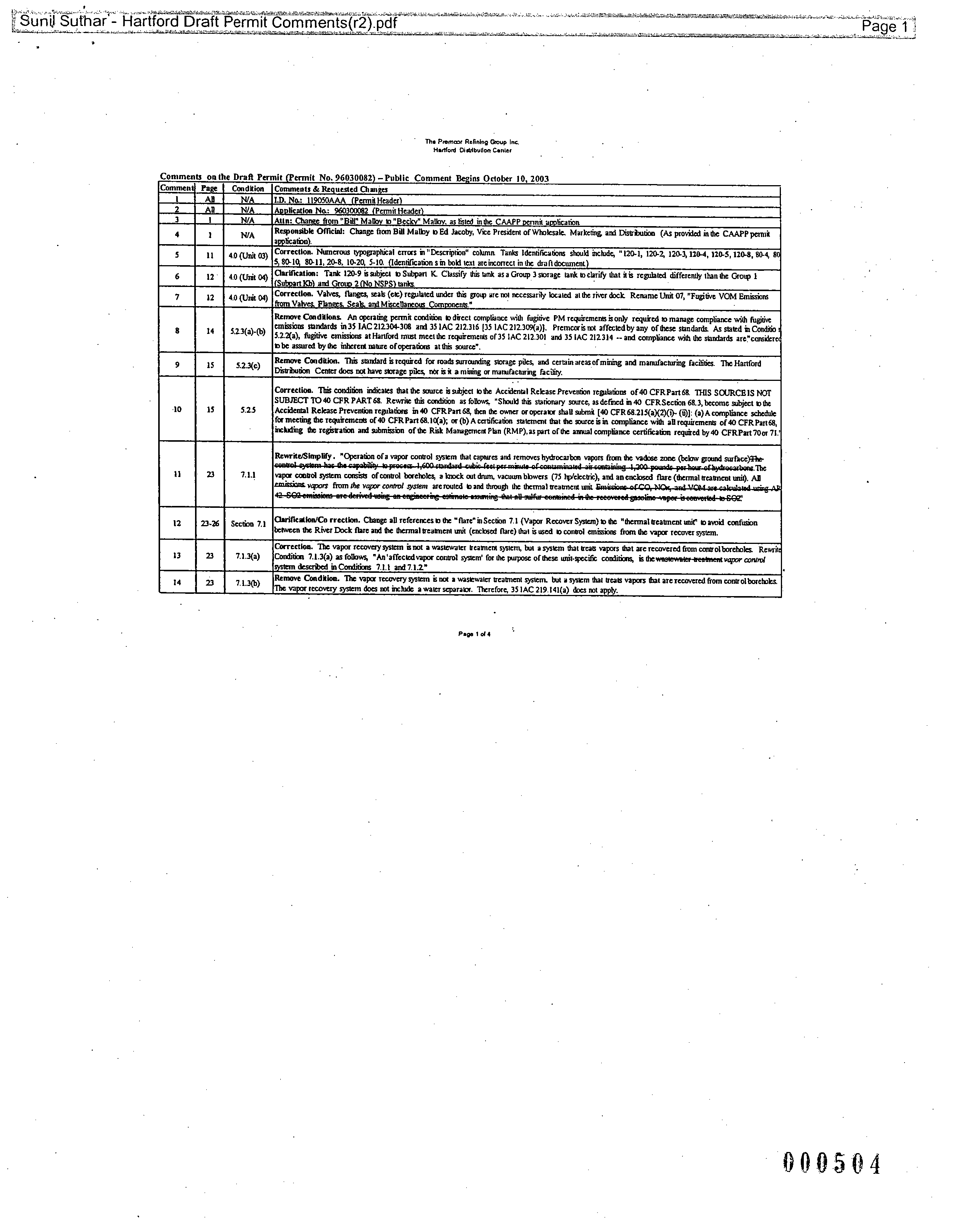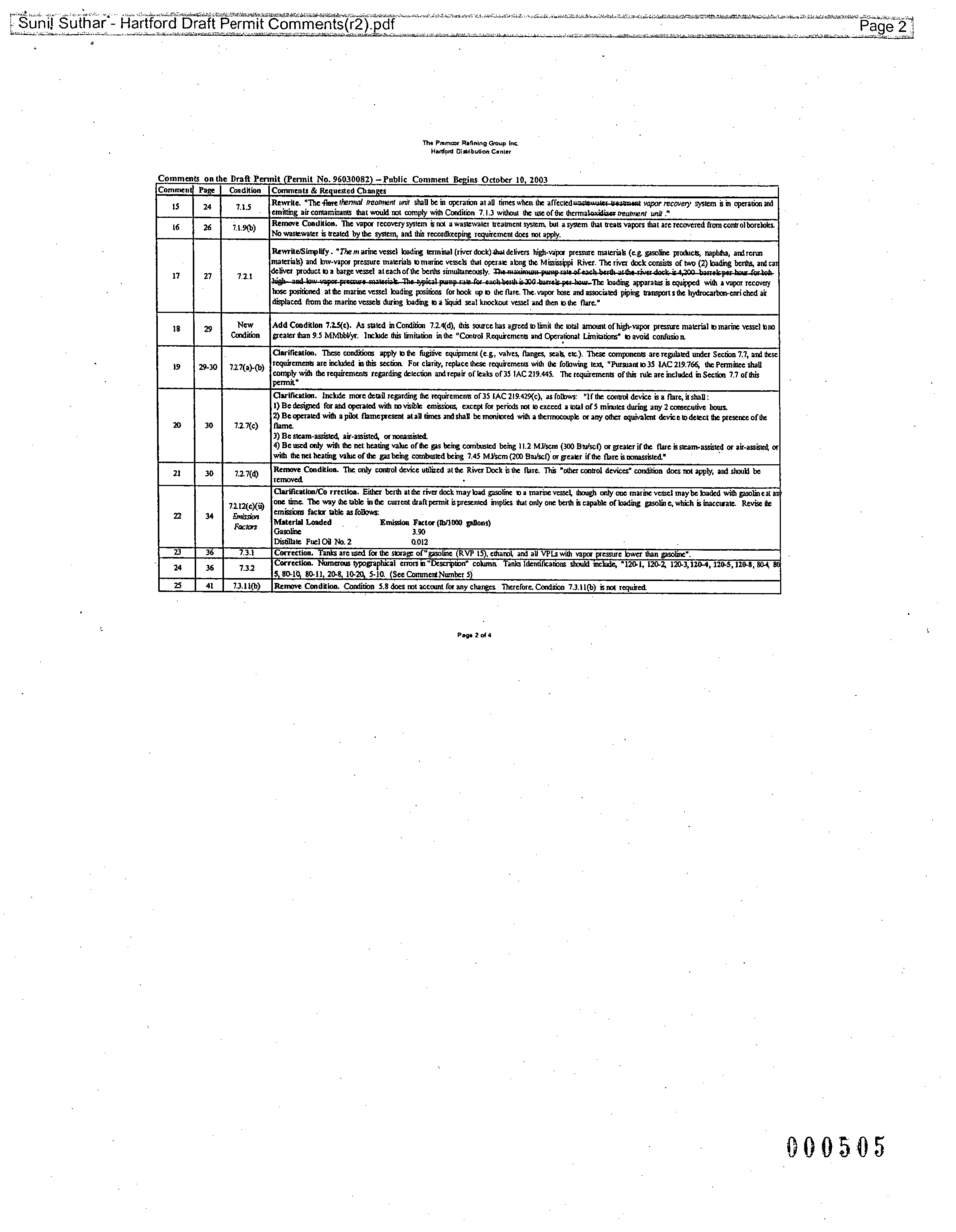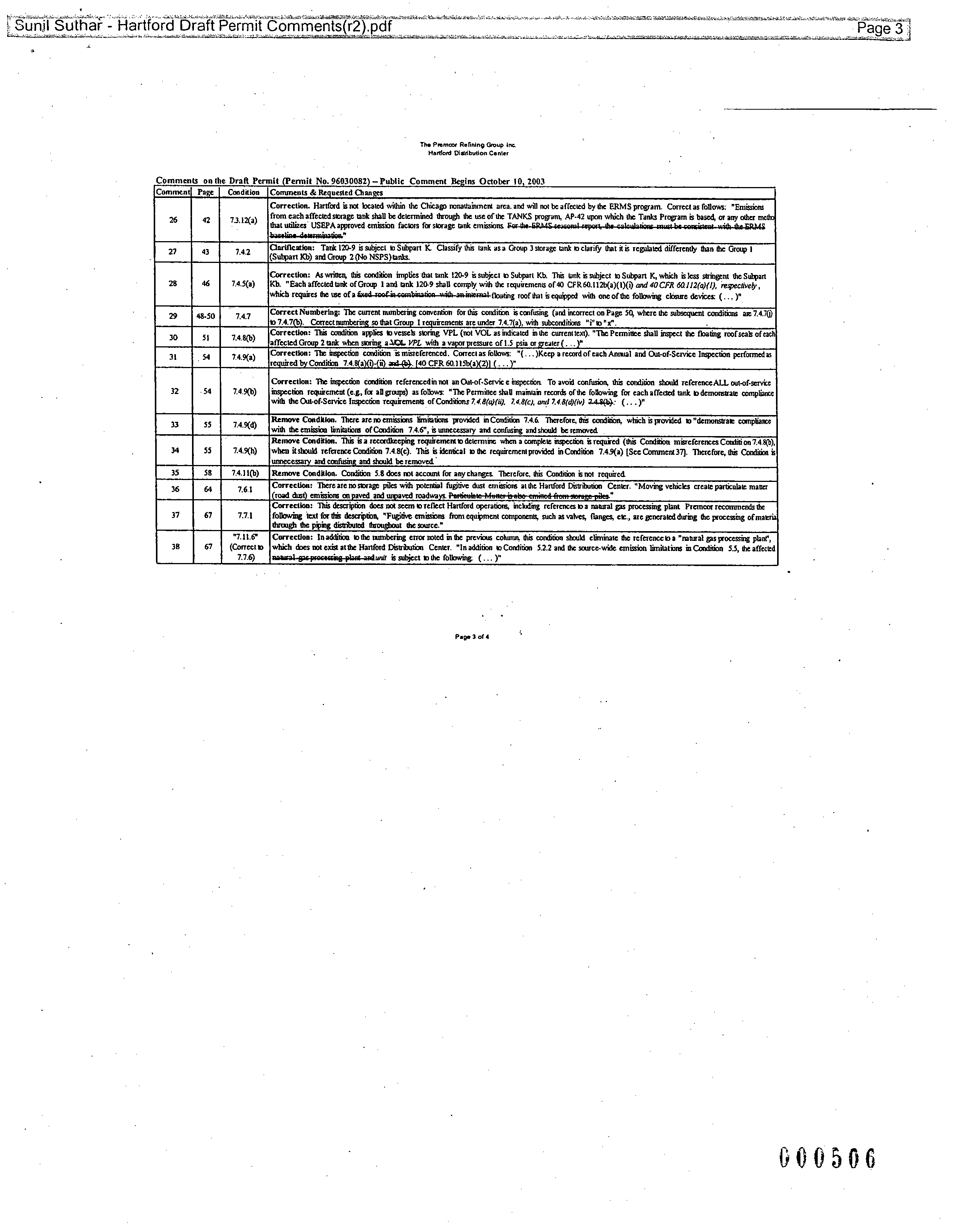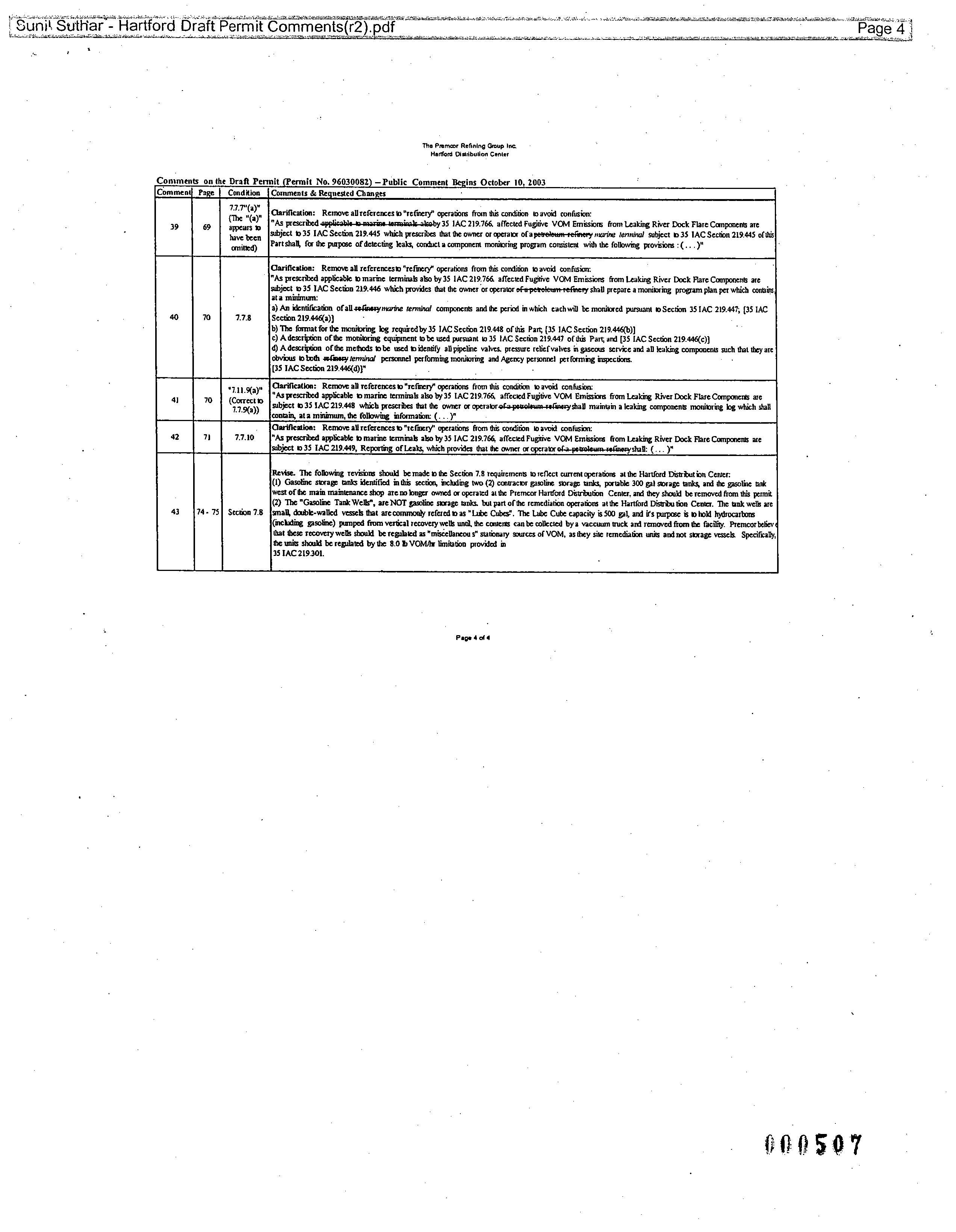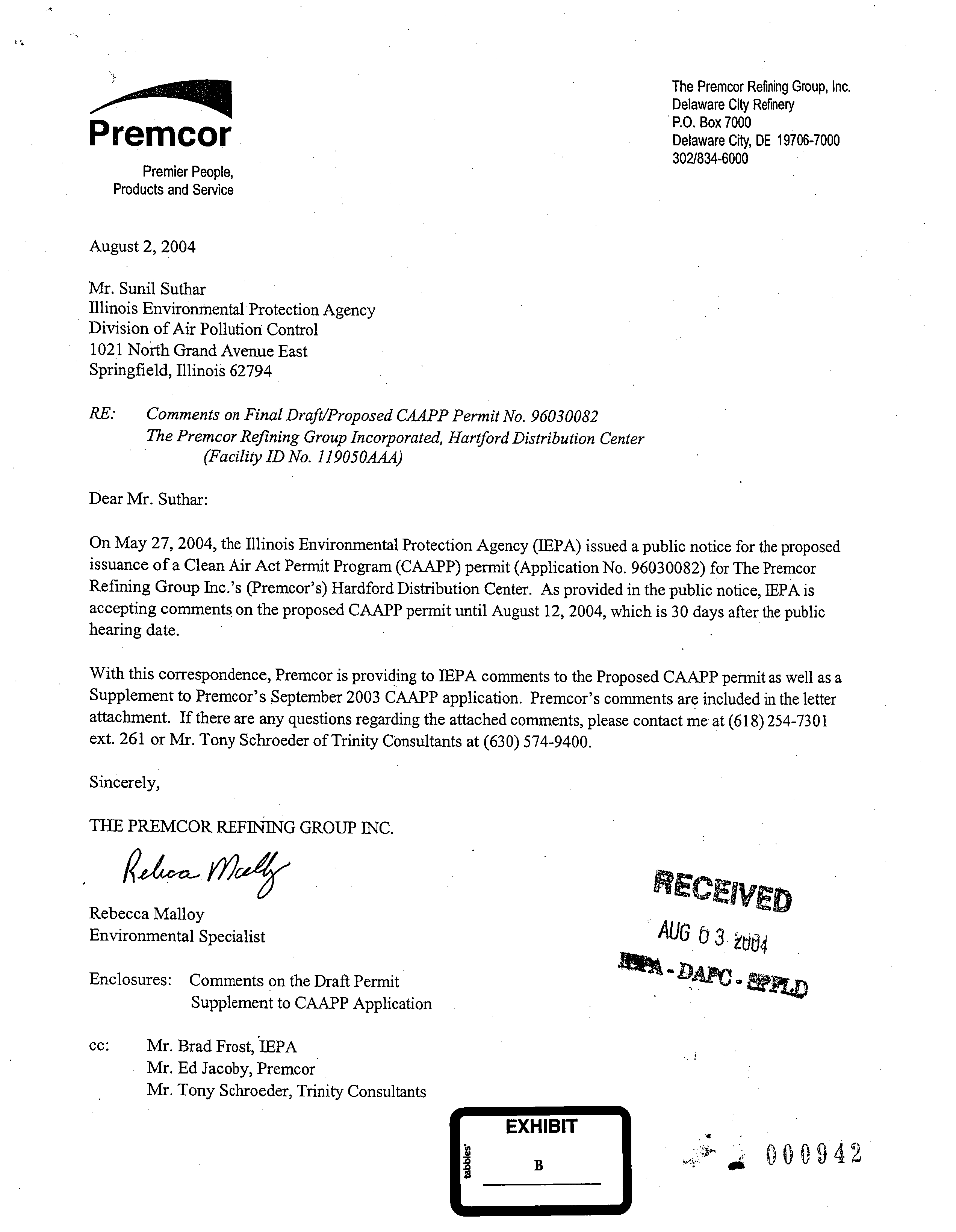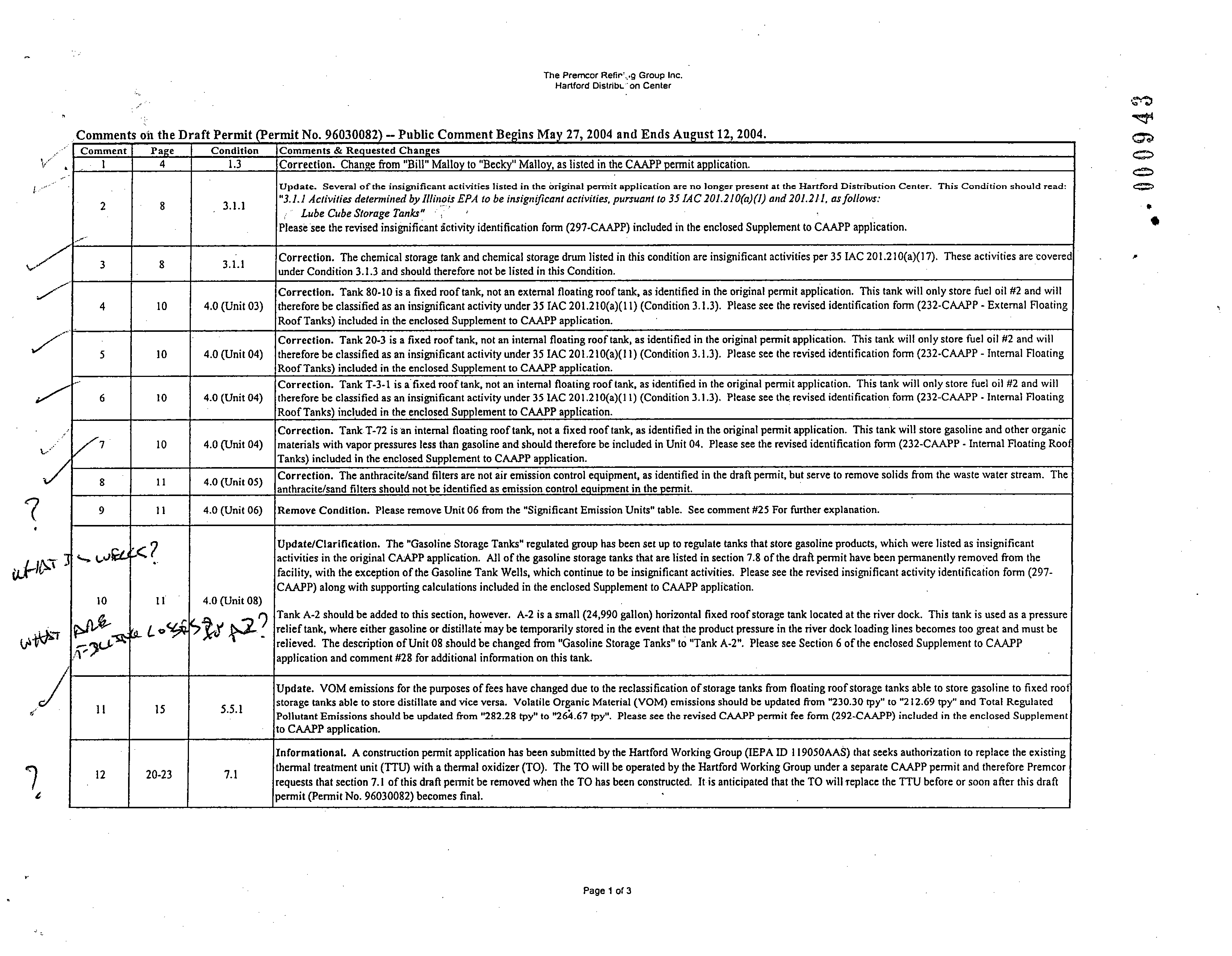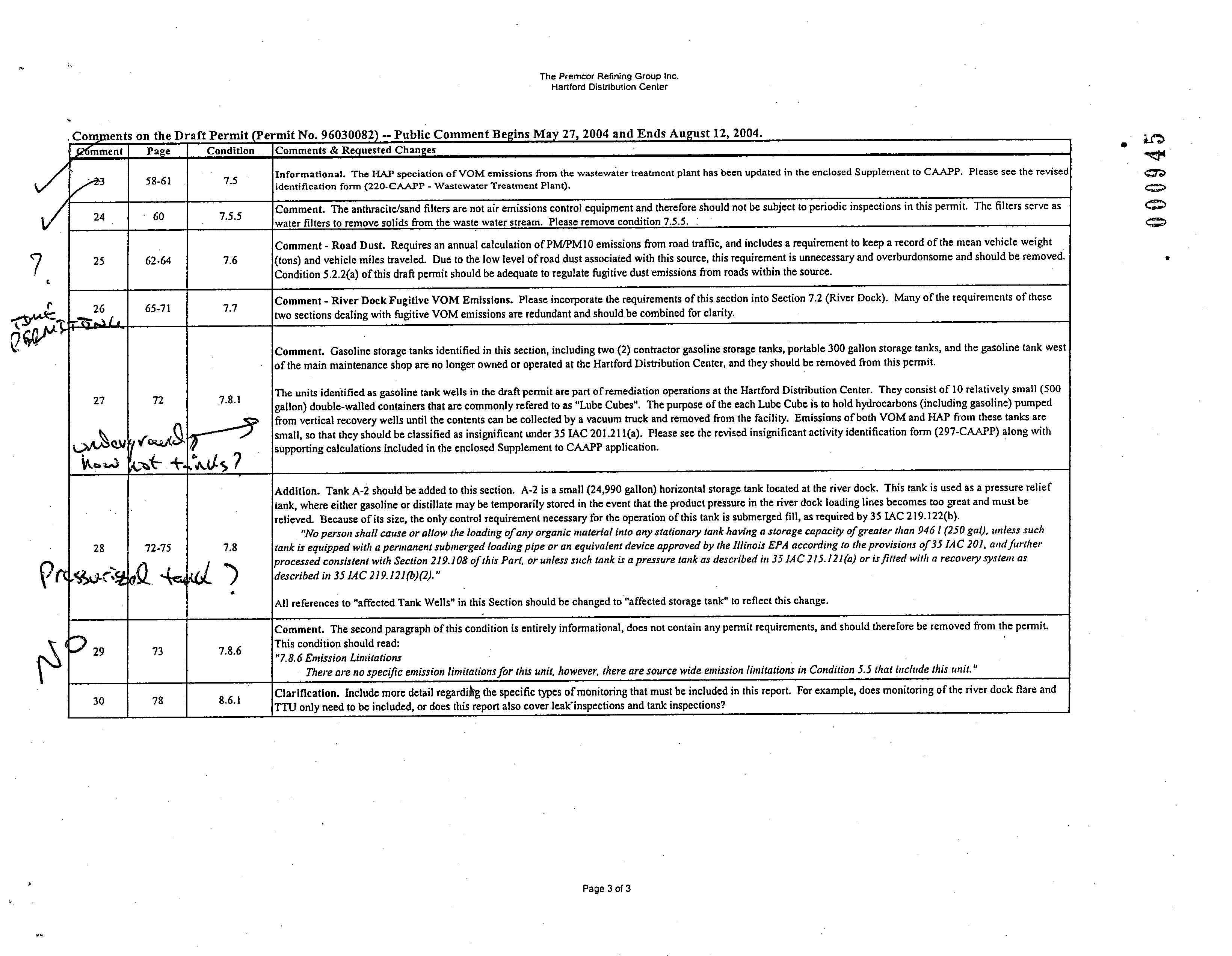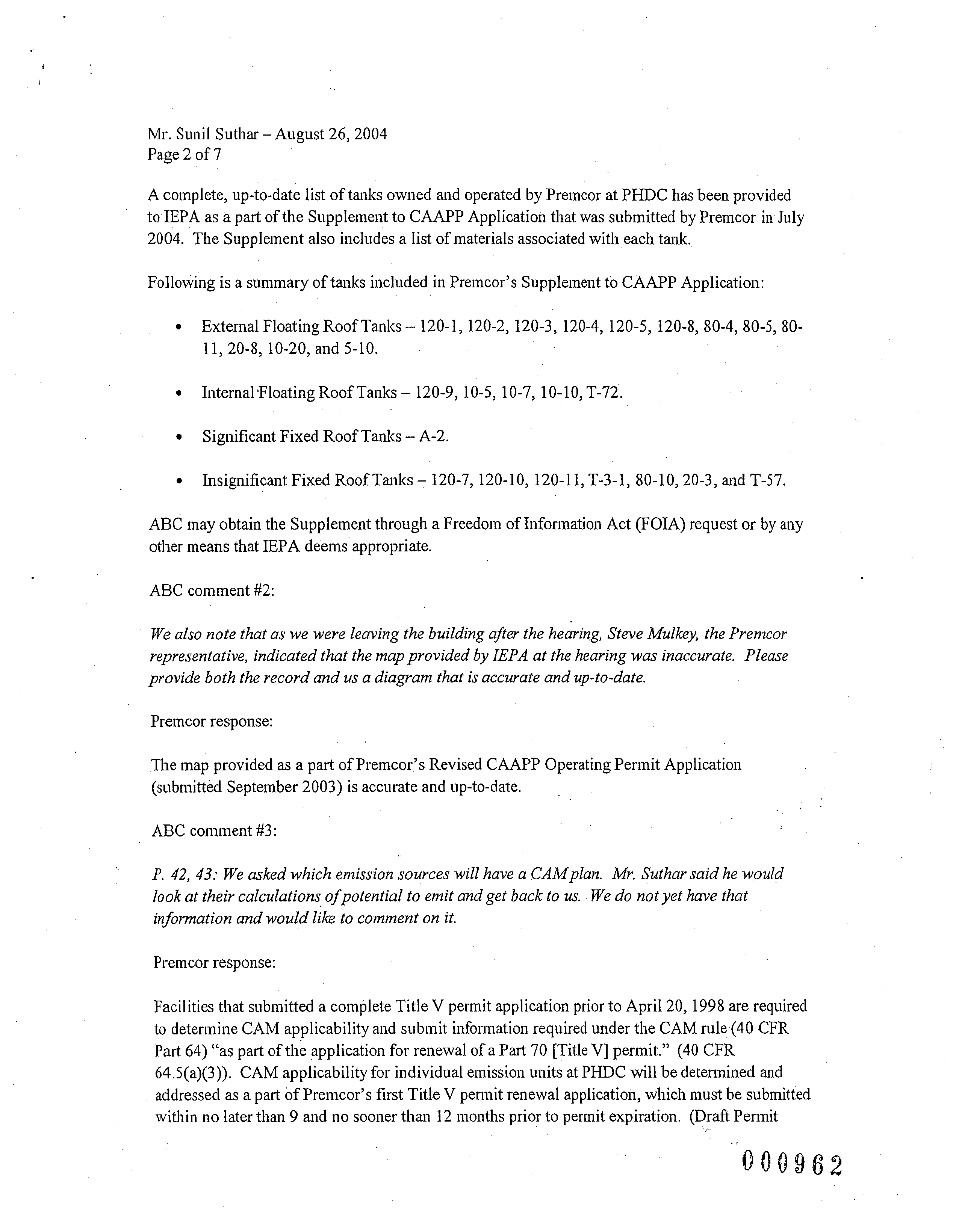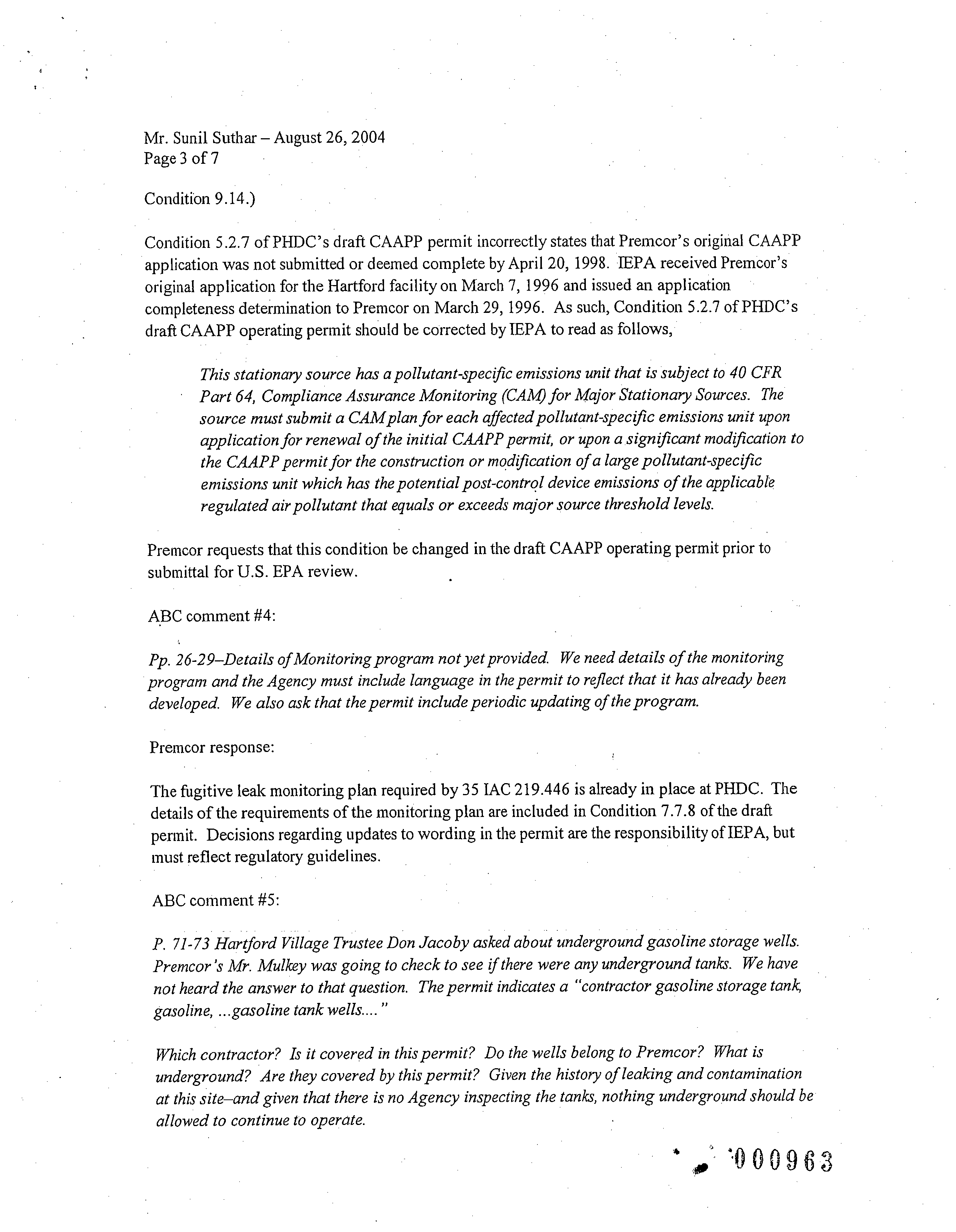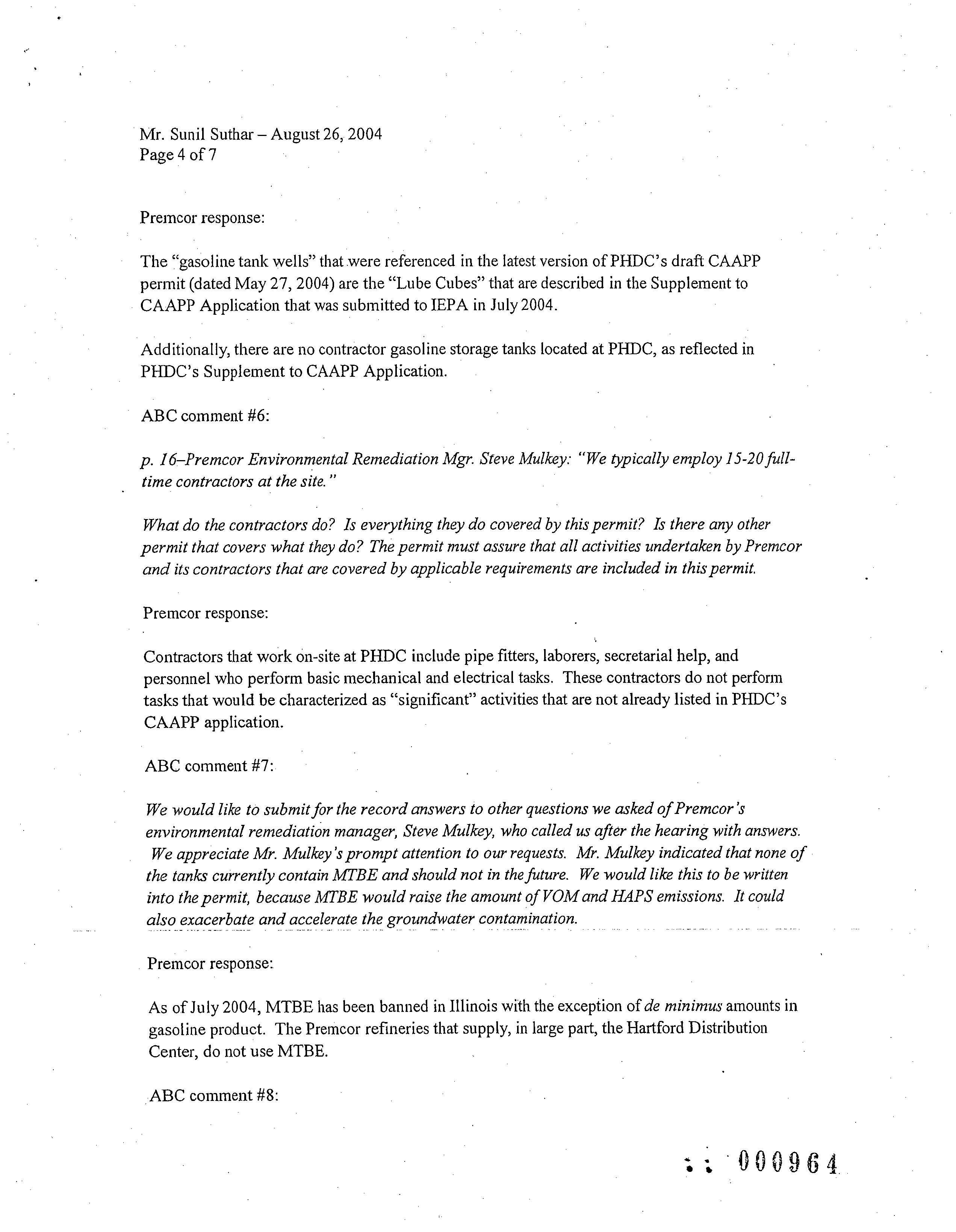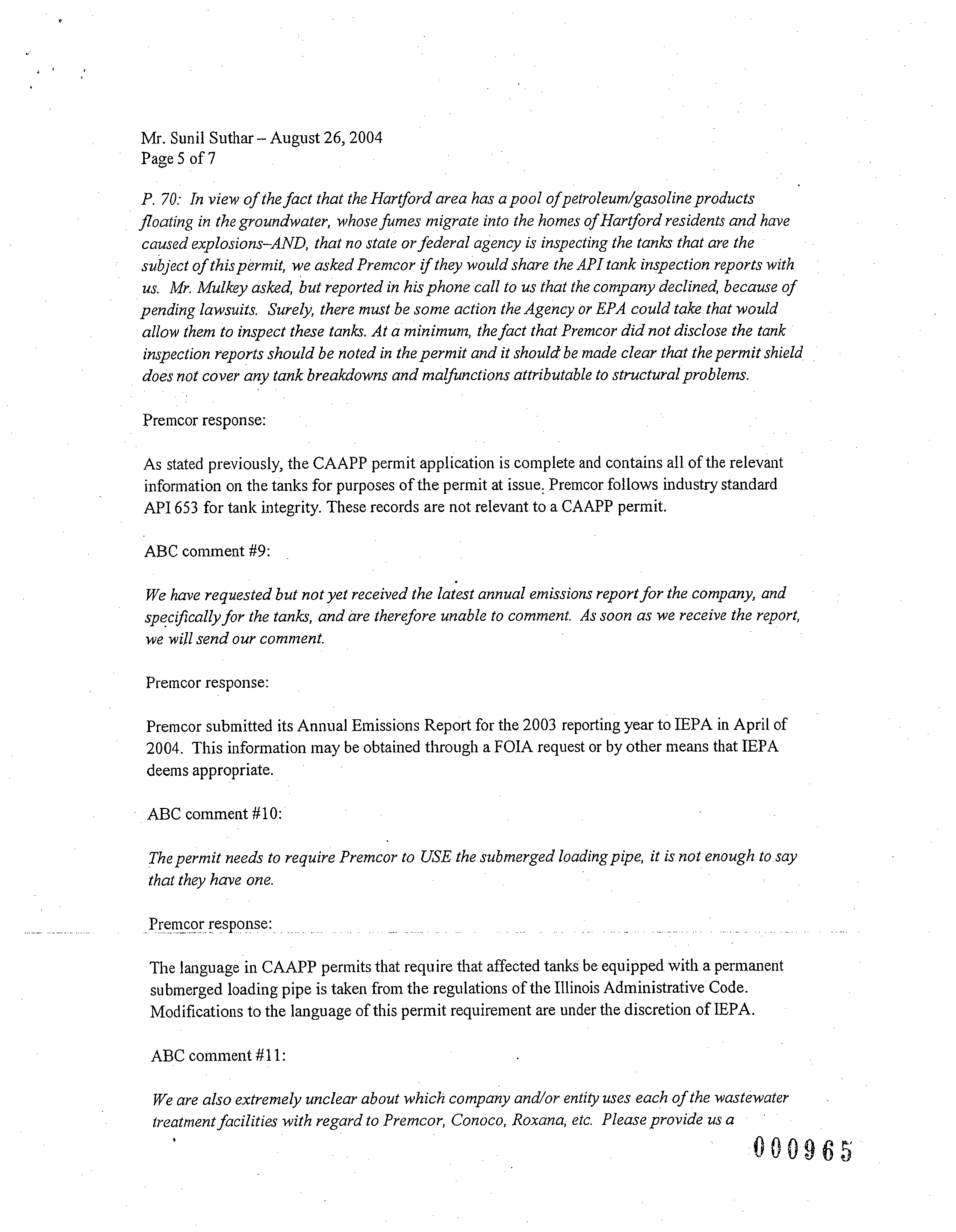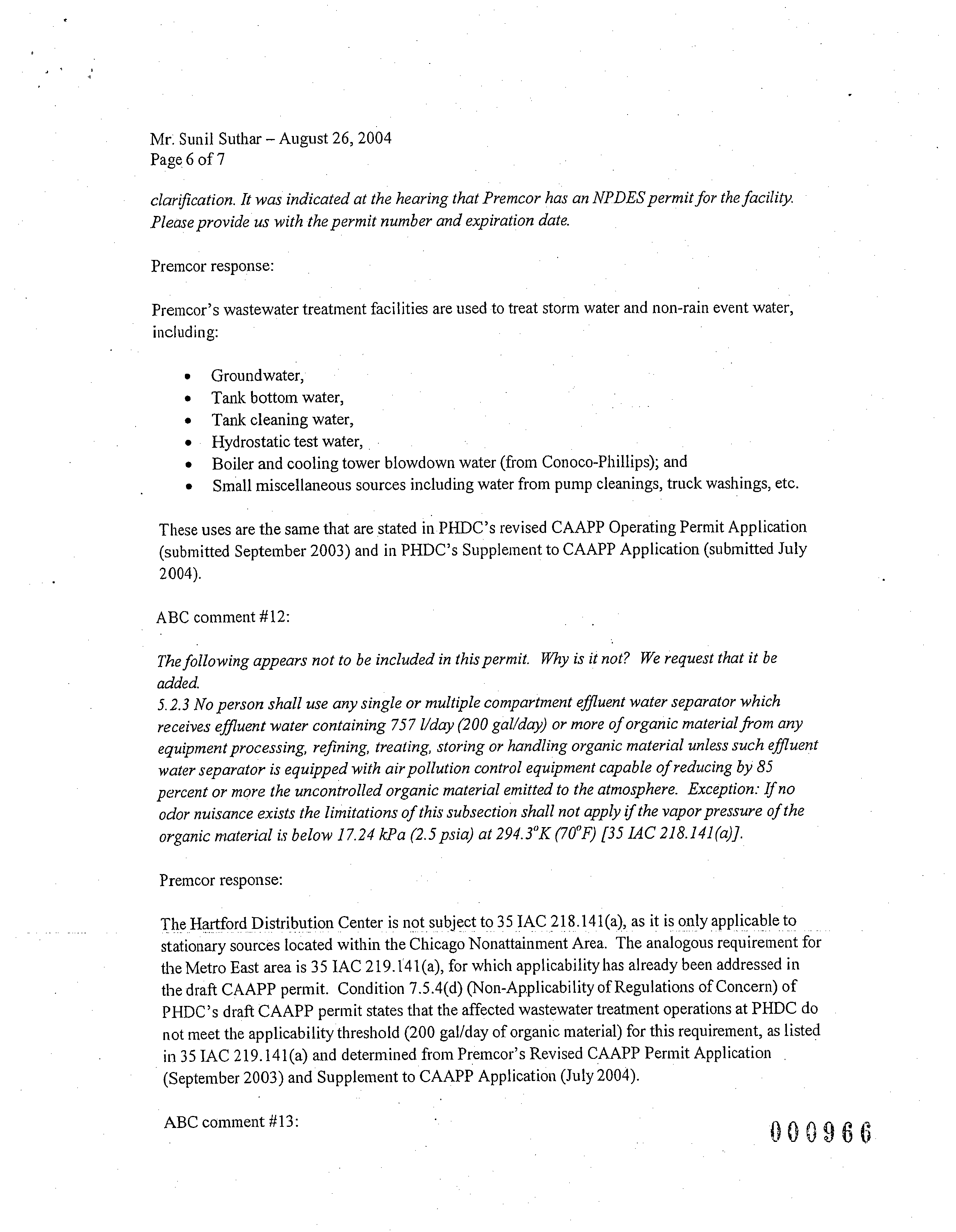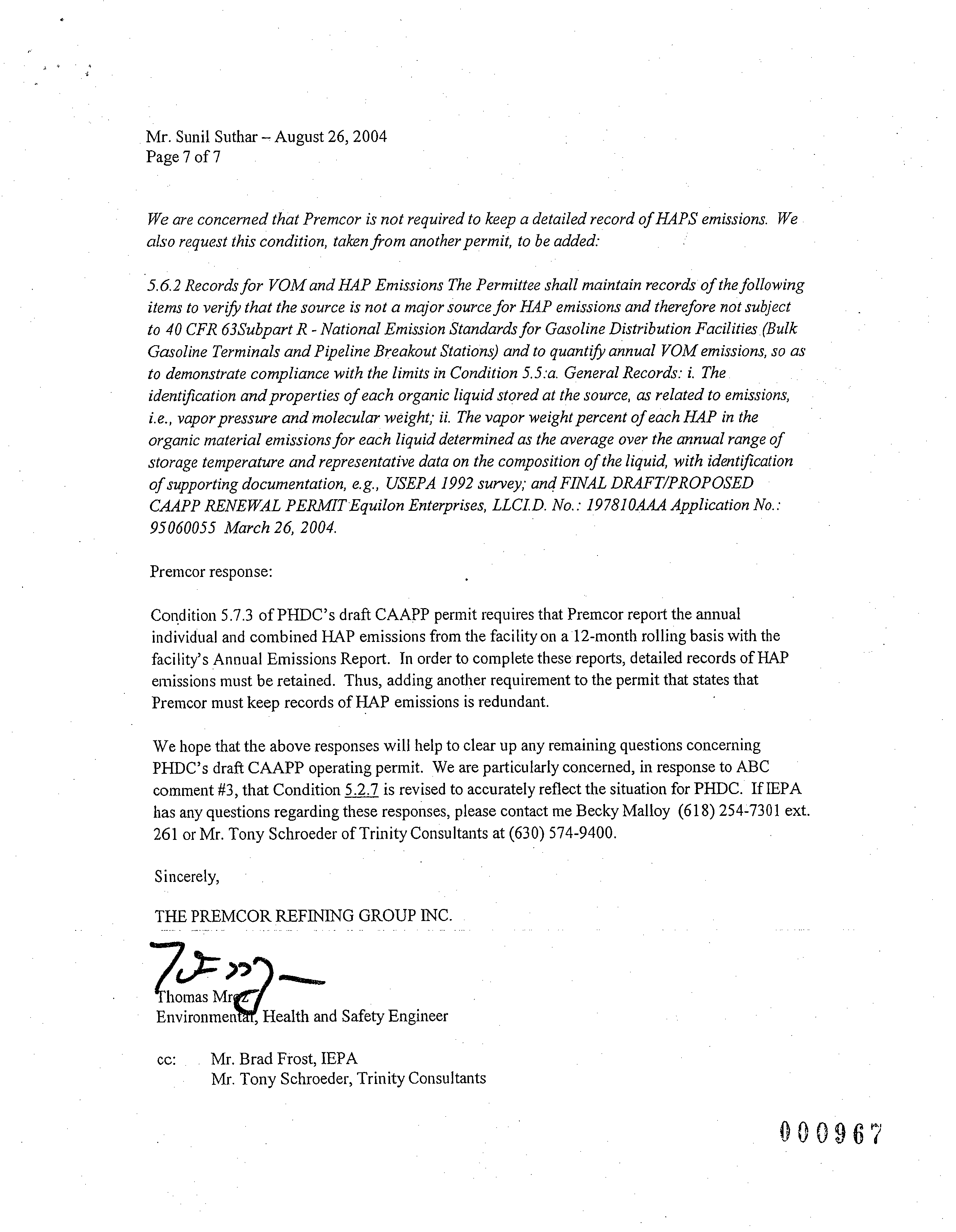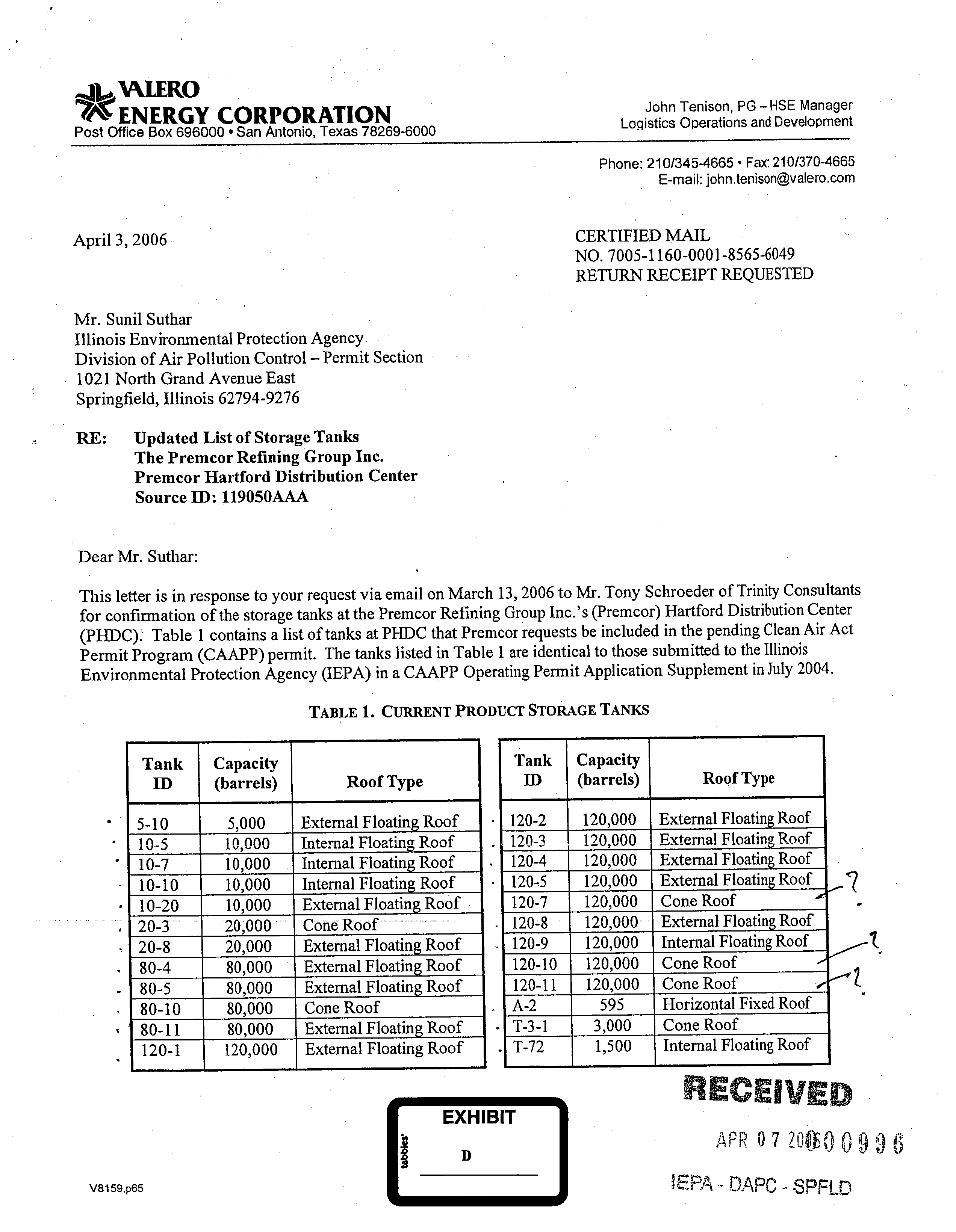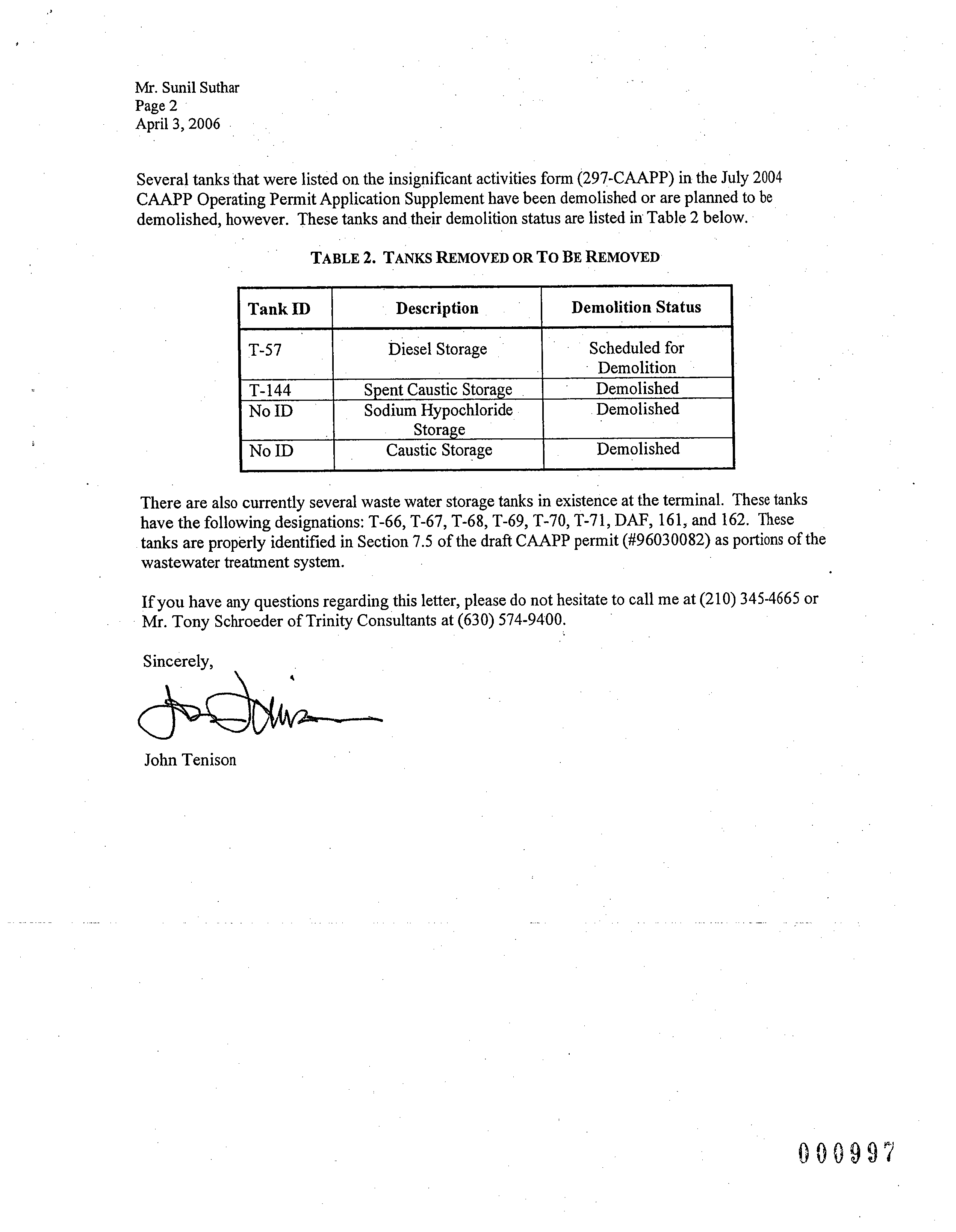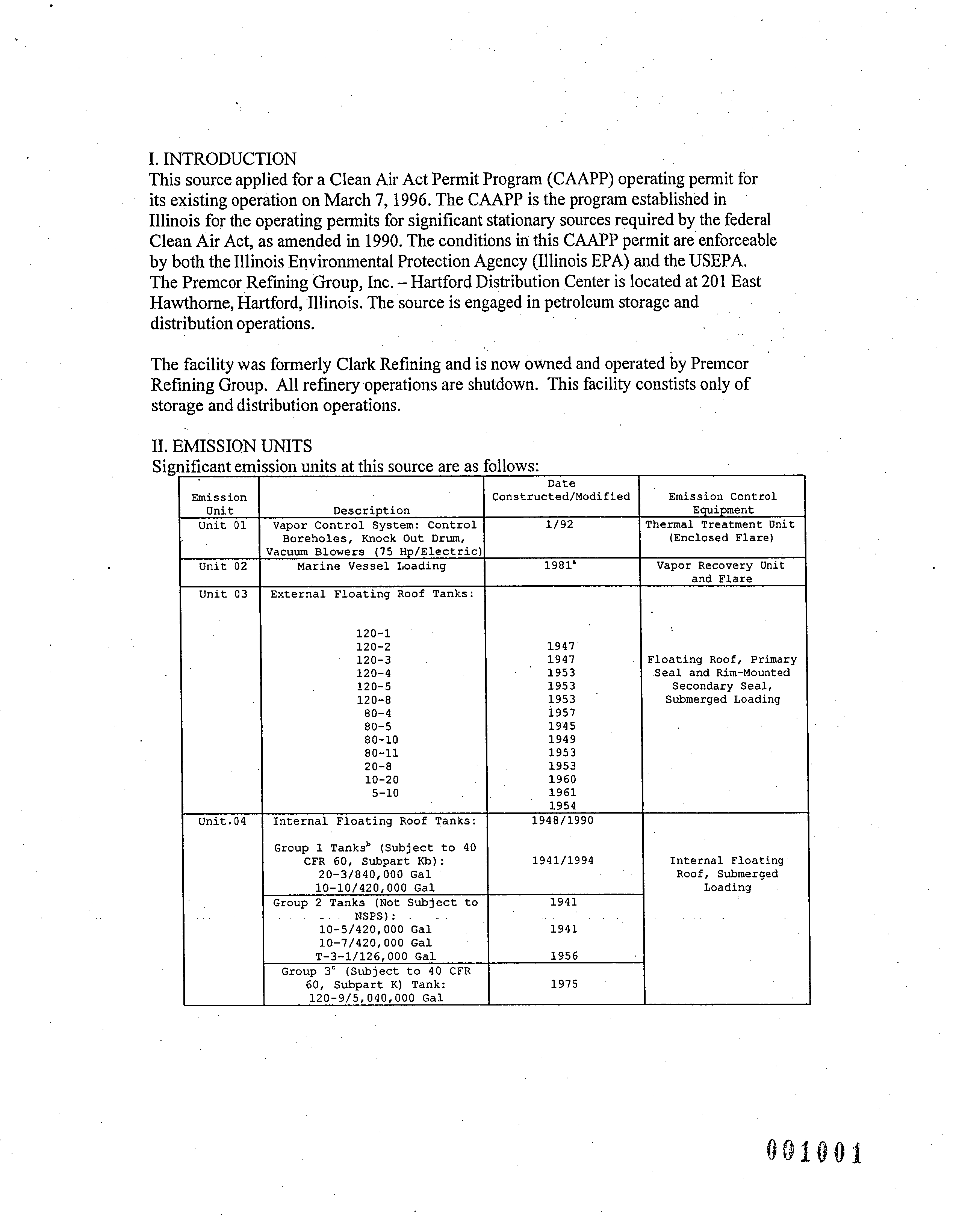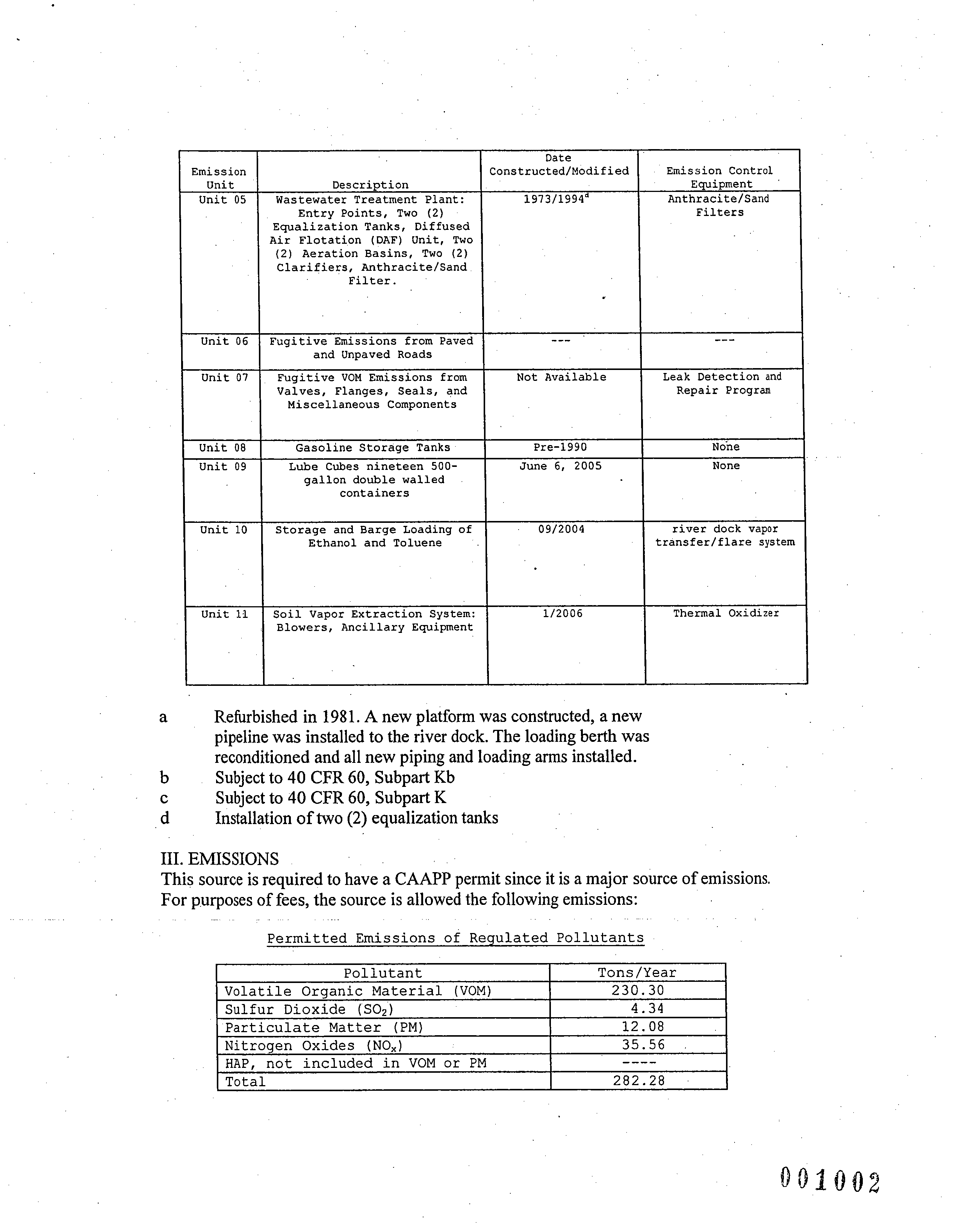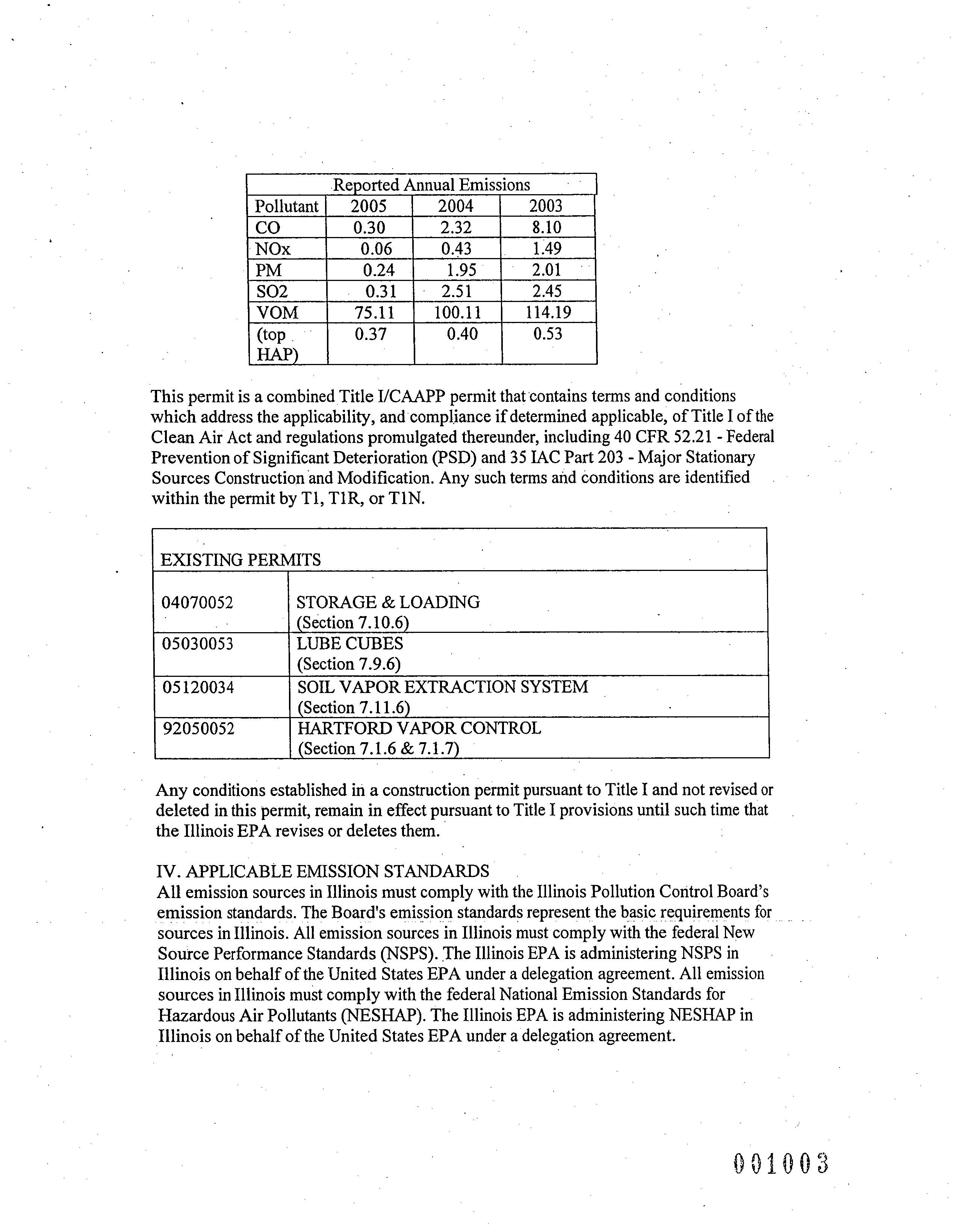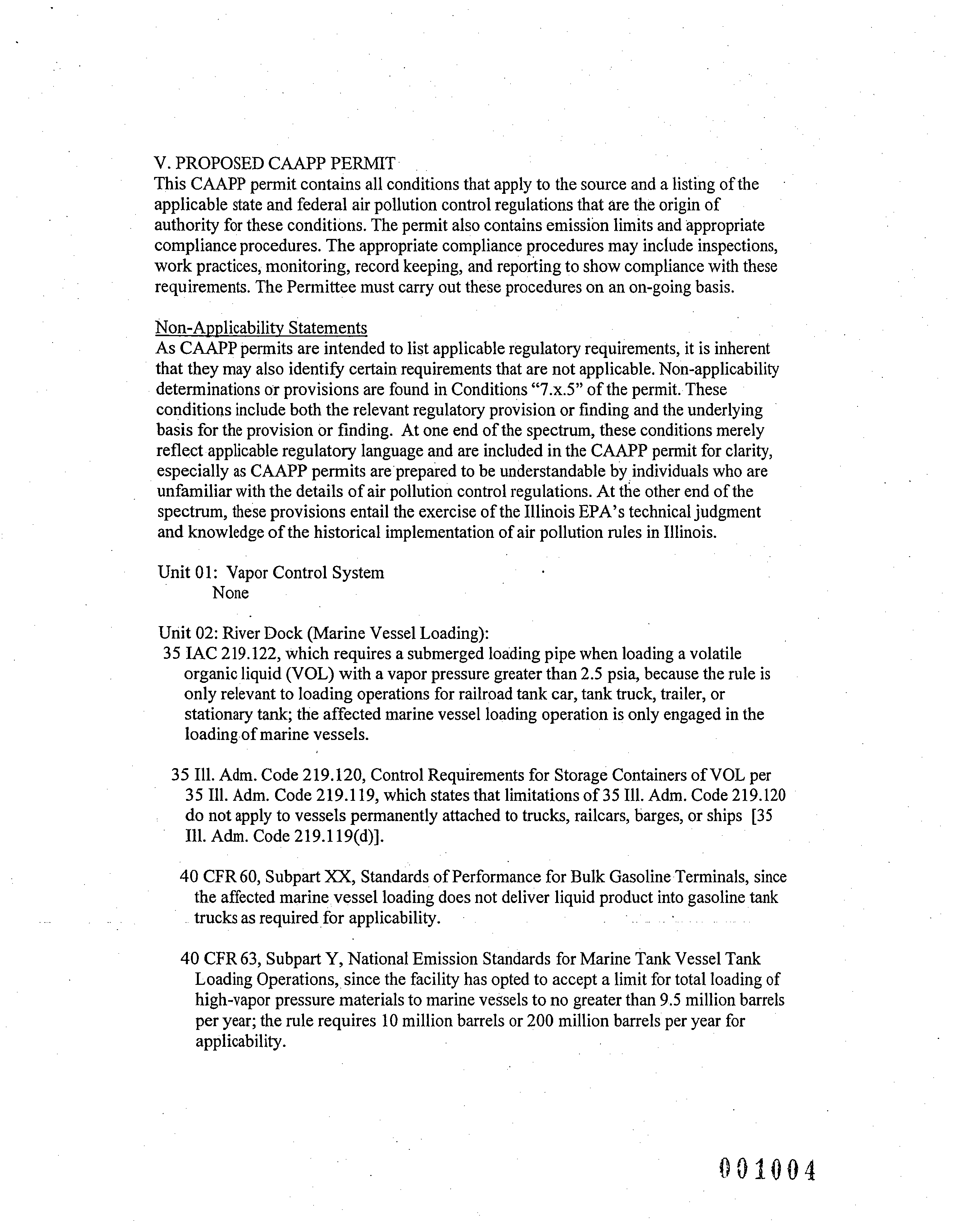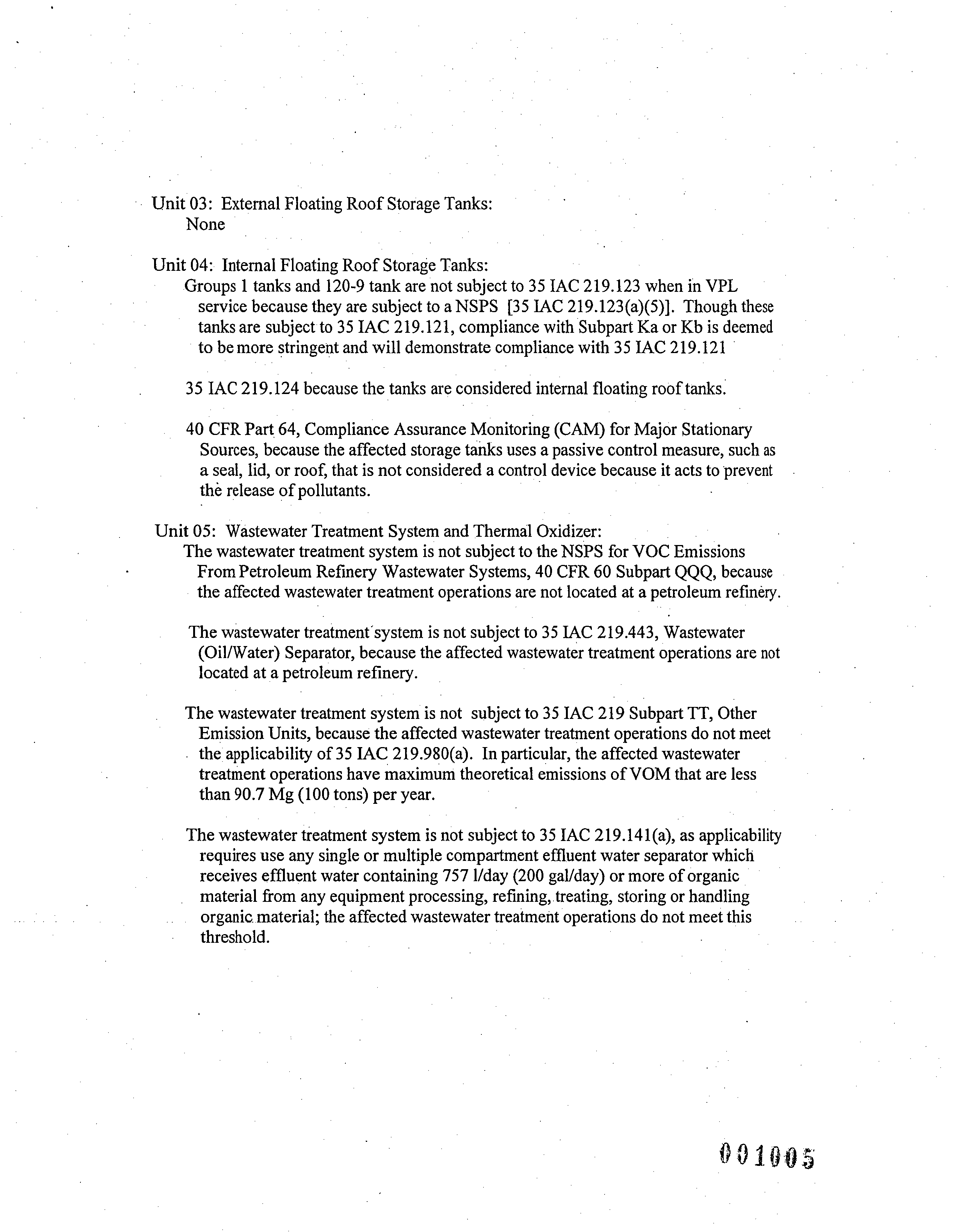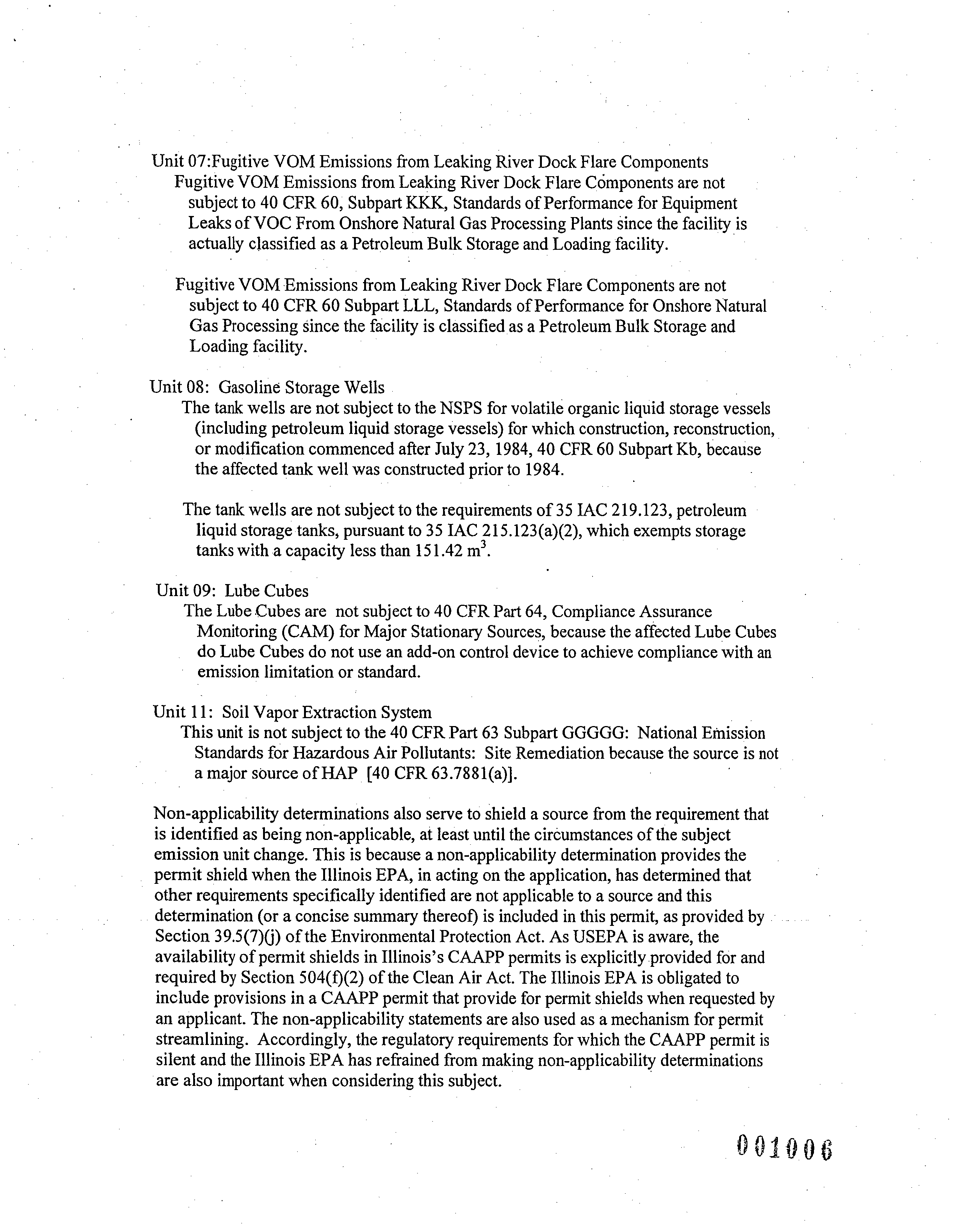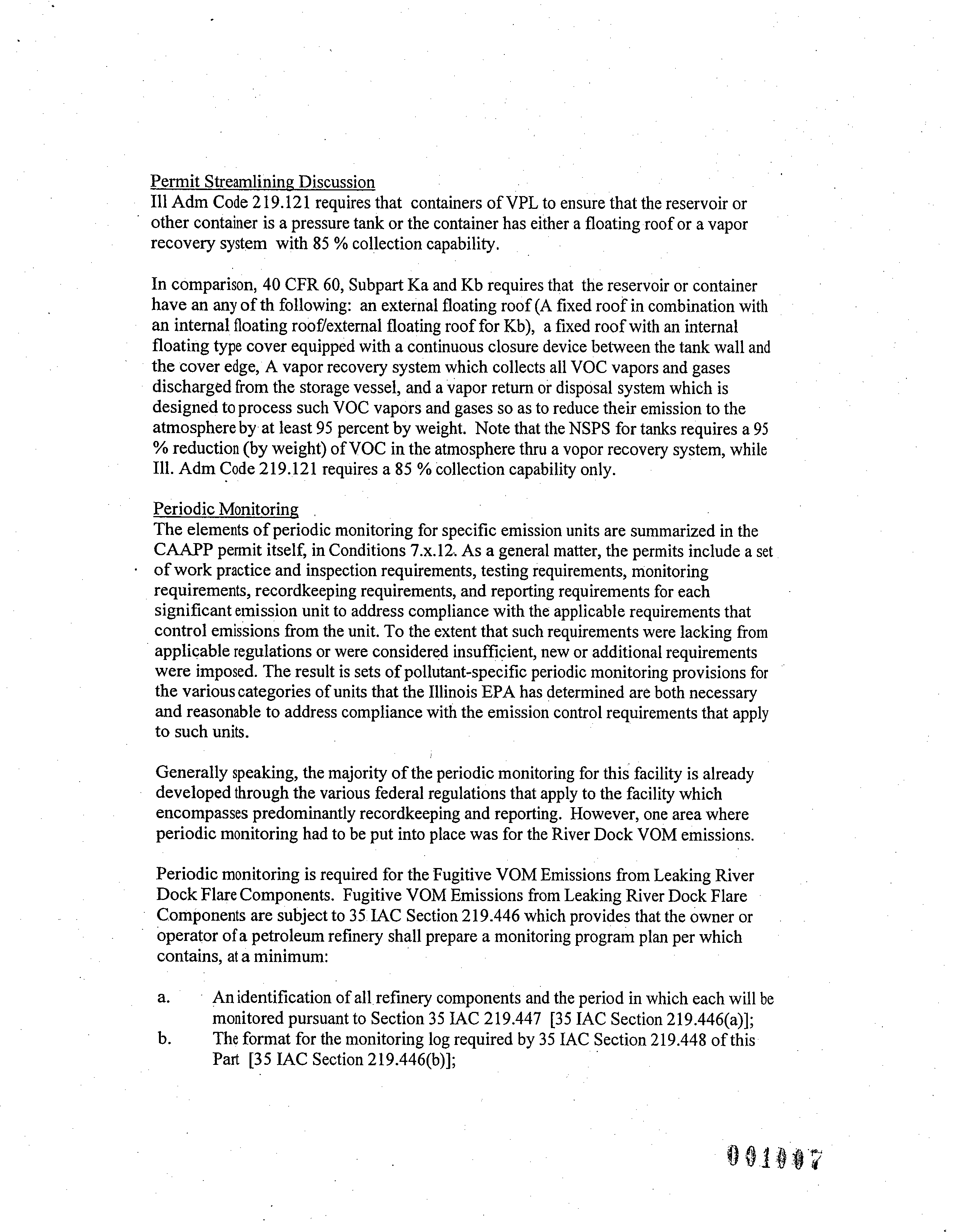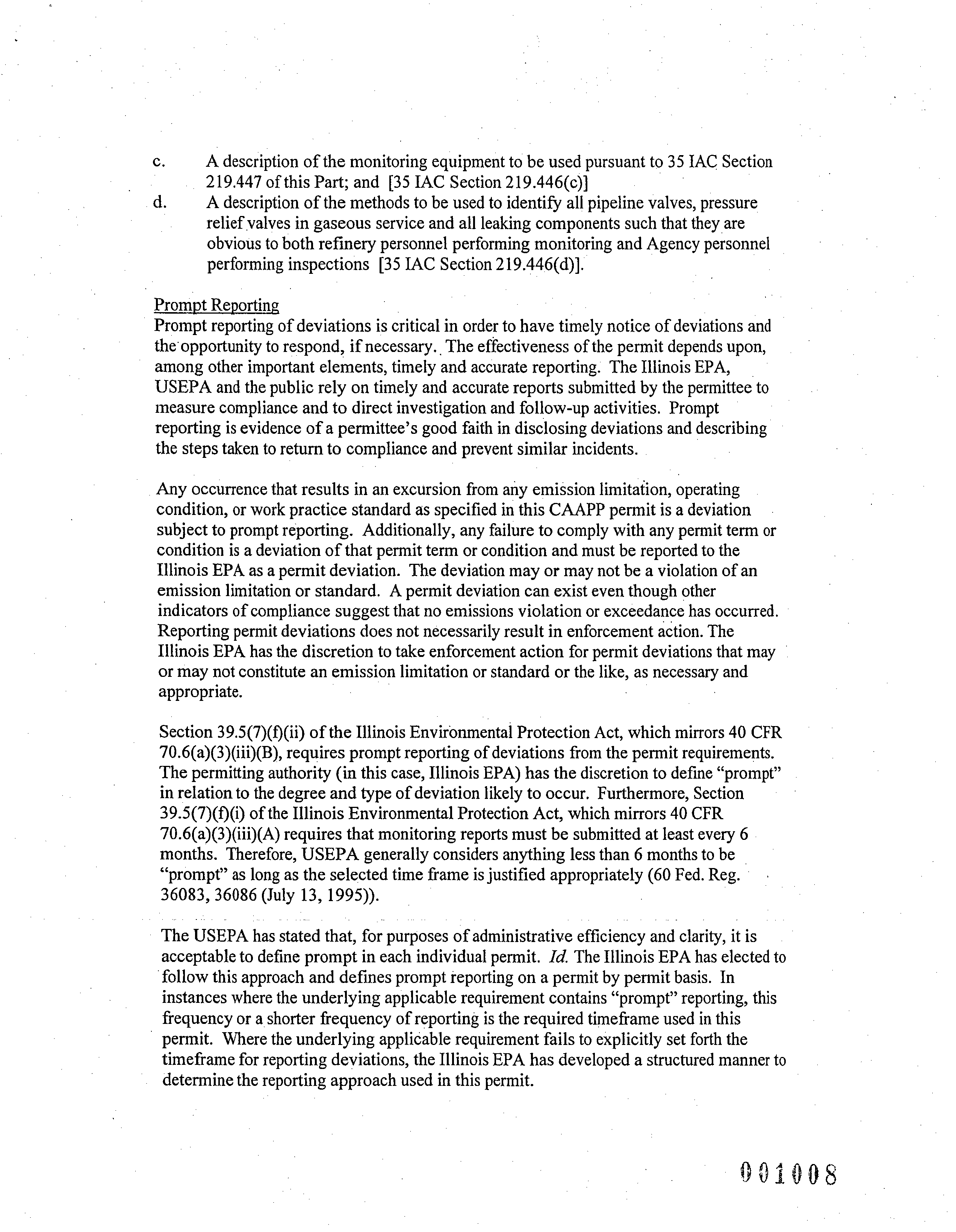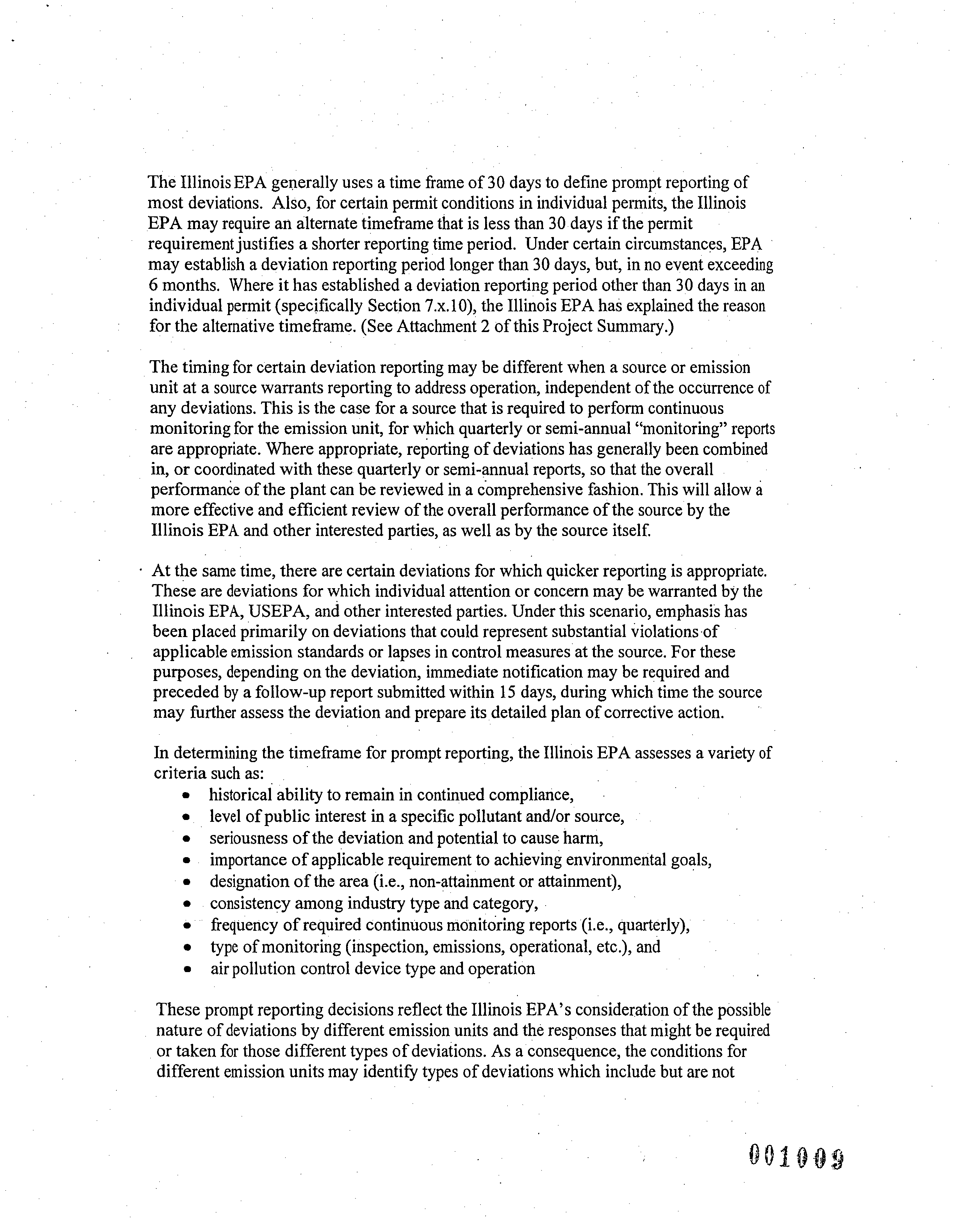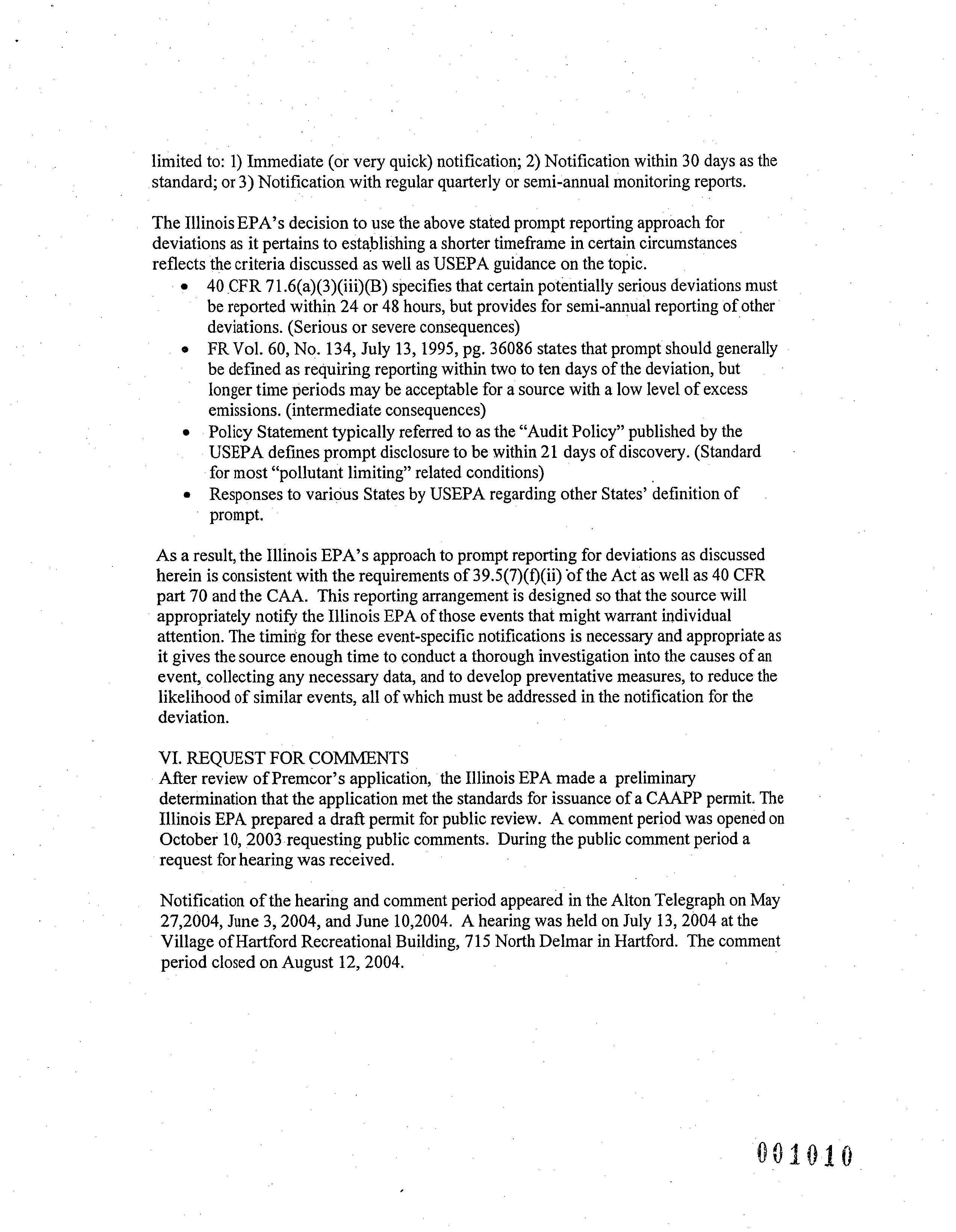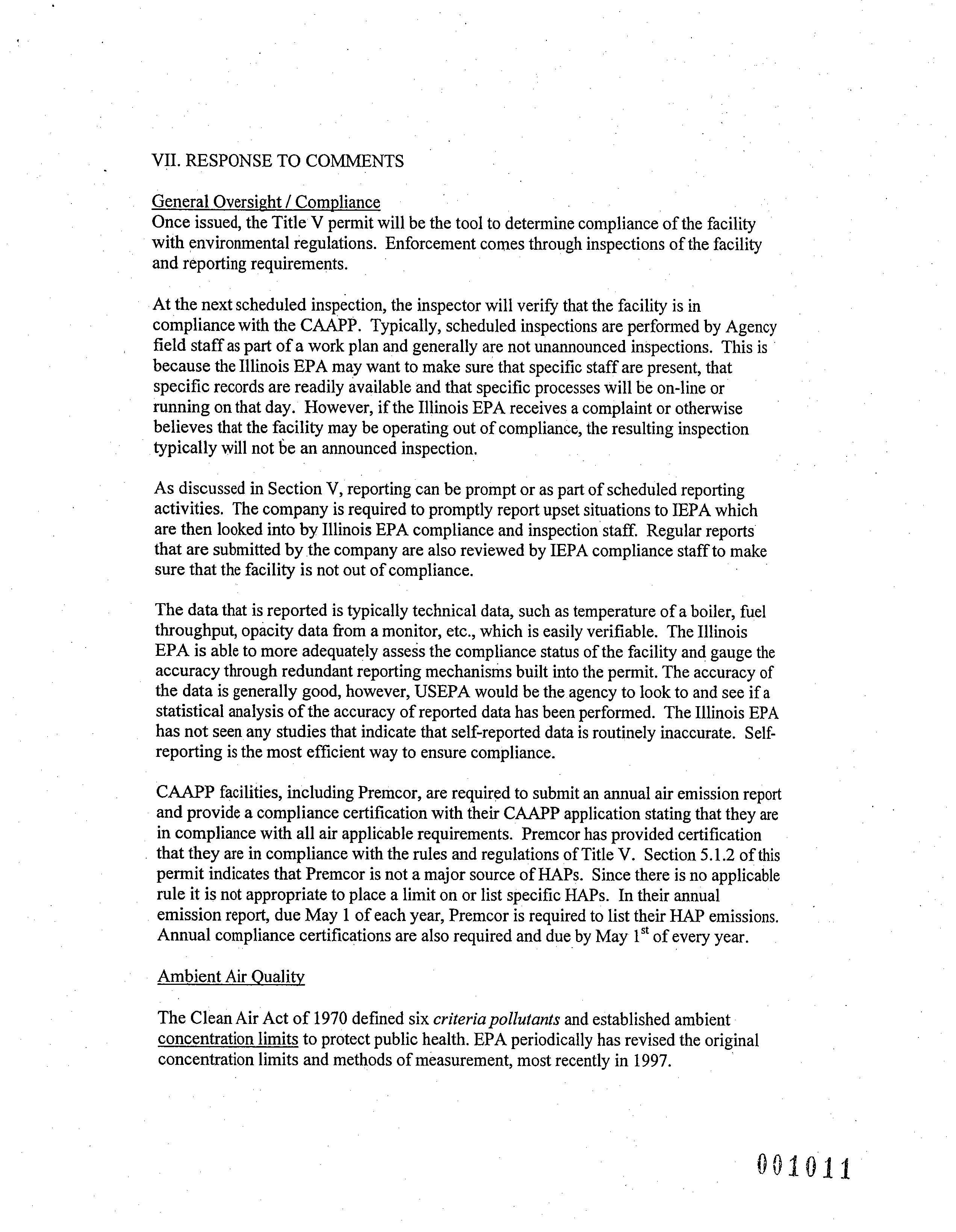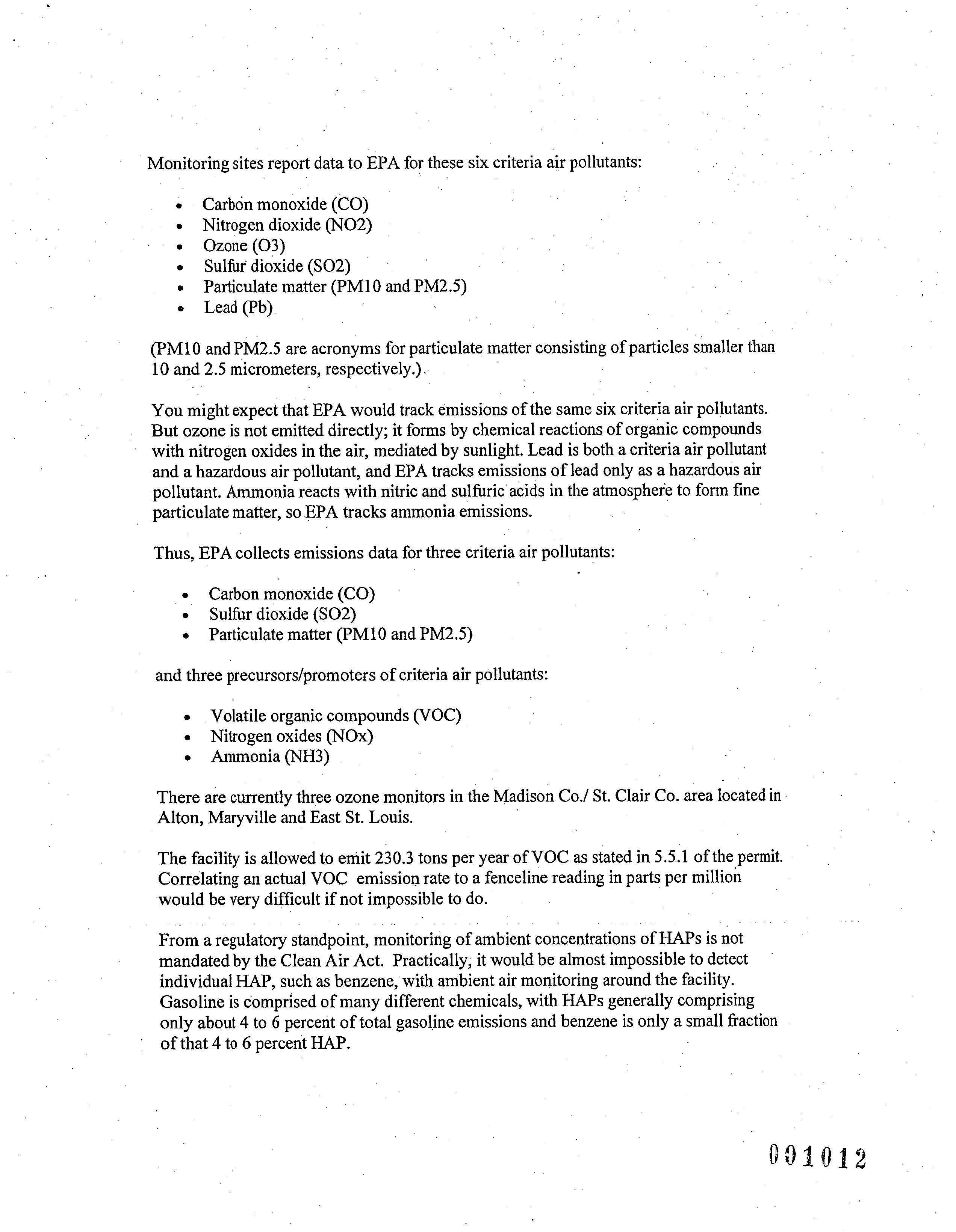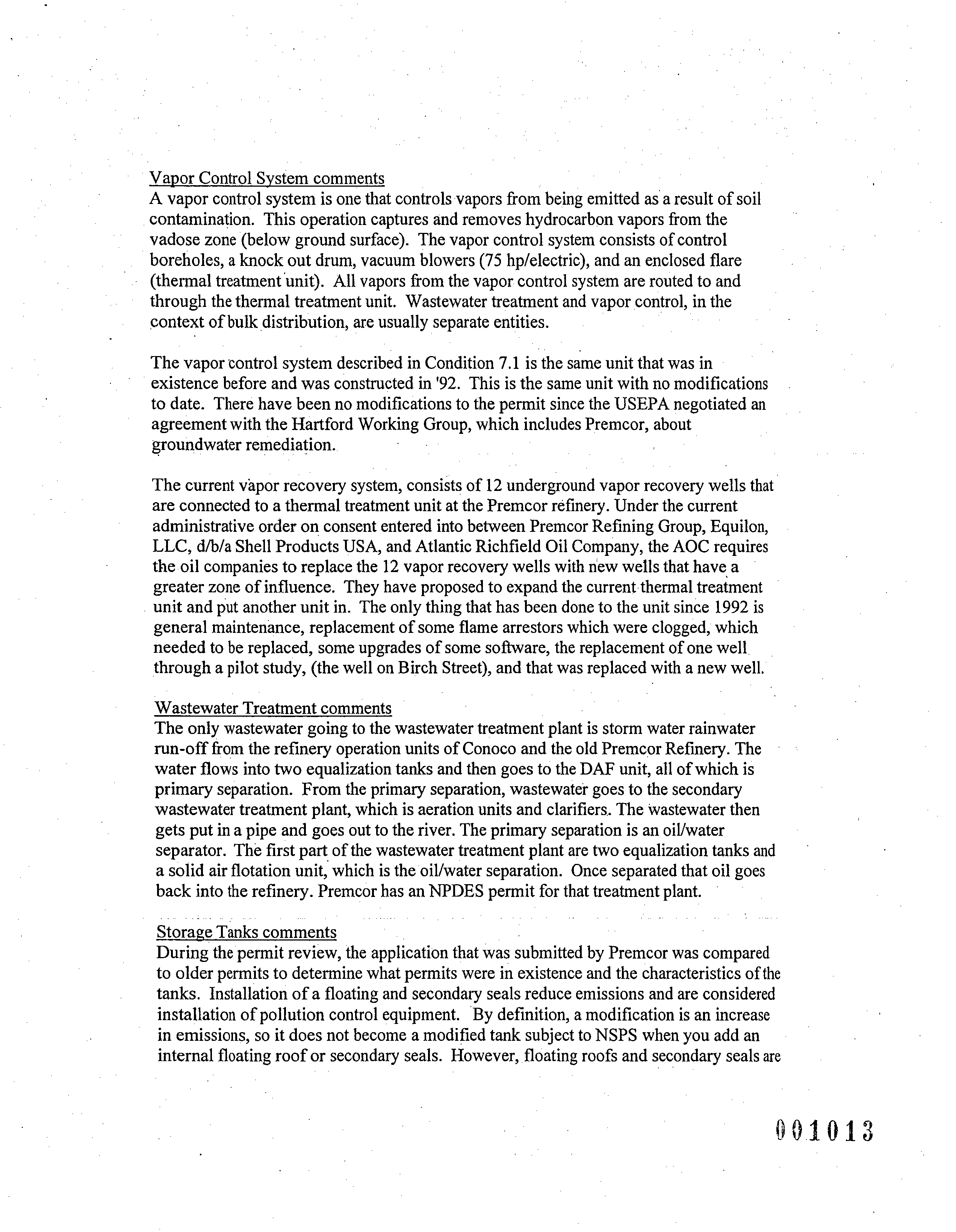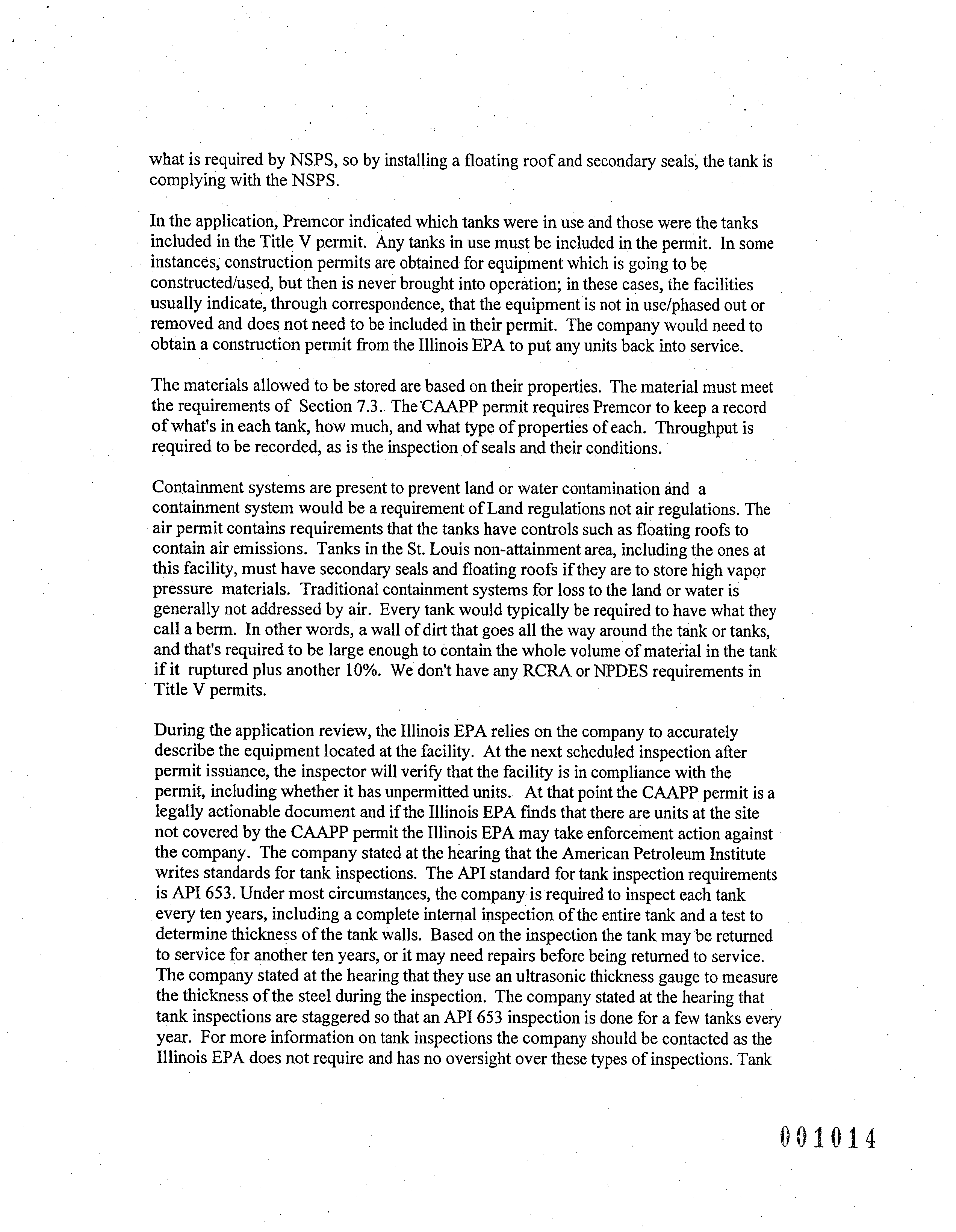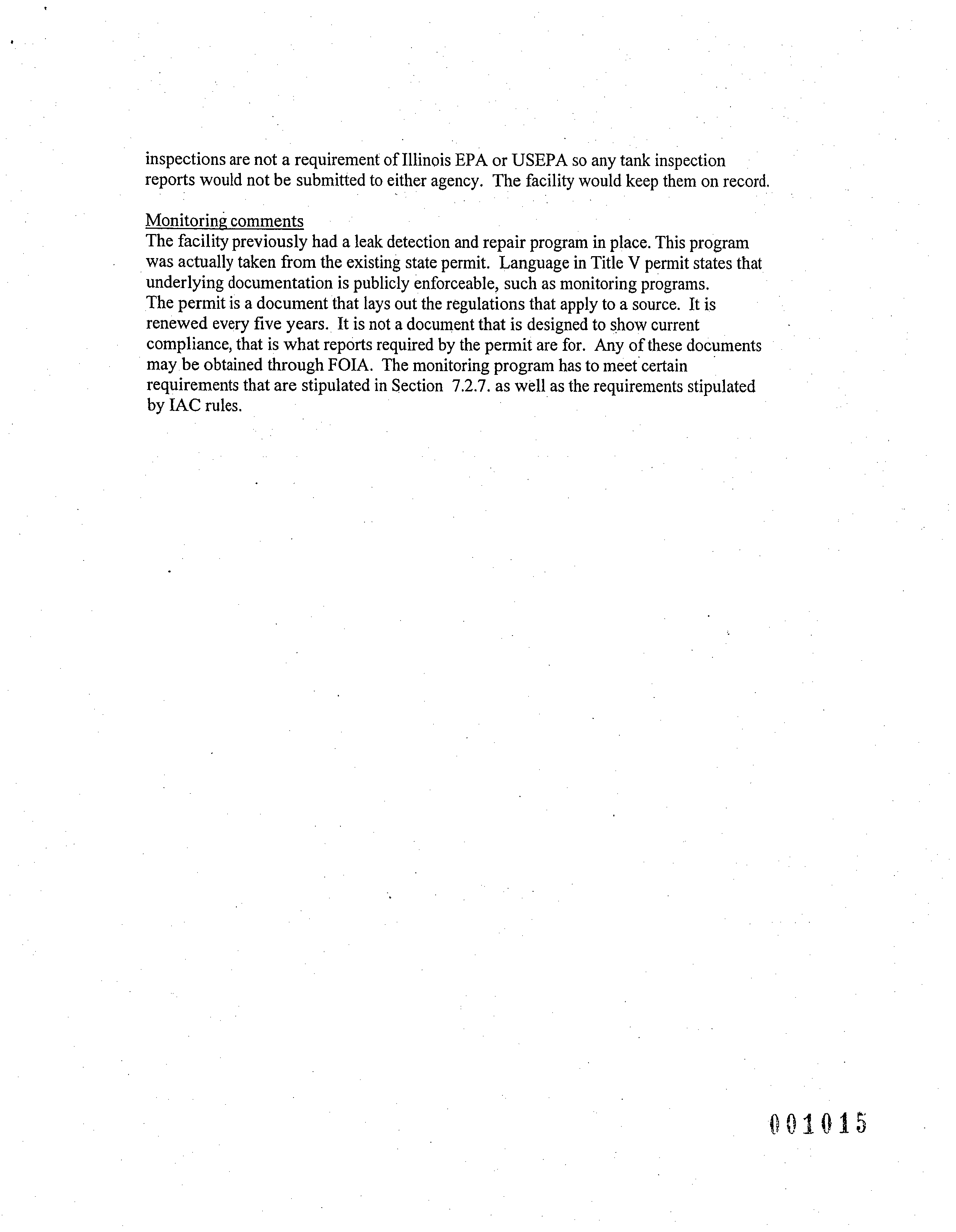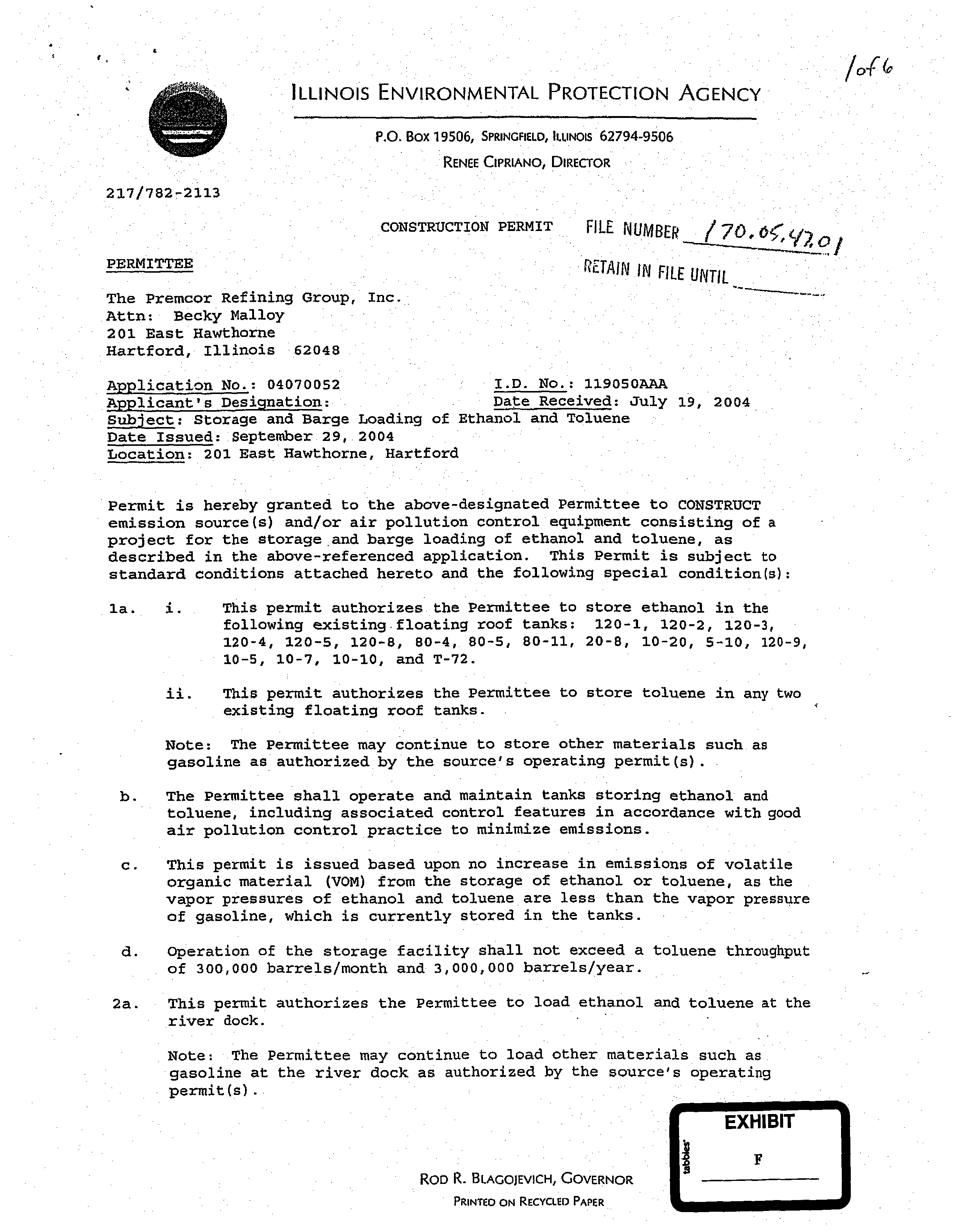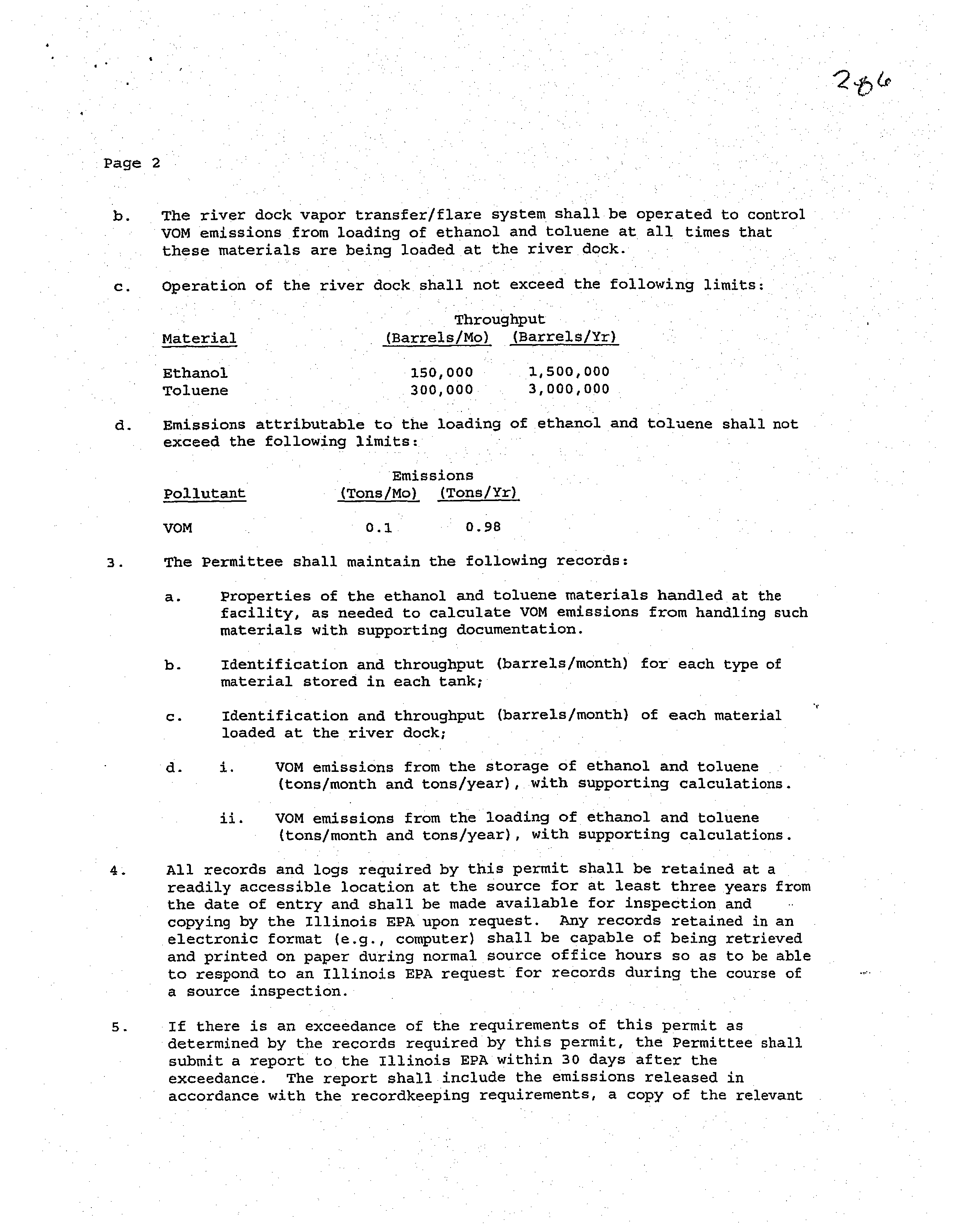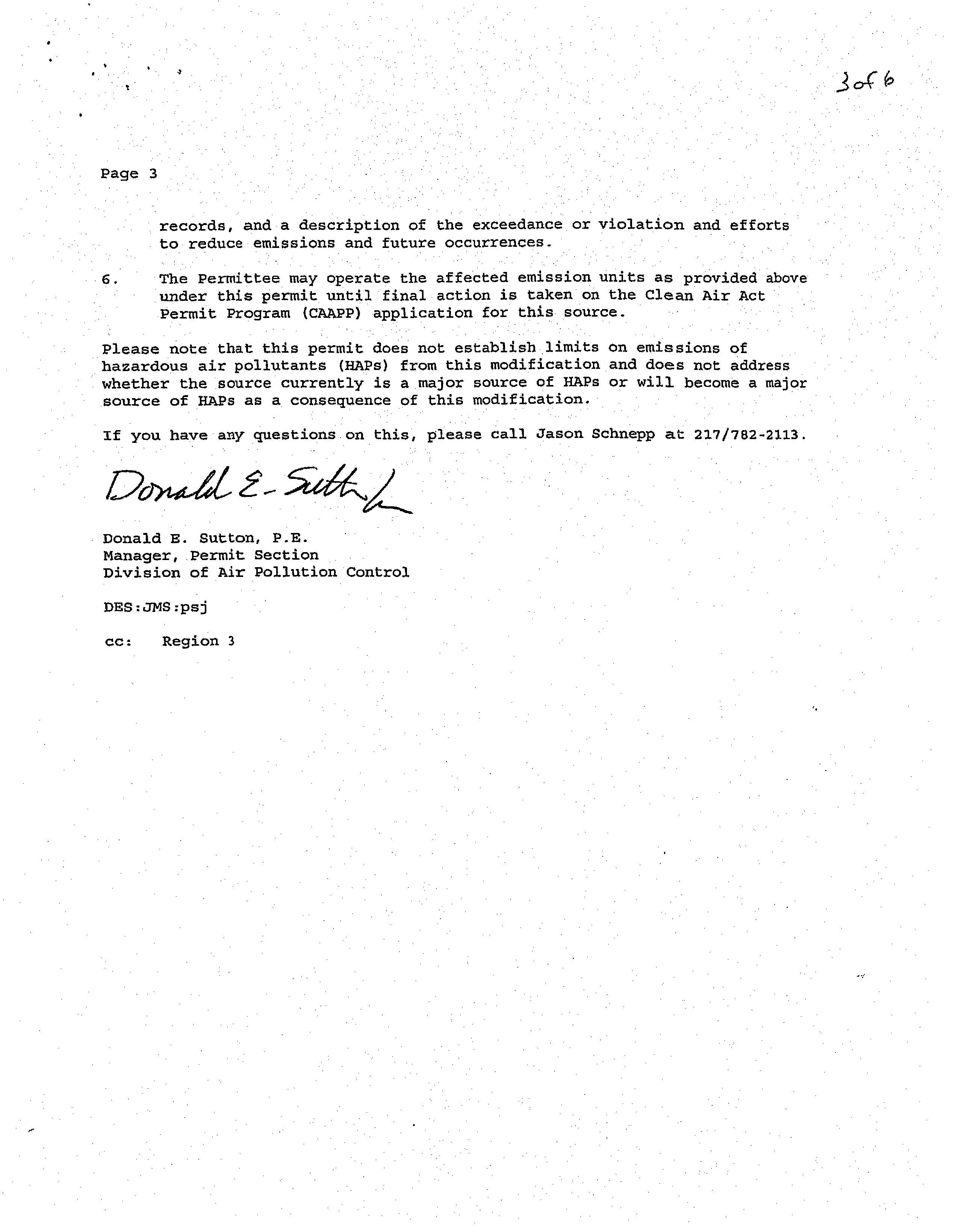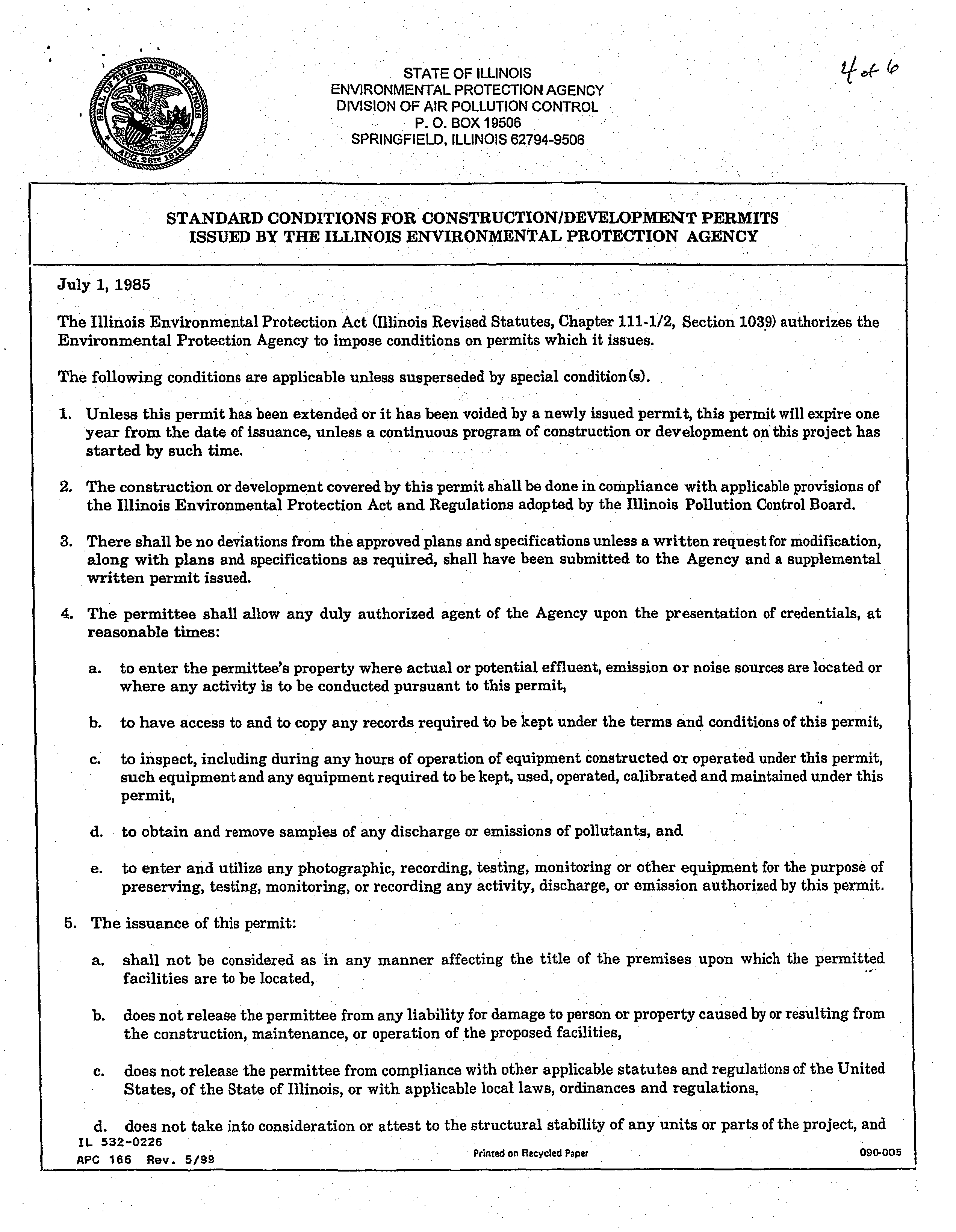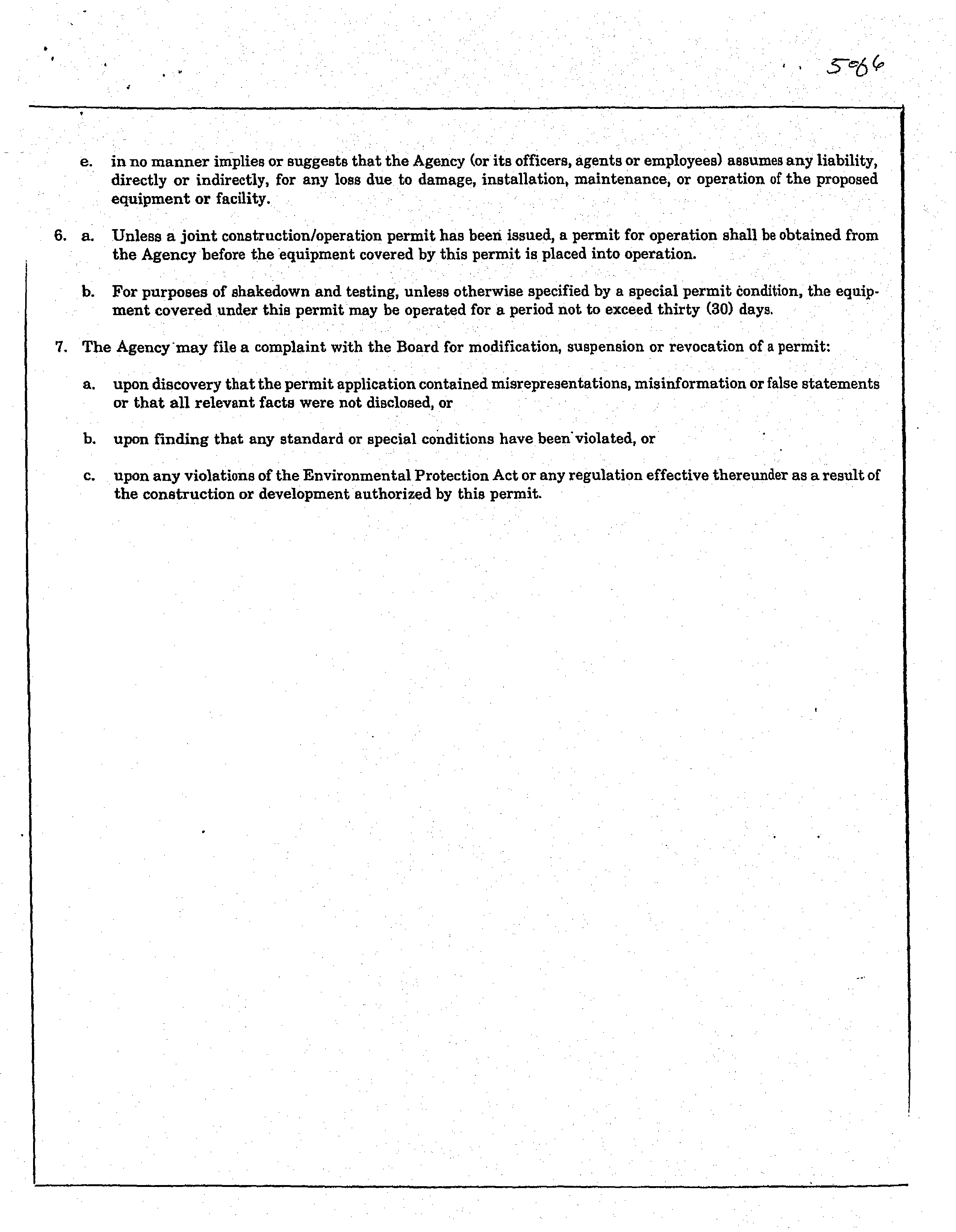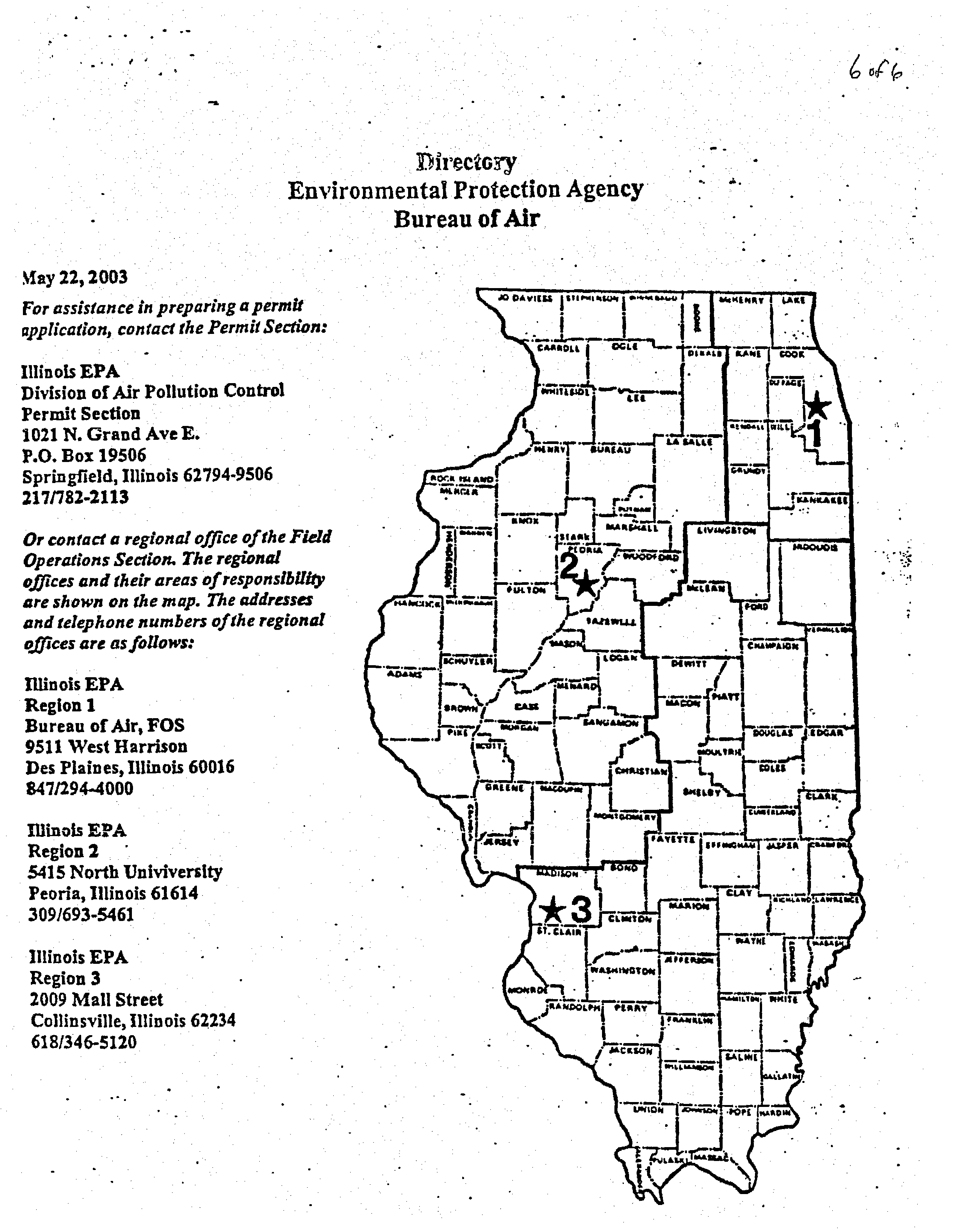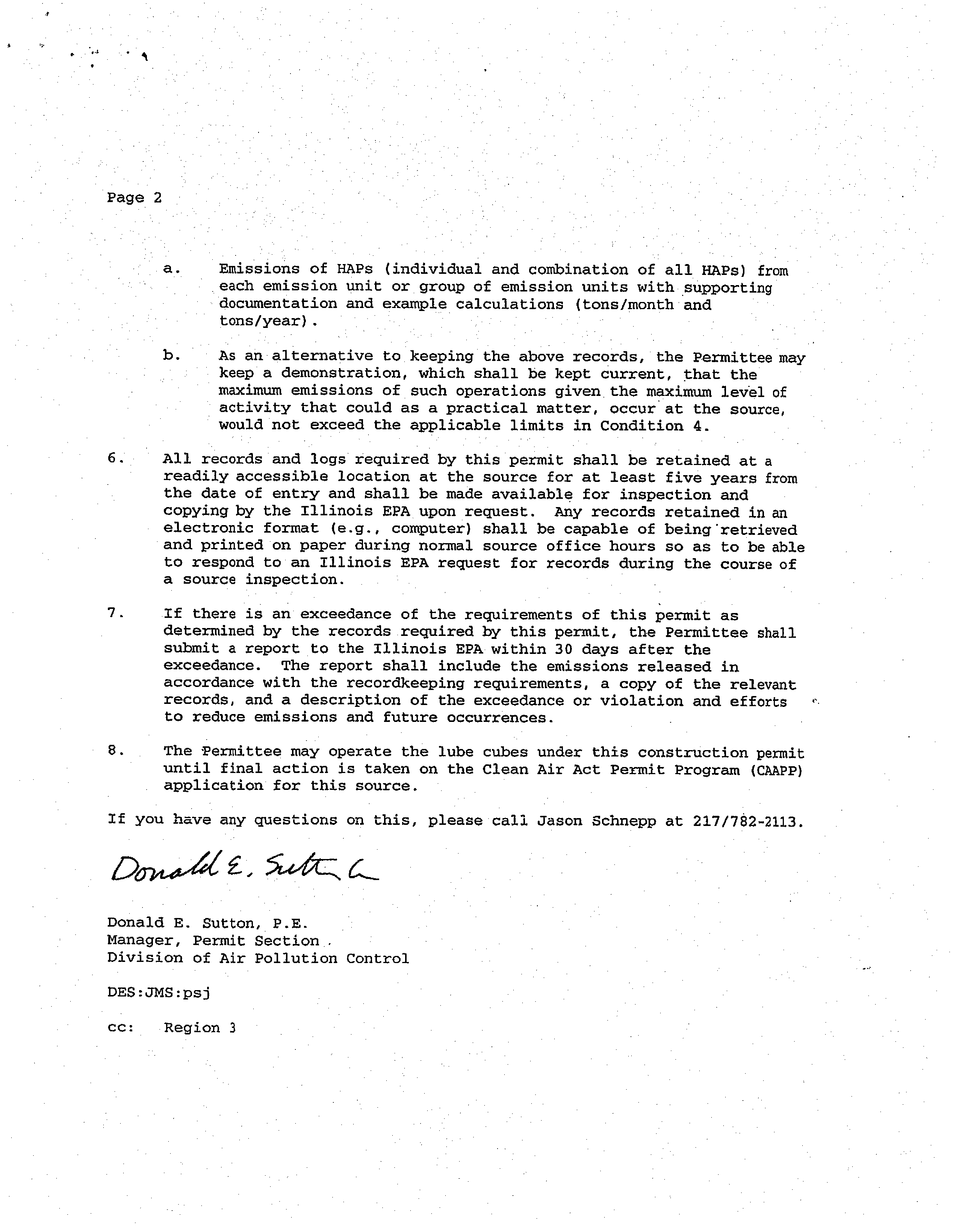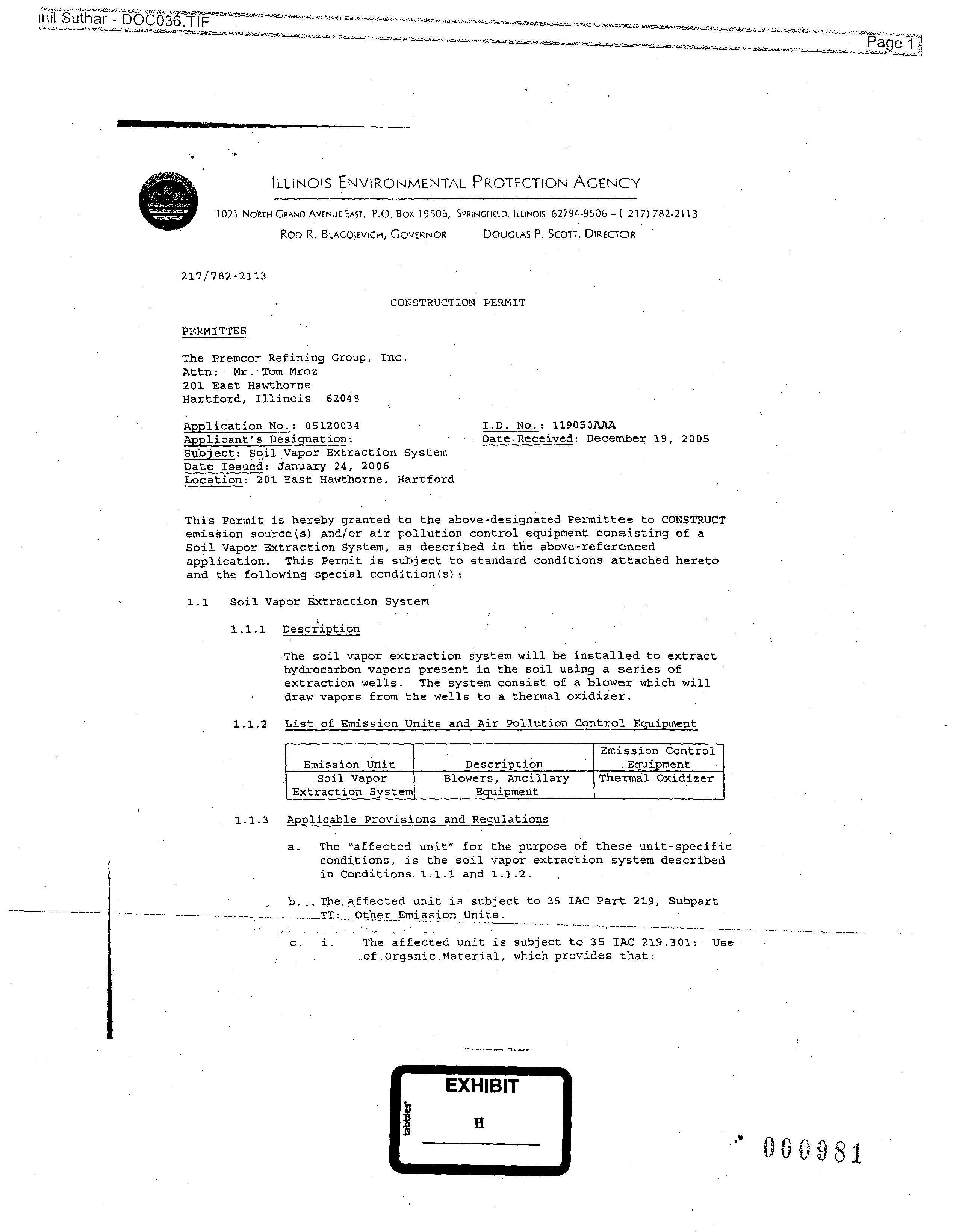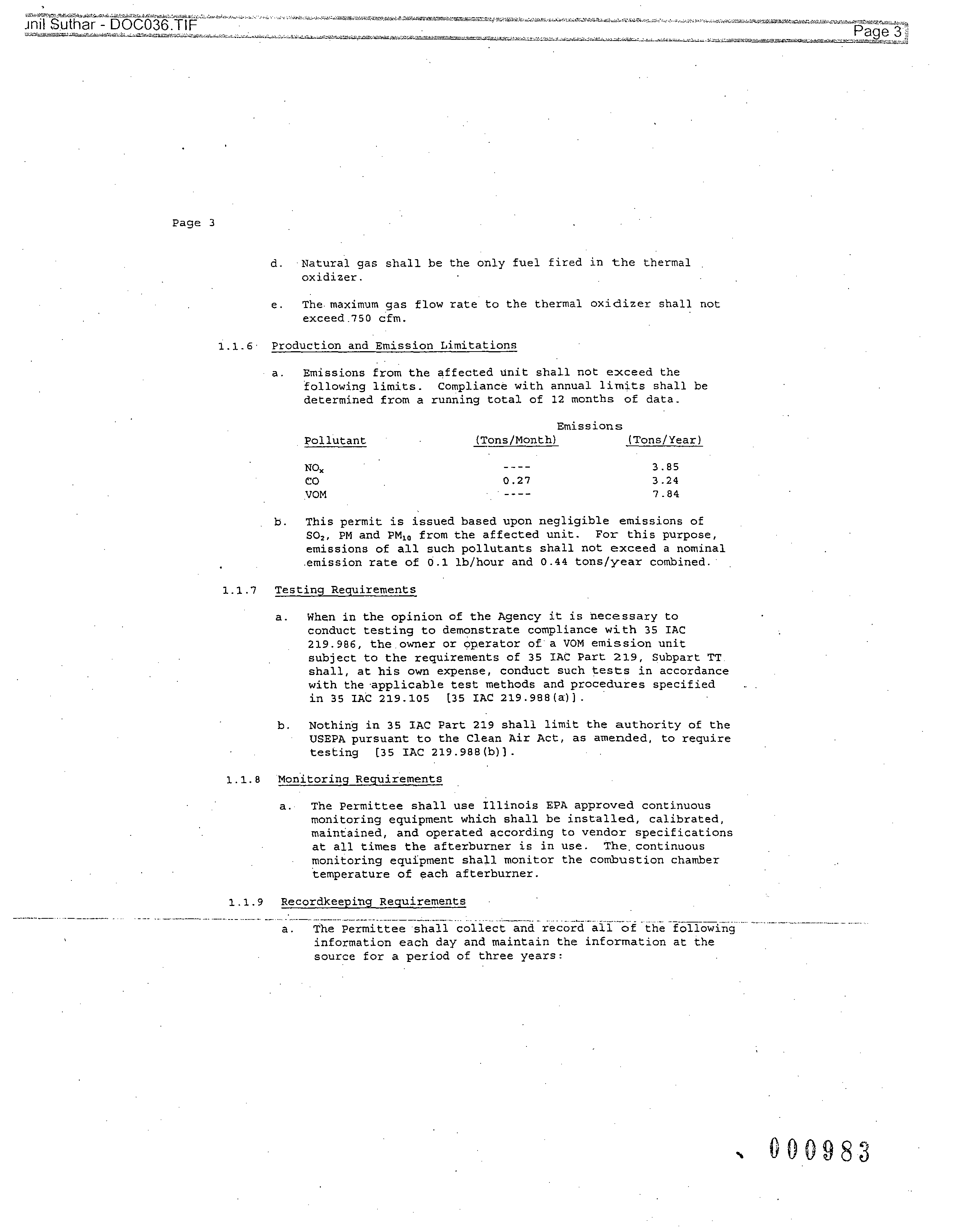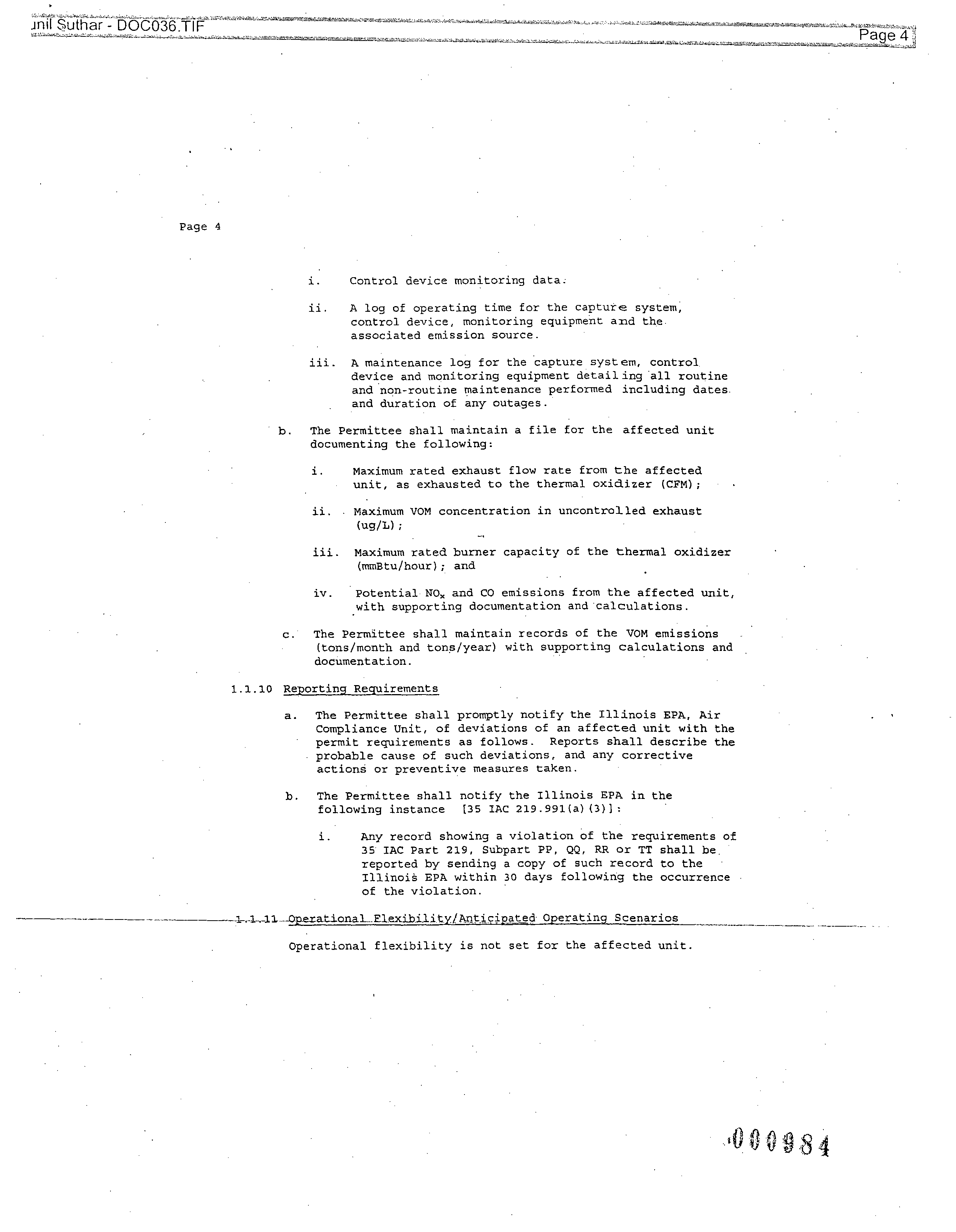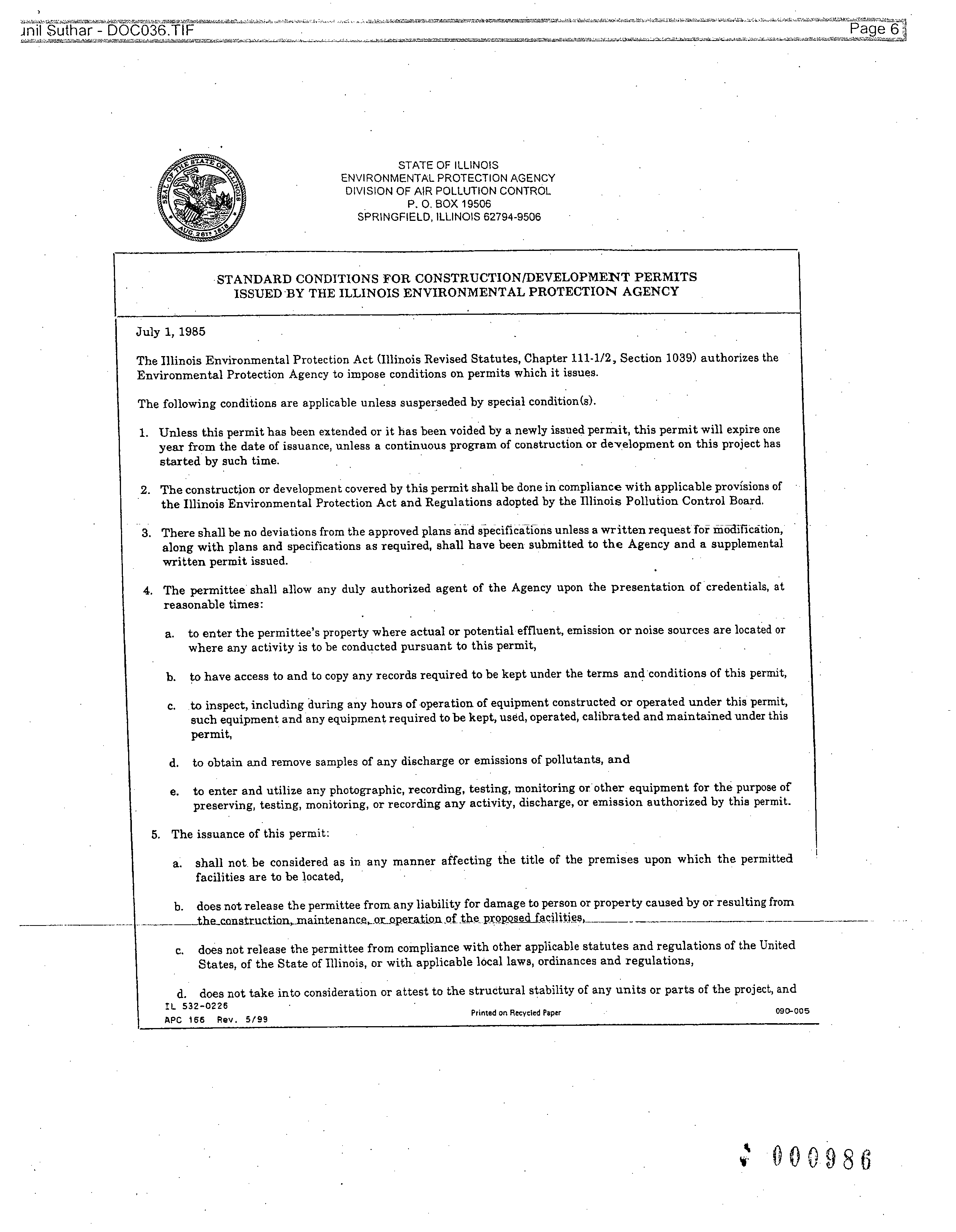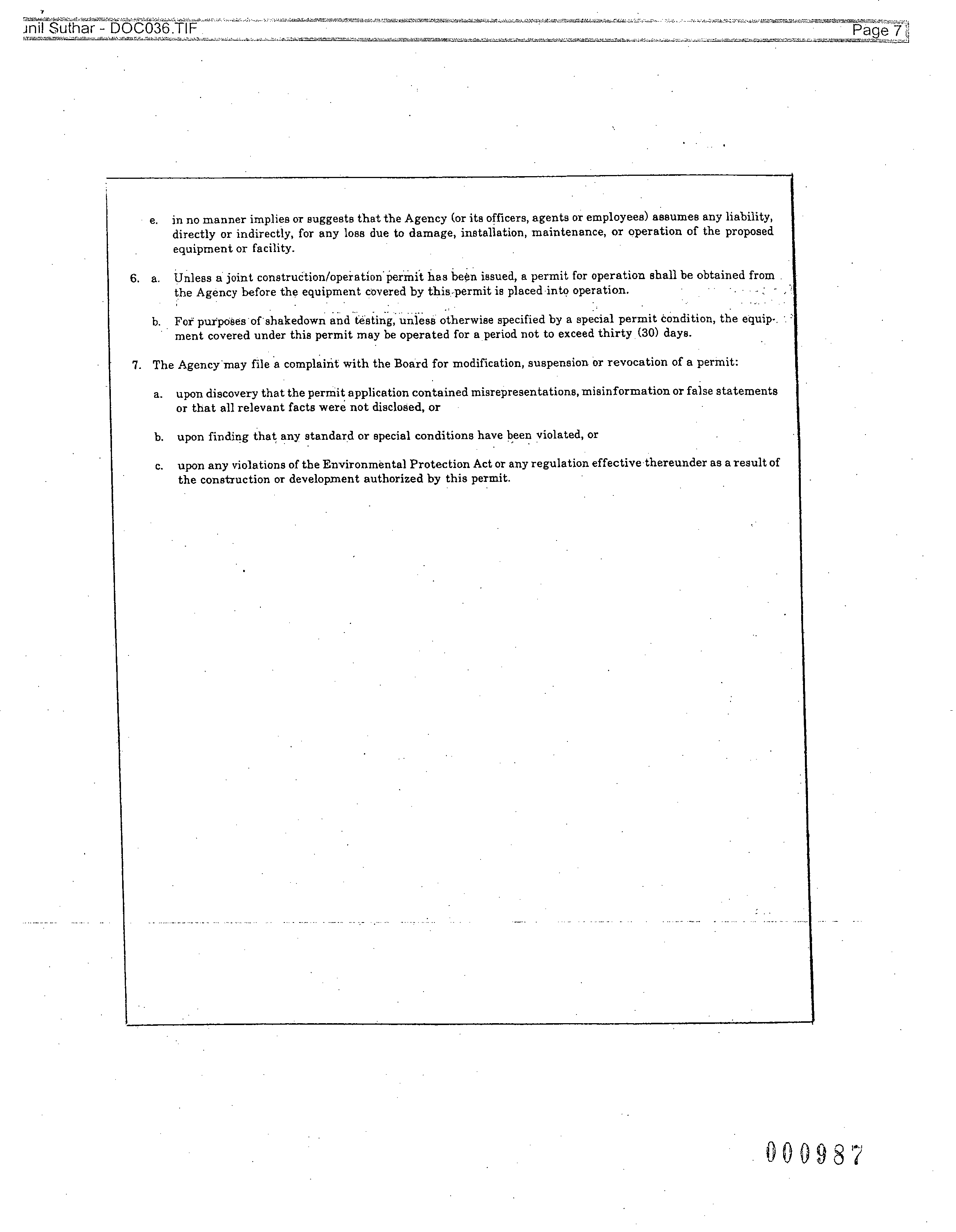BEFORE THE ILLINOIS POLLUTION
CONTROL BOARD
THE PREMCOR
REFINING
GROUP INC.,
Petitioner,
v.
ILLINOIS ENVIRONMENTAL
PROTECTION AGENCY,
Respondent.
PCB 2007-030
(CAAPP Permit Appeal)
NOTICE OF FILING
T O: Ms. Dorothy M. Gunn
Clerk of the Board
Illinois Pollution Control Board
100 West Randolph
Street
Suite 11-500
Chicago, Illinois 60601
(VIA
ELECTRONIC MAIL)
C arol
Webb,
Esq.
Hearing
Officer
Illinois Pollution Control Board
1021 North Grand Avenue East
Post
Office
Box
19274
Springfield, Illinois 62794-9274
(VIA FIRST CLASS MAIL)
PLEASE TAKE NOTICE that I have today filed with the Office of the Clerk of
the Illinois Pollution
Control
Board
a MOTION FOR LEAVE TO FILE AMENDED
PETITION FOR REVIEW and AMENDED PETITION FOR REVIEW,
copies of
which are herewith served upon you.
Respectfully submitted,
D ated: December
22, 2006
K atherine D. Hodge
Monica T. Rios
HODGE DWYER ZEMAN
3150 Roland Avenue
Post Office Box 5776
Springfield, Illinois 62705-5776
(217) 523-4900
THE PREMCOR REFINING
GROUP INC.,
Petitioner,
By:/s/ Katherine D. Hodge
One of Its Attorneys
THIS FILING SUBMITTED
ON
RECYCLED PAPER
ELECTRONIC FILING, RECEIVED, CLERK'S OFFICE, DECEMBER 22, 2006
CERTIFICATE OF SERVICE
I, Katherine D. Hodge, the undersigned, certify that I have served the attached
MOTION FOR LEAVE TO FILE AMENDED
PETITION FOR REVIEW and
AMENDED PETITION FOR REVIEW upon:
Ms. Dorothy
M. Gunn
Clerk
of the Board
Illinois Pollution Control Board
100 West Randolph Street
Suite
11-500
Chicago, Illinois 60601
via electronic mail on December 22, 2006; and upon:
Carol Webb, Esq.
Hearing
Officer
Illinois Pollution Control Board
1021 North Grand Avenue East
Post Office Box 19274
Springfield, Illinois 62794-9274
Robb H. Layman, Esq.
Assistant Counsel
Division of Legal Counsel
Illinois Environmental Protection Agency
1021 North Grand Avenue East
Post Office Box 19276
Springfield, Illinois 62794-9276
by depositing said documents in the United States Mail in Springfield, Illinois, postage
prepaid, on December 22, 2006.
/s/ Katherine D. Hodge
Katherine D. Hodge
P REM-013Ti1WOF and COS - Motion for Leave, Amended Petition, Motion to Supplement
ELECTRONIC FILING, RECEIVED, CLERK'S OFFICE, DECEMBER 22, 2006
BEFORE THE ILLINOIS POLLUTION CONTROL BOARD
THE PREMCOR REFINING
)
GROUP INC.,
)
Petitioner,
)
v.
)
PCB 2007-030
(CAAPP
Permit Appeal)
ILLINOIS ENVIRONMENTAL
)
PROTECTION AGENCY,
)
Respondent.
)
MOTION FOR LEAVE TO FILE
AMENDED PETITION FOR REVIEW
NOW COMES Petitioner, THE PREMCOR REFINING GROUP INC.
(hereinafter "Premcor"), by
and through its attorneys, HODGE DWYER ZEMAN, and
for its Motion For Leave To File Amended Petition
For Review, states as follows:
1.
On September 19, 2006, the Illinois Environmental Protection Agency
("Respondent") granted a
final
Clean
Air Act Permit Program ("CAAPP") permit to
Premcor's Hartford Terminal, a petroleum bulk storage and loading terminal, located
in
Hartford, Illinois.
2.
On October
24, 2006, Premcor filed its Petition for Review ("Petition") of
the CAAPP permit based on the fact that the Respondent failed to incorporate comments
submitted by Premcor into the final CAAPP permit and, as such, the CAAPP permit does
not reflect the current applicable
requirements or the current operations of the Hartford
Terminal.
3.
On
November 27, 2006, the Respondent filed a Motion to Dismiss the
Petition ("Motion") arguing that the Petition
failed
"to
provide adequate specificity to
apprise either the Board or the Illinois EPA of the subject
matter
of
the
appeal."
Motion
ELECTRONIC FILING, RECEIVED, CLERK'S OFFICE, DECEMBER 22, 2006
to Dismiss, The Premcor Refining Groo Inc. v. Illinois EPA, PCB No. 07-03 at T5
(I11.Pol.Control.Bd.
Nov. 27, 2006) (requesting the Illinois Pollution Control Board
("Board") dismiss Premcor's petition or, in the alternative, require
the
filing
of an
Amended Petition for Review ("Amended Petition").
4.
On
December 13, 2006, Premcor filed
a
Motion
for Extension of Time
requesting an
additional
14
days, or until
December 26, 2006,
to
file
a
Motion
for
Leave
to File Amended Petition. On December 18, 2006, the Board Hearing Officer granted
Premcor's Motion.
5.
Counsel for Premcor has consulted with the Respondent regarding the
Respondent's concerns as described in the Motion. Based on these discussions, it is
Premcor's understanding that filing an Amended Petition reiterating in detail the
comments listed in Premcor's exhibits to the original Petition will resolve the
Respondent's
concerns.
6.
While Premcor does not concur with Respondent's position that Premcor's
original
Petition for Review is inadequate, Premcor is seeking leave to file this Amended
Petition in order to address the State's concerns.
7.
Premcor's Amended Petition would not change the bases of Premcor's
appeal, but rather simply restates those bases in a form more acceptable to
Respondent.
8.
For the reasons stated above, Premcor respectfully moves the Board to
grant Premcor leave to file the attached Amended Petition, and further moves the Board
to deem said Amended
Petition filed
as of the date of the
Board's
Order
granting this
Motion.
ELECTRONIC FILING, RECEIVED, CLERK'S OFFICE, DECEMBER 22, 2006
WHEREFORE, Petitioner, THE PREMCOR
REFINING
GROUP
INC.,
respectfully moves the ILLINOIS POLLUTION CONTROL BOARD to grant it leave to
file an Amended Petition as set forth above, to deem the Amended Petition attached
hereto filed as of the date of the Board's Order granting this Motion, and to award it all
other relief just and proper in the premises.
Respectfully submitted,
THE PREMCOR REFINING GROUP INC.,
Petitioner,
By: /s/ Katherine D. Hodge
One of its Attorneys
Dated: December 22, 2006
Katherine D. Hodge
Monica T. Rios
HODGE DWYER ZEMAN
3150
Roland Avenue
Post Office Box 5776
Springfield, Illinois 62705-5776
(217) 523-4900
P REM-013\Fi1\Premcor Motion for Leave to File Amended
Petition
ELECTRONIC FILING, RECEIVED, CLERK'S OFFICE, DECEMBER 22, 2006
BEFORE THE ILLINOIS POLLUTION
CONTROL BOARD
THE PREMCOR REFINING
)
GROUP
INC.,
)
Petitioner,
)
v.
)
PCB 2007-030
(CAAPP Permit Appeal)
ILLINOIS ENVIRONMENTAL
)
PROTECTION AGENCY,
)
Respondent.
)
AMENDED PETITION FOR REVIEW
NOW COMES Petitioner, THE PREMCOR REFINING GROUP INC.
(hereinafter "Premcor"), by and through its attorneys, HODGE DWYER ZEMAN,
pursuant to Section 40.2 of the Illinois Environmental Protection Act (415 ILCS 5/40.2)
("Act") and 35111. Admin. Code § 105. Subpart C, and petitions the Illinois Pollution
Control Board ("Board") for review of the Clean Air Act Permit Program ("CAAPP")
permit granted to Premcor by the Illinois Environmental Protection Agency ("Illinois
EPA") pursuant to Section 39.5 of the Act on September 19, 2006. In support of
this
Petition, Premcor states as follows:
I. BACKGROUND
1.
Premcor owns and operates a petroleum bulk storage and loading terminal
in Hartford, Illinois ("Hartford
Terminal"),
which
is classified as a "major source" for
purposes of Title V of the federal Clean Air Act, 42 U.S.C. §§ 7401, et seq., and Section
39.5 of
the Act, 415 ILCS 5/39.5.
ELECTRONIC FILING, RECEIVED, CLERK'S OFFICE, DECEMBER 22, 2006
2.
Pursuant to Section 504 of the Clean Air Act, 42 U.S.C. § 7661b(c), and
Section 39.5(5) of the Act, Premcor
submitted an application for a CAAPP permit for its
Hartford Terminal to Illinois EPA on March 7, 1996.
3.
On November 7, 2003, Premcor submitted comments (attached hereto as
Exhibit A)
to
Illinois EPA
on a draft CAAPP permit that Premcor had received from
Illinois EPA. Administrative Record at 503-507 ("R. at
").
4.
A draft CAAPP permit was issued by Illinois EPA on May 27, 2004, and
Illinois EPA honored a request for a public hearing that was received by Illinois EPA
during the ensuing public comment period. This public hearing was held on July 13,
2004; therefore, the public comment
period was extended until August 12, 2004. (R. at
586.)
5.
On August 2, 2004, during the above-referenced comment period,
Premcor submitted comments (attached hereto as Exhibit B) on the May 27, 2004 draft
permit.
R. at
942-945.
6.
Thereafter, on August 26, 2004, Premcor submitted a letter (attached
hereto as Exhibit C) intended to answer certain questions posed by the American Bottom
Conservancy regarding the May 27, 2004 draft permit. R. at 961-967.
7.
On April 3, 2006, Premcor further provided comments (attached hereto as
Exhibit D) in response to Illinois EPA's request for confirmation of
the
status
of
the
storage tanks at the Hartford Terminal. R. at 996-997.
8.
On August 3, 2006, Illinois EPA issued its "Project Summary for the Draft
Clean Air Act Program (CAAPP) Permit" ("Project Summary") (attached hereto as
Exhibit E)
for
the Hartford
Terminal. R. at 1000-1015. Illinois EPA
stated that
"[a]fter a
ELECTRONIC FILING, RECEIVED, CLERK'S OFFICE, DECEMBER 22, 2006
review of Premcor's application,... [it] made a preliminary determination that the
application met the standards for issuance of a CAAPP permit." R. at 1010. However,
Illinois EPA failed to address the comments that Premcor had submitted regarding
the
May
27, 2004 draft permit. See discussion infra.
9.
On or about August 3, 2006, Illinois EPA submitted a draft CAAPP permit
for the Hartford Terminal to the
United States
Environmental
Protection Agency
("USEPA") for its review. R. at 1016-1119.
10. In addition, during the time that elapsed between the issuance of the initial
draft CAAPP permit for the public comment period (May 2004) and the submission of a
subsequent draft permit (August 2006) to USEPA for review, Premcor applied for and
received several construction permits for the Hartford Terminal. Construction permit
#04070052 (attached
hereto
as
Exhibit
F) allowed for the storage and loading of ethanol
and toluene at the terminal; permit #05030053 (attached hereto as Exhibit
G)
allowed for
the installation of 19 Lube Cube containers; and permit #050120034 (attached hereto as
Exhibit H and R. at 981-988) allowed for the installation of an on-site Soil Vapor
Extraction
system.
I
11. On September 19, 2006, Illinois EPA granted a final CAAPP permit,
attached hereto as Exhibit 1, for the Premcor Hartford facility. R. at 1122-1225.
Although Premcor and Illinois EPA permit staff had discussions and have corresponded
regarding Premcor's concerns with the draft permit, Illinois EPA failed to make certain
changes to the CAAPP permit,
requested
by
Premcor prior
to September
19, 2006,
as set
forth more fully below.
I Certain
exhibits
to this Amended Petition for Review, including, but not limited to, Exhibit F and
G, were
omitted from the Administrative Record. Premcor intends to file a Motion to Supplement Administrative
Record in order to add these documents to the Administrative Record.
ELECTRONIC FILING, RECEIVED, CLERK'S OFFICE, DECEMBER 22, 2006
12. On October 24, 2006, Premcor filed its original Petition for Review
("Petition") of the CAAPP permit based on the fact that the Respondent failed to
incorporate comments submitted by Premcor into the final CAAPP permit and, as such,
the CAAPP permit does not reflect the current applicable requirements or the current
operation
of
the Hartford Terminal. Petition at JT10-12.
13. On November 27, 2006, the Respondent filed a Motion to Dismiss the
Petition ("Motion") arguing that the Petition failed "to provide adequate specificity to
apprise either the Board or the Illinois EPA of the subject matter of the appeal." Motion
to Dismiss at 15 (requesting the Board dismiss Premcor's petition or, in the alternative,
require the filing of an amended petition).
14.
Counsel
for Premcor has consulted
with
the Respondent regarding the
Respondent's concerns as described in its Motion. Based on these discussions, it is
Premcor's understanding that filing this Amended Petition reiterating in detail Premcor's
comments
regarding the issued CAAPP permit will resolve the Respondent's concerns.
II. COMMENTS RAISED BY PREMCOR PRIOR TO THE ISSUANCE OF
THE FINAL CAAPP PERMIT
15. The following concerns were raised by Premcor prior to the issuance of
the final CAAPP permit, but not incorporated by Illinois EPA into the final CAAPP
permit.
16. Condition 1.3 of the CAAPP
permit
incorrectly lists Premcor's
Environmental Contact as Bill
Malloy. R.
at
1125. In August 2004, Premcor
requested
that the name be corrected to list Becky Malloy as Premcor's Environmental Contact. R.
at 943.2
2
As discussed below, thereafter, Premeor's Environmental Contact changed to Massoud Modarres.
ELECTRONIC FILING, RECEIVED, CLERK'S OFFICE, DECEMBER 22, 2006
17. In October 2005, Premcor submitted a notification (attached hereto as
Exhibit J) of change in the responsible official for the Hartford Terminal. Premcor
requested that the responsible official be changed
from Ed
Jacoby to
Paul Brochu,
Vice
President of Logistics, Operations, and Development.
18. Condition 3.1.1 pertains to "[a] ctivities determined by the Illinois EPA to
be insignificant activities, pursuant to 35 IAC 201.210(x)(1) and 201.211, as follows." R.
at 1128. Premcor requested the chemical storage tank and chemical storage
drum listed
in Condition 3.1.1 be removed since they are insignificant activities pursuant to 35 Ill.
Admin. Code § 201.210(x)(17) and
covered under Condition 3.1.3. R. at 943. Premcor
further requested that "Lube Cube Storage Tanks" be added to Condition 3.1.1.
Id.
Consequently, Condition 3.1.1 should read
3.1.1 Activities determined by Illinois EPA to be insignificant activities
pursuant to 35 IAC 201.210(x)(1) and 201.211, as follows:
Lube Cube Storage
Tanks
Id.
19. Condition 4.0 lists significant emission units at the
Hartford Terminal. R.
at 1130. Premcor requested that Tank 80-10, which is listed as part of Unit 03, be
removed from Condition 4.0 since it has a fixed
roof tank and only stores fuel oil #2. R.
at 943. It is, therefore, classified as an insignificant activity under 35
Ill. Admin.
Code
§ 201.210(x)(11) (Condition 3.1.3). For the same reasons, Premcor also requested that
Tank 20-3 and Tank T-3-1 be removed from Unit 04 of Condition 4.0. Id.
20. In addition,
Premcor requested that Tank T-72, which is an internal
floating roof tank, be added to Unit
04 of
Condition
4.0 since it will store gasoline and
other organic materials with vapor pressure less than gasoline. R. at 943.
ELECTRONIC FILING, RECEIVED, CLERK'S OFFICE, DECEMBER 22, 2006
21. Premcor also requested that the Illinois EPA remove the anthracite/sand
filters from Unit 05 listed in Condition 4.0 because they are not air emission control
equipment. R. at 943. The anthracite/sand filters,
which
are part of the
wastewater
treatment plant, remove solids from the waste water stream. Id.
22. Because of the low level of road dust associated
with Unit 06,
Premcor
requested that "Fugitive Emissions From Paved and Unpaved Roads" be removed from
Condition
4.0. R. at
943, 945.
Due
to the
low level
of road dust associated with the
facility, Condition 5.2.5(a) of the permit should be adequate to regulate fugitive
dust
emissions from within the source. R. at 945.
23. Premcor also clarified in its comments that the "Gasoline Storage Tanks"
described as Unit 08 in Condition 4.0 were listed as insignificant activities in the original
CAAPP application and that all the gasoline tanks listed in Condition 7.8 of the draft
permit have
been
permanently removed from the facility,
with
the exception of the
Gasoline Tank Wells, which continue to be insignificant activities. R. at 943. Premcor,
therefore, requested that
Tank A-2
be added to Condition
4.0 and
that the description of
Unit 08 be changed to "Tank A-2" because as a small horizontal fixed roof storage tank,
which is used as a pressure relief tank, it is appropriately listed in Condition 4.0. Id.
24. Condition 5.5.1 includes a table entitled "Permitted Emissions of
Regulated Pollutants." R. at 1135. Premcor requested that the table be updated to reflect
the change in VOM emissions due to the reclassification of storage tanks. Id. The table
should be revised as follows: VOM "Tons/Year" from "230.30 tpy" to 212.69 tpy" and
the "Total Regulated Pollutant Emissions" from "282.28 tpy" to "264.67 tpy."
R.
at 943.
ELECTRONIC FILING, RECEIVED, CLERK'S OFFICE, DECEMBER 22, 2006
25. Condition 5.2.7 incorrectly states that Premcor's original
CAAPP
application was not submitted or deemed complete by April 20, 1998. R. at 1134.
Illinois
EPA received Premcor's original application for the Hartford facility on March 7,
1996, and the Illinois EPA deemed the application complete
on March 29, 1996. R. at
969. As such, Premcor requested that Condition 5.2.7 be corrected to read as follows:
This stationary source has a pollutant-specific emissions unit that
is
subject to 40 CFR Part 64, Compliance Assurance Monitoring (CAM) for
Major Stationary Sources. The source must submit a CAMplan for each
affected pollutant-specific emissions unit upon application for renewal of
the initial CAAPP permit, or upon a significant modification to the
CAAPP permit for the construction or modification of a large pollutant-
specific emissions unit which
has the potential
post-control device
emissions of the applicable regulated air pollutant that equals or exceeds
major source threshold levels.
R . at 963.
2 6. The Hartford Working Group ("HWG") (IEPA ID 119050AAS) has
submitted an application for a construction permit authorizing the replacement of the
existing thermal treatment unit ("TTU") with a thermal oxidizer ("TO"). R. at 943. The
TO will be operated by HWG under a separate CAAPP permit. Id. The TTU was
permanently shut down in 2005.
Id. Therefore, Premcor requested
that Condition
7.1 be
removed when the TO has been constructed. Id. An application for significant
modifications will be submitted to remove this unit from the CAAPP permit.
27. Condition 7.1.10(b) describes Premcor's reporting requirements regarding
the
vapor
control system. R. at 1141. Although Condition 7.1 should be removed, as
referenced above, Premcor requested that if this condition is not removed, it be clarified
to state that the annual report required by Condition 7.1.10(b) may be submitted with the
ELECTRONIC FILING, RECEIVED, CLERK'S OFFICE, DECEMBER 22, 2006
Annual Emissions Report, which is required by Condition 5.7.2. R. at 944.
Premcor
suggested the following language:
The Permittee shall submit an annual report of emissions listed in
Condition 7.1.6 with supporting calculations. The report shall include a
summary of time periods, when the thermal treatment unit f ame was
extinguished.
This
annual
report may be submitted as a supplement to the
Permittee's Annual Emissions Report, which is required by Condition
5.7.2.
Id.
28. Condition 7.2.7(c) provides that if a flare is used as a control device to
comply with 35 Ill. Admin. Code § 219.762(a)(1), compliance will be "determined by the
methods described in Section 219.429(c)." R. at 1146. Premcor
requested
that Condition
7.2.7(c) be clarified by providing more detail regarding the requirements of 35 Ill.
Admin. Code § 219.429(c) and suggested the following language:
If the control device used to comply with 35 IAC Section
219.762(a)(1) of
this Subpart
is
a flare,
it shall:
1)
Be designed for and operated with no visible emissions, except
for
periods not
to exceed a total of 5 minutes during any 2 consecutive
hours as determined by U.S. EPA Method 22.
2)
Be operated with a pilot f ame present at all times and shall be
monitored with a thermocouple or any other equivalent
device to
detect the presence of the fame.
3)
Be steam-assisted, air-assisted,
or nonassisted.
4)
Be
used
only
with
the net heating value of the gas being combusted
being 11.2 MJ/scm (300 Btu/scf or greater if the f are is steam-
assisted or air-assisted; or with the net
heating
value
of the gas
being combusted being
7.45 MJ/scm (200 Btu/scf or greater if the
fare is nonassisted.
R. at 944.
ELECTRONIC FILING, RECEIVED, CLERK'S OFFICE, DECEMBER 22, 2006
29. In order to maintain continuity of the permit condition numbering system,
Premcor requested
that Condition 7.2.7(d)(iii) be corrected to
read
"As an
alternative to
subsection (d)(ii) of this Section,..." as opposed to "As an alternative to subsection (d)(2)
of this Section,...." R. at 944.
30.
Premcor also requested that the following compliance option, as provided
in 35 Ill. Admin. Code §
219.762(b)(3)(B), be added to the permit as Condition
7.2.7(d)(iv):
As an alternative to subsections (d)(ii) and (d)(iii) of this Section, an
owner or operator of a marine terminal may obtain documentation as
described in 35 IAC 219.770(b) that the marine vessel
has been
vapor-
tightness tested within either the preceding 12 months or the preceding 14
months, if the test is being conducted as part of the Coast Guard's
reinspection of the vessel required under 46 CFR 31.10-17, using Method
21 of Part 60, Appendix
A,
incorporated by
reference at
Section
219.112
of this Part, as described in Section 219.768(b)
of this
Subpart.
R . at 944.
3 1. In order to maintain continuity of the permit condition numbering system,
Premcor requested that Condition 7.2.7(f) and 7.2.7(g) be
relabeled 7.2.7(e) and 7.2.7(f),
respectively. Id.
32. Premcor requested that Conditions 7.2.9(d) and 7.2.9(e) be
removed
because neither condition applies to the Hartford Terminal's
operations. Id. Premcor
does
not
use
the emissions reduction compliance option at the marine terminal as
described in Section 7.2.9(d), and the
requirement in
Condition
7.2.9(e) mandating initial
certification of marine terminal
operations was required, and complied with, in 1996. Id.
33. Condition 7.3.2 lists emission units and air pollution control equipment for
Unit 03. R. at 1152. Premcor requested that Tank 80-10 be removed from the list of
tanks included in Unit 03 because
it
is a
fixed roof tank and only stores fuel oil
#2.
Id. It
ELECTRONIC FILING, RECEIVED, CLERK'S OFFICE, DECEMBER 22, 2006
is, therefore, classified as an insignificant activity under 35
Ill. Admin.
Code
§ 201.210(a)(11)
(Condition 3.1.3). R. at 1152.
34. Condition 7.4.2
lists
emission
units and air pollution control equipment for
Unit 04. R. at 1158. Premcor requested that Tank 20-3 and Tank T-3-1 be removed from
the list of tanks included in Unit 04 because
they are fixed roof tanks that will only store
fuel oil
#2,
and are classified as insignificant activities under 35 Ill. Admin. Code
§ 201.210(a)(11) (Condition 3.1.3). R. at 944.
35. Premcor further requested that Tank T-72 be added to Unit 04 of
Condition
7.4.2 because it is an internal floating roof tank. Id.
36. Premcor also commented
regarding
Condition
7.5 that the HAP speciation
of VOM emissions from the wastewater treatment plant was updated in its supplement to
the CAAPP,
dated July 2004. R. at 945.
37. Premcor
requested that Illinois EPA remove Condition 7.5.5 from the
CAAPP
permit because, as previously discussed, the anthracite/sand filters are not air
emissions control equipment and should not be subject to periodic
inspections under the
CAAPP permit. Id.
38. As
referenced above, due to the low level of road dust associated with
paved and unpaved roadways at the Hartford Terminal, the requirement in Condition 7.6
regarding the annual calculation of emissions from road traffic
is
unnecessary
and over
burdensome.
Premcor, therefore, requested that Condition 7.6 be removed. R. at 945.
Condition 5.2.2(a) is adequate
to regulate fugitive dust emissions from roads at the
facility. Id.
ELECTRONIC FILING, RECEIVED, CLERK'S OFFICE, DECEMBER 22, 2006
39. Premcor requested that references to "petroleum refineries" be removed
from Conditions 7.7.7, 7.7.8 and 7.7.9 in order to avoid confusion regarding the nature
of
Premcor's operations
under this permit. R. at 507. Condition 7.7.7 should read:
As prescribed by 35 IAC 219.766, affected Fugitive YOM Emissions from
Leaking River Dock Flare
Components are subject to 35 IAC 219.447,
which prescribes that an owner or operator of a marine terminal subject
to 35 IAC 219.445 of this Part shall, for the purpose of detecting leaks,
conduct a component monitoring program consistent with the following
provisions:
Condition 7.7.8 should read:
As prescribed applicable to marine terminals by 35 IA C 219. 766, affected
Fugitive VOMEmissions from Leaking River Dock Flare Components are
subject
to 35
IAC 219.446,
which
provides
that an owner or operator shall
prepare
a
monitoring
program which
contains,
at a
minimum:
a)
An identification of all marine terminal components and the period
in which each will be monitored pursuant to 35 IAC 219.447 X35
IA C Section 219.446(a)];
b)
The format for the monitoring log required by 35 IAC 219.448 (35
IA
C
Section 219.449(b)];
c)
A
description
of the monitoring equipment to be used pursuant to
35 IAC 219.447 of this Part X35 IAC Section 219.446(c)];
d)
A description of the methods to be used to identify all pipeline
valves, pressure
relief valves in gaseous service and all leaking
components, such that they are obvious to both terminal personnel
performing monitoring and Agency personnel performing
inspections X35
IA
C Section
219.446(d)].
Condition 7.7.9 should read:
As prescribed applicable to marine terminals by 35 IAC 219. 766, affected
Fugitive YOM Emissions from Leaking River Dock Flare Components are
subject to 35 IA C 219.448, which prescribes that an owner or operator
shall maintain a leaking component monitoring log which shall contain at
a minimum, the following information:
R. at 507.
11
ELECTRONIC FILING, RECEIVED, CLERK'S OFFICE, DECEMBER 22, 2006
40.
Condition 7.7.1 does not accurately reflect the operations of the Hartford
Terminal because it references a natural gas processing plant,
which does
not
exist at the
Terminal. Premcor requested that Condition
7.7.1
be
updated to read:
Fugitive emissions from equipment components, such as valves, flanges,
etc., are generated
during the processing of material through the piping
distributed
throughout the source.
R. at 506.
41. Condition 7.8 pertains to Unit 08 - Gasoline
Storage Wells. R. at 1188.
Premcor requested that the
gasoline storage tanks identified in this section, including two
contractor gasoline tanks, portable 300 gallon storage tanks, and the gasoline tank
west
of
the main maintenance shop, be removed from the permit because they
are no longer
operated at the Hartford facility. R. at 945. Premcor further
explained that the units
identified as gasoline tank wells in the draft permit are part of remediation operations at
the Hartford facility. Id. The gasoline tank
wells consist of ten relatively small (500
gallon) double-walled containers that are commonly referred to as "Lube
Cubes," which
hold
hydrocarbons (including gasoline) pumped from vertical recovery wells until the
contents can be collected by a
vacuum
truck
and removed from the facility. Id.
Emissions of both VOM and HAP from these
tanks are small, so that they should be
classified as insignificant under 35 Ill. Admin. Code § 201.211(a). Id.
42. Premcor further requested that Tank A-2
be added to Condition 7.8. R. at
945. Premcor explained that Tank A-2 is a small (24,900
gallon) horizontal storage tank
located at the river dock and is used as a pressure relief tank, where either gasoline or
distillate may be temporarily stored in the event that the product pressure in
the river
dock loading lines becomes too great and must be relieved. Id. Because of its size, the
12
ELECTRONIC FILING, RECEIVED, CLERK'S OFFICE, DECEMBER 22, 2006
only control equipment necessary for the operation of this tank is submerged fill, as
required by 35 Ill. Admin. Code § 219.122(b). R. at 945. In addition, Premcor requested
that all references to "affected Tank Wells" in Condition 7.8 be changed to "affected
storage tank" to reflect the addition of Tank A-2 to Condition 7.8.
Id.
43. Premcor requested that the second paragraph of Condition 7.8.6 be
removed because it is entirely informational and does not contain any permit
requirements. Condition 7.8.6 should read as
follows:
7.8.6 Emission Limitations
There are no specific emission limitations
for this unit, however, there are
source wide
emission limitations in Condition 5.5 that include this unit.
Id.
4 4. As stated above, prior to the issuance of the final CAAPP permit, Premcor
requested all of the above changes to the permit
in
order
to
ensure
that the permit
accurately reflects the operation of the Hartford Terminal and the legal
requirements
applicable
to that operation. However, Respondent did not incorporate any of those
changes into the final permit.
III. ADDITIONAL COMMENTS FOR CONSIDERATION BY THE ILLINOIS
EPA
45. In addition to the comments above, Premcor has the following additional
comments on the final CAAPP permit.
46. Since Premcor's request in August
2004 regarding a change to the
Environmental Contact listed in the permit cover
page and
Condition
1.3 of the final
permit, Massoud Modarres has become the person in charge of such matters at the
Hartford Terminal. Premcor therefore
requests that the Environmental Contact in
13
ELECTRONIC FILING, RECEIVED, CLERK'S OFFICE, DECEMBER 22, 2006
Condition 1.3 be changed to Massoud
Modarres, as well as updating the telephone
number
to (618) 255-5109. See Tl6 supra.
47. Because of the removal of "Fugitive
Emissions From Paved and Unpaved
Roads"
from Condition 4.0, Premcor requests that the unit number in
Condition 4.0 for
Fugitive VOM Emissions
be changed from Unit 07 to Unit 06. See R.
at
1130.
48. For consistency, Premcor requests
that the Illinois EPA update the unit
number for Gasoline Storage Tanks from
Unit 08 to Unit 07. See R. at 1130. In addition,
as more fully explained
below, Premcor requests that Unit 09 and Unit 10 be removed
from
the "Significant Emission Units" table, and consequently the unit number for
the
Soil Extraction System be updated from Unit 11 to Unit 08.
49. Condition 7.1.3(b)(ii) references
Condition 7.1.3(c)(i), which does not
exist
in
this permit. R. at 1139. Premcor requests clarification regarding
this
reference.
50. Premcor also requests that the reference
to Tank "102-5" in Condition
7.3.2 be revised to "120-5," which is the true description of the
tank. See R. at 1152.
51. Because
anthracite/sand filters are not air emissions control equipment,
Premcor requests that they be removed from
the list of emission control equipment in
Condition 7.5.2. See R. at 1174.
52. Premcor
requests that the section number for Fugitive Emissions from
Leaking River Dock Flare Components be changed from Section
7.7 to Section 7.6 to
remain consistent with the permit outline due to
the removal of the sections for Fugitive
Emissions from Paved and Unpaved Roadways. See discussion above.
ELECTRONIC FILING, RECEIVED, CLERK'S OFFICE, DECEMBER 22, 2006
53. In order to be more specific regarding the operations at the Hartford
Terminal, Premcor requests to amend the language it proposed prior to the permit's
issuance by updating Condition 7.7.1 as follows:
Fugitive emissions from equipment components, such as valves, flanges,
etc., are generated during the processing of material through the vapor
collection and control system located at the River Dock.
See T40 supra.
54. Condition 7.9 should be
removed
because
Lube Cubes are classified as
insignificant activities per 35111. Admin. Code § 201.211(a). The Lube Cubes should be
listed in Condition 3.1.1 as previously discussed. See T18 supra.
55. Condition 7.9.6(a) is a source-wide emission
limit taken
to
ensure that the
Hartford Terminal will remain a minor source of HAP emissions. R. at 1191. This
condition is redundant with Condition 5.5.2 of the permit; thus, Condition 7.9.6(a) should
be moved to Condition
5.0 of the permit. In addition, Condition 7.9.9 contains
recordkeeping requirements to ensure compliance with the
source-wide HAP emission
limit, and therefore, it should be moved to Condition 5.6 of the permit. See
R. at 1192,
1136.
56. In order to more accurately describe the operations
at the Hartford
Terminal, Premcor requests
to amend the language it proposed prior to the permit's
issuance regarding the
removal of the term "petroleum refineries" from Conditions 7.7.7,
7.7.8 and 7.7.9. See x(39 supra. Specifically, Condition 7.7.7 should read:
As prescribed applicable to marine terminals by 35 IA C 219.766, the
affected Fugitive YOM Emissions from
Leaking River Dock Flare
Components are subject to 35
IA
C
219.447, which prescribes that an
owner
or operator subject to 35 IA C 219.445 of this Part shall, for the
purpose of detecting leaks, conduct a component
monitoring program
consistent with
the following provisions:
15
ELECTRONIC FILING, RECEIVED, CLERK'S OFFICE, DECEMBER 22, 2006
Condition 7.7.8 should read:
As prescribed applicable to marine terminals by 35 IA C 219.766, affected
Fugitive VOMEmissions from Leaking River Dock Flare Components are
subject to 35 IA C 219.446, which prescribes that an owner or operator
shall prepare a monitoring program which contains, at a minimum:
a)
An identification of all components and the period in which each
will be monitored pursuant to 35 IAC 219.447 [35 IAC
219.446(a)];
b)
The format for the monitoring log required by 35 IAC 219.448 [35
IAC' 219.446(b)];
c)
A description of the monitoring
equipment to be used pursuant
to
35
IAC 219.447 [35 IAC 219.446(c)];
d)
A description of the methods to be used to
identify all pipeline
valves, pressure
relief
valves
in gaseous service and all leaking
components such that they are obvious to both personnel
performing monitoring and Agency personnel performing
inspections [35
IAC 219.446(d)].
Condition 7.7.9 should read:
As prescribed applicable to marine terminals by 35 IA C 219.766, affected
Fugitive VOMEmissions from Leaking River Dock Flare Components are
subject to 35 IAC 219.448, which prescribes that an owner or operator
shall maintain a leaking components monitoring log which shall contain,
at a minimum, the following information:
57. Condition 7.10, as listed in the permit, contains alternate modes of
operation
for
emission
units that are already included in Sections 7.2, 7.3 and 7.4 of the
permit. See R. at 1195, 1143-1173. Section 7.10 mirrors construction
permit
#04070052,
which
permits the storage of alternate materials in existing storage tanks and loading of
alternate materials through the existing river barge dock
at the Hartford Distribution
Center. See Exhibit F. Premcor requests that the conditions from this section be
ELECTRONIC FILING, RECEIVED, CLERK'S OFFICE, DECEMBER 22, 2006
incorporated into Condition 7.2, 7.3 and 7.4 as appropriate.
Condition 7.10 should,
therefore, be removed.
58. Premcor requests that the section number for the Soil Vapor Extraction
System be updated from Condition 7.11 to Condition 7.8 to remain consistent
with
the
permit outline due to the removal
of the sections for "Lube Cubes" and "Storage and
Barge Loading of Ethanol and Toluene."
IV. CONCLUSION
59. For the above-referenced reasons, the CAAPP permit
does
not reflect
the
current applicable requirements or the current operations of the facility, and
thus
is not
"consistent with the Clean Air Act and regulations promulgated thereunder." 415 ILCS
5/39.5. Further, certain conditions discussed herein are not required to "accomplish the
purposes and provisions of this Act and to assure compliance with applicable
requirements." Id.
60. Accordingly, Premcor requests that the comments as detailed in this
Amended Petition be incorporated into a revised CAAPP permit issued for the Hartford
Terminal.
ELECTRONIC FILING, RECEIVED, CLERK'S OFFICE, DECEMBER 22, 2006
WHEREFORE, Petitioner, THE PREMCOR REFINING
GROUP
INC.
petitions
the Illinois Pollution Control Board for a hearing on the Illinois Environmental Protection
Agency's action to issue this CAAPP permit in this fashion.
Respectfully submitted,
THE PREMCOR REFINING GROUP INC.,
Petitioner,
By:
/s/ Katherine D. Hodge
Katherine D. Hodge
Dated: December 22, 2006
Katherine D. Hodge
Monica T. Rios
HODGE DWYER ZEMAN
3150 Roland Avenue
Post
Office
Box 5776
Springfield, Illinois 62705-5776
(217) 523-4900
P REM-013TiMmended Petition for Review(3)
ELECTRONIC FILING, RECEIVED, CLERK'S OFFICE, DECEMBER 22, 2006
Surjil Sutha'r - Premcor Hartford
Draft Permit Comments
Page 1:
From:
<fpaterso@trinityconsultants.com>
.
To:
"Sunil Suthar"
<Sunii.Suthar@epa.state.il.us>
Date:
11/7/2003
9:56:23 AM
Subject:
Premcor Hartford
Draft Permit Comments
Sunil:
Tom Mroz (Premcor)
sent his comments on the draft CAAPP
permit for the Hartford Distribution
Center
to Mr. Brad Frost yesterday.
His comments are included in the attached document.
If you have
any questions regarding the comments,
please. give me a call at (630) 574-9400.
Thanks,
Fern Paterson
(See
attached file: Hartford Draft Permit Comments(r2).pdf)
The information transmitted
is intended only for the person
or entity to
which it
is addressed and may contain
confidential and/or privileged
material. Any review, retransmission,
dissemination or other use of, or
taking of
any action in reliance upon, this information
by persons or
entities other than the intended recipient
is prohibited. If you received
this in error, please
contact the sender and delete the material from
any
:computer.
m
EXHIBIT
A
0
005013
ELECTRONIC FILING, RECEIVED, CLERK'S OFFICE, DECEMBER 22, 2006
ýSuri4ý Suthar Hartford Draft
Peanut Comments(r2).pdf
Comment Pa
Conondi
ion
Comments & Re uested Char' et
1
AD
N/A
I.D.No.: 119050AAA PermdHeader
AD
N/A
A 8catf
No.: 9(0300082 PcrmitHeader
3
N/A
Atln: Cha e from "Bill" Ma b
"Becky" Mal . as listed inthe CAAPP rte a lication
4
1
N/A
Responsible Offncinl: Change frml Bill Malby o Ed Jacoby, Vice President
of Wholesale. Marketing and Distribution (As providod let due CAAPP pemri
application).
5
11
4.0 (Unit 03)
Correcion. Numerous typographical errors in"Description" cokann Tank
Identifications should ahchdc, "120.1, 120-2, 120.3,1204,
120.5,120-8, S" S
5 801 8011,
208, 1020, 5-10. Identification s tin boll text are incorrect in the dea fl docummc
6
12
4.0 (Unit 04)
ion: Tank 120-9 is subject b Subpart K Classify This tank as a Group, 3
storage lank to clarify that it is regulated differently than the
Croup 1
=9
1(b) and G 2 o N PS rants.
Correction. Valves, flange; seals (et) regulated under this group are not necesan
located at the river dock Rename Unit 07,
"Fugitive VOM Emissions
Remove Candillons. An operating permit condition b direct compliance wish fugitive PM requirements is
only required io manage compliance with fugitive
8
14
5.23(2)-(b)
emissions
standards in351AC212304-308 and 351AC 212.316 (351AC212.309(a)). Premcaisrot
affectedbyany of 0wse standards. As stated iaCondifio
5.2.2(2), fugitive emissions atHanfmd must meet dc requirements of35 IAC 212.301 and 351AC 212314
--and compliance with the sardards are."camidcro
IDbeassured byf htherentnature ofoperadom at this
source'.
9
15
5.2.3(c)
Remove Condition. This standard is required for roads surrounding storage piles, and certain
areas ofmming and manufacturing facilities. The Hartford
Distribution Center does nor have storage piles, nor
s it a mining or manufacturing facility.
Correction.
This condition indicates tat the source is subject b the Accidental Release Prevention
reilnbtiom of40 CFRPart69. TIES SOURCBIS NOT
SUBJECT TO 40 CPR PART 68. Rewriie this condition as
followz "Should 1hs satiorary sarce, as defmcd i n 40 CFRSecuon 68.3, become
mbject b the
10
15
5.2.5
Accidental
Release Prevention replatiors in 40 CFRPan68, men the owner or operator shall submit [40
CPR
68.215(ax2)(}
(b)]: (a)Acompliance schedule
for meetog the
requirements of 40 CPR Pan 68.10(2); a (b) A catificaton statement that the swan is m compliance with
all requiremens of 40 CFRPan68,
mckding do registration and submission of the Risk Management Plan (RMP),as
pan of do annual compliance certification respired
by 40 CFRPart70or 71.
RewritVSimplify. "Operation
ofa vapor control system that captives and removes
hydrocarbon
vapors
(torn this vadose cone (below ground soface}33te
11
23
7.1.1
The
vapor
caurtol system consists of control borehoks, a hock cot dnun, vacuum
blowers (75 Wckcbicý and an enclosed flare (thermal treatment unit).
AD
^"" vtpor8 from
the
vapor
Control system are routed b and through the da:mlal treatment lark
12
23.26 Section 7.1
Clanfication/Co rreclion.
Change
all references
b d¢ "flare" in Section 7.1 (Vapor Recover System) b
the
"dhentral
treatment unit b avoid confuson
between the River Dock flare and me thermal treatrnenn unit (enclosed
Dare) dot is used b control emissions from toe vapor recover
system.
Correction. The vapor recovery
system is not a wasmwatcr treament system, but a system that treats vapors that
are recovered from cam olboreh oks Rewru
13
23
7.1.3(2)
Cmdibm 7.1.3(x) as follows, "AnIaffected vapor control system' for
the purpose ofdKSeurtit-speci0c conditions, isdlewastewekrtentrnenrvgmrmruio7
nstem described
7.L1
and 7. 1.1"
1 4
23
7.1.3(b)
R emove
Condition. T he vapor r ecovery system is cot a wasicwatcr treatment
System. but a system dot treats vapors mat ate recovered from controlbortloks.
M -, ecovery *,stem does not iockde
a
water
separator. 11terefure, 351AC 219.141(2) does cot apply.
m . Pmmmr W nma G,o?v "t
M .m,m
G imbW -C.M a
Comments on the Draft Permit
emit No.96030082 -Public Comment Beggins October 10, 2003
P .gId4
ELECTRONIC FILING, RECEIVED, CLERK'S OFFICE, DECEMBER 22, 2006
Suni!
Suthar Hartford
Draft Parm(t
Comments(r2).pdf
m. Pmmmr R.e.w¢ Grove 1"e.
H"do,4 Dim46mion
C-er
Comment!
Pa
Condition Comments & Requested Chart e5
I S
24
7 1 5
R ewrite. "Theflnmthenltd
Imomlent unit shall be tit operation
at all times when the affecledawkWal,FWait- vapor recover system s'vl operation and
. .
emitting ate contaminants that would not comply with Condition 7.1.3 without the use of to themlatexidiaa m8omow
.91 ."
16
26
7.1.9(b)
Remove Condition. The vapor recoverysystem s not a wastewater treauncnt system but a system tut treats vapors that
arerecovered tomconntrolboreboks
No wastwater is treated by the
system;
and this recurdkeeping
requirement does rot apply.
Rewrke/Simpify. "Then.arinevessel loading terminal (rim dock)daidefivers high-vapor pressure nulerials (cg gasoline profiles,
naphtha, andrenm
materials) and Imv-vapor pressure materials b marine vessels
that operate along the Masissppi River. The river dock consists of two (2) loading bcf and ca
17
27
7.2.1
deliver }eoduct b a barge vessel ateachofthe berths simuhtanemtsy.
' 4,200 b-I.Int;, W. IWWO.
ý.7be
loading
apparatus is equipped with a vapor recovery
base positioned at the marine vessel loading positions
for book up no the flaro. The. wpm best and associated piphg tiatuport a the hydrocarbon-enri shed au
displaced form the marine vessels during loading a a liquid seal knockout vessel and
dun a the flat."
i8
29
New
Add Condition 7.25(c). As stated in Condition 7.2.4(d), this sauce has agreed a ]unit
the iota] amount of-high-vapor pressure material to marine vessel bur
Condition greater dun
9.5 MMbbVyr. Include this Ii nitation in the "Control Requirements and Operatiorul Limitations" a avoid confusion
Clarification. These conditions apply a the fugitive equipment (e.&, valves, flanges, seas, em). These compouens are regulated
under Section 7.7, and these
19
29-30 727(a)-(b)
requucmens are included u this section For clarity,
replace these requirements with the following text "Pursuant a 35 IAC 219.766, the Pemamee shall
comply with the requirements regarding detection and repair of leaks of 35 IAC 219.445. The requirements of the role are included m
Section
7.7
of this
permit"
Clarification. Include more detail regarding the requirements of 35 IAC 219.429(c), as follows:
"If
the
control device is a Bare, i shall:
1) Be designed for and opmated with no visible
emssiom except fm periods rot a exceed a foul of 5 mutates during any 2 cmsecutive boas.
2) Be opttated with a pilot flamepresed air all times and shall be monitored wish a thermocouple or any
other equivalent device to detect the presence of du
20
30
7.2.7(c) flame.
3)Besteam-assisted, air-assisted, ornonassatd
4) Be used any with the net healing whit of de gas being combusted being 11.2 MLscm (300 B Wscl) or greater
if she five is sham-assisted or air-asssuo% m
with the net beating value of the gisbeing combatted
being
7.45
M.Vwm (20D Bbdxf) or greater iff fl ne is nonass'sted"
21
30
7.27(d)
Remove Condition. The only control device utilized at
the Rim
Deck
is
the
Rare. This "other control devices" condition does not apply, and should be
removed
Clarification/Co rrection. Either berth at she river
dock may load gasoline to a marine vesxk dough only one mat she vessel maybe loaded with psolme at a
7.212(exu)
'.
mne. The way -table m de current draft permit is presented unpfcs that only one berth is capable
of leading gawk e, which s inaccurate. Revise to
22
34
d'ndasion
emsimus factor table as follows:
Fairs
h1nterW loaded
.
Emission Factor(MI000 gp0ons)
Gasoline
3.90
Distillate Fuel Od tlo.2
Q012
23
36
7.3.1
Correction. Tanks are used for the storage of"g=lme
(RVP IS), ethanol, and all VPLs with wpm pressure Iowa than psolae".
24
36
7.3.2
Correct-. Numaous typographical errors a "Dcsmpton" column Tanks ldenubcauons should mckde, "1201,
120-2, 12P3,120-4, 120.5,120.8, 841,
5 80.1 8411, 248, 10- 5-IQ SeeCommenNumber
25
4l
7.3.11(b)
Remove Condit-. Condition 5.8 does not account fm any changes 11crefme. Condition 7.3.11(b) is nor required
Comments on the Draft
Permit emit No.96030082 -Public Comment Begins October 10, 2003
Pea.
2 .l4
ELECTRONIC FILING, RECEIVED, CLERK'S OFFICE, DECEMBER 22, 2006
Sunil Suthar- Hartford Draft Permit Comments(r2).pdf
Comment Page Condition Continents&Requested Changes
Correction.
Hartford is not located
within
the Chicago nonarairnment area. and will not be affected by the ERMS program. Correct as follow:: "Emissions
26
42
73.12(a)
from each affected sponge tank shall be determined trough the use of the TANKS program
AP-42
upon which
the Tanks Program is based, or any other rated.
Oat utrdizes USEPA approved em ssion
i
factors for storage tank emissions
baflinr-d4ram6n64n"
27
43
7 4.2
Clarification: Tank 12(19
is
subject to
Subpart K Classify that tank as a Group 3 storage tank b clarify that d is regulated differently flan 0. Group 1
.
(Subpart Kb) and Croup 2 (No NSPS)tanks.
Correction: As written, this condition implies that tank 120.9 is subject b Subpart Kb. This tank s subject to Subpart K, which is kss
stringent the Subpart
28
46
7.4.5(a)
Kb. "Each affected tank of Group 1 and tank 1209 shall comply with the requvemens of 40 CFR60.112b(a)(1)() and 40 CAR 60112(q)(1),
respecivefy,
which requires the use of a 5xedraoLineanbiaauan-wi'Mawmurwlf
osfng roof dot s equipped with one of the following
closure
devices: (. .. )"
29
4&50
7.4.7
Correct Numbering:
The current numbering convention for this condition s confusing (and incorrect on Page 50, where dre subsequent conditions an 7.4.7(a
b 7.4.7(b). Cotratn mnbe i so shot Group I requirements are under 7.4.7(a). with subconditions "i"
b"x".
30
51
7,4.8(6)
Correction: This condition applies to much storing VPL (tat VOL as indicated tin the current text). "The Permince shall inspect the (baling
mofsah ofeach
affected Group 2 tank when shin 2A" VPL with a
wpm
essme of 1.5 sirs m eater
.
31
54
7.4.9(a)
Correction: The inspection condition is msreferenced. Correct as hollows: "( ... )Keep a record of each Annual and Out-of-Service
Inspection performed as
required Condition 7.4. a i - i
. 40 CFR 60.11 a 2
Correction: The inspection condition referencedin not an Out-of-Servic e bnNclion To amid confusion, this
condition should rferenecALL out of-service
32
54
74.9(6)
inspection
requirement (e.g, for all groups) as follows: "The Perminee shall maintain records ofthe following for each affected tank b demonstrate compliance
with
iheOut-of-ServiceInspection requirements ofCordidons248(Wfii), Z4.8(c),and1,4.8(d)(iv)IAA(b): (...)"
33
55
1.4.9(d)
Remove Condition. There are an emissions
limitations
provided
m Condition 7.4.6 Therefore, tln$ condition, which is provided b "demonstrate compliance
with the emission limitations of Condition 7.4.6", is umnecesnny and confusing and should be removed
Remove Condition. This is a raadkeeping requirement b determine when a compk¢ inspection is required (this Condition mincferences
Cwdifi on
7.4.8(6),
34
55
7.4.9(h) wheat it should reference Condition 7.4.8(c). This is identical b the rcquvcmcmprovided
in Condition 7.4.9(x) [See Comment 37). Therefore, this C*ndWm
is
unnecessary and cadmm and should be removed
35
58
7.4.11(6) Remove
Condition. Condition 5.8 does cot account for any changes Therefore, Ons Conditions not required
36
64
7.6.1
Correction: There are no storage piles with potential fugitive dust envisions
at the Hartford Disu-Lution Center. "Moving vehicles create particulate manor
road dust emýin- on avid aM
veil madwa
Correction: This description does not seem b reflect Hartford operations, including references b a
natural
gas
processing plant Premoor recommends the
37
67
7.7.1
folbtving text for this description, "Fugidve emissions boos equipment componens, such as vahts, Ranges, elf., are generated during
the,
processing
ofmatria
-
duasgh One piping
distributed
throughout
the source."
"7.11.6" Correction: In addition loth numbering enaanoted
in the previous
column
this condition should e8miate the reference toa "natural gas processing plant",
38
67
(Correct
b
which
does not exist at the Hartford Distribution Center. "In addition to Condition 5.2.2 and Oat source-wide emission limitations m
Condition 53, the affected
7.7.6)
utir
is subject
b due following ( ... )"
TM P- a.rMr,9 0w.p oK
M.ro.M
orrnn.uon C.m.,
Comments on the Draft Permit (Permit No.96030082 -Public Comment Begins October 10, 2003
Pas. 3 of 4
ELECTRONIC FILING, RECEIVED, CLERK'S OFFICE, DECEMBER 22, 2006
unik Suttiar Hartford Draft Permit
Gomments(rL)
---ý=-ý
Page
4
T he Pmmmr Reining Goup Ine
nedord OIadb"foa Cenlet
Commen1
P. R.
I Condition
Cwmnents & Re nested Chan es
71T'(a)-
(M.
"(a)"
Clarification: Remove all references
b"refinery' operations
from
thitcondition
to avoid
confusion:
3 9
69
appears
b
"As
pr
eswtbed
'
35 IAC 219.766. affteted Fugitive VOM Emissions from Leaking River Lock Flare
Components are
have been
sub
j
act b 35 I AC Section 219.445 which
prescribes
dot
the owner w
operator
ofapatrebmx-Feline ynrvine lenn6wl subject b351ACSection 219.445ofllds
milled)
Part shat, for the puspose of detecting leaks, conduct a component monitoring program consistent with the (allowing
provisions : (. . . )"
Clarification:
Remove all references to "refinery" operations from di codfuon b avoid confusion:
"As prescribed applicable b marine termmah also by 35 I AC 219.766 affected
Fugitive
VOM
Emotions from Leaking River Dock Flare Components are
subject b 35 IAC Section 219.446 which provides dal de owner or operator aFa petrelemsrreimry shall prepare a monitoring program plan per which onn tain
at a mihvnnnt:
a) An identification ofallssfiasoyrnarvre reminal components and the period in which each will
be
mcnibred pursuant
In Section 351 AC 219.447; (35 IAC
40
70
7.7.8
Section 219.446(x))
b) The formatfur the uonibing log requiedby 35 IAC
Section 219.448 of 0ii
Par; [35
IAC Section 219.446(b)]
c) A description of the monitoring equipment
to be
used pursuant to 35 IAC
Section
219.447
of dtis Part; and [35 IAC Section 219.446(c)]
d) Adescripton ofthe
methods to be used to idenAfy all pipeline valves, pressure reliefvalves en gaseous service and all leaking components
such
dot they arc
obvious toboth asfsaryremunaf personnel paRwmihgmonimilg and Agency personnel perfomninguopections.
.
[35 JAC Section 219.446(d)]"
"7.11.9(x)"
Clarillcallon: Remove all references to "refinery operations from No condition to avoid confusion:
41
70 ( Cmectta
" Asprescribed
applicable b marine temiah also by35 JAC219.766. affected Fugtive VOM Emission fronoLeaking River Dock
Flare Components tie
77.9(.))
subject b 35 SAC 219.448 which prescribes tat
the owner or operator afa.penolwna ;.ran, shall maintain a leaking components monitoring tog which stall
cooam, at a minimum, the following information: (. .. )"
Clarifkmion: Remove all
references to"tefmery' operations from dris condition to avoid confusion:
42
71
7.7.10 "As presenbed applicable b marine
terminals
akin by 35 IAC 219.766, affected Fugitive VOM
Emissions from Leaking River Dock Flare Components tie
object to 35 JAC 219.449,
Reporting of Leaks, which provides dot the owner or operator of a-petrýsha0: ( ... )"
Revise. The following revisions
should be made to the Section 7.8 requirements to reflect current operations at the Hartford Distrnbut ion Center.
(1) Gasoline stsrag Cnl6 identified it ti's
section, including two (2) contractor gasoline storage ranks, portable 300 ®1 storage ink; and the gasolne task
west
of de main maintenance shop are no longer owned or operated at the Premcnr Hartford Diorbution Center, and key
should be removed from this permit
(2) The "Gasoline Tank Wets", we NOT
dine sting tanks but part ofdhe rmedialion operations at the Hartford Distribution Ccntcr. The tank wells we
43
74. 75
Section
7.8
small double-walled vessels tat arecommonly, refued b as "Lobe Cubes". The Lobe Cube capacity is SW pal,
and ins purpose is b hold hydrocarbons
(including gasoline) pooped from vertical
recoveryvxlk send, the camera can be collected by a vaccuum truck and removed from the facility. Premcorbeliev
tat these recovery wells should be regulated as "miscellaneou s" stationary sources, of VOM, as they site remediaton units
and tow storage vessels Specifically,
the wits should be regulated by the 8.01b VOMdtr limitation
provided in
35
IAC 219.301.
Conlmelhts on the Draft Permit emit No. 96030082
-Public Comment Begins October 10, 2003
P ag. 4 .14
ELECTRONIC FILING, RECEIVED, CLERK'S OFFICE, DECEMBER 22, 2006
Premcor
Premier People,
Products
and Service
August 2,
2004
Mr. Sunil Suthar
Illinois
Environmental
Protection Agency
Division
of Air Pollution
Control
1021 North
Grand Avenue East
Springfield,
Illinois 62794
Comments
on Final Draft/Proposed
CAAPP Permit No. 96030082
The Premcor
Refining Group Incorporated, Hartford
Distribution Center
(Facility
ID No. 119050AAA)
D ear
Mr. Suthar:
The Premcor Refining Group, Inc.
Delaware City Refinery
P.O. Box 7000
Delaware City, DE 19706-7000
302/834-6000
On
May 27, 2004, the Illinois
Environmental Protection Agency (IEPA)
issued a public notice for the proposed
issuance
of a Clean Air Act Permit
Program (CAAPP) permit (Application
No. 96030082) for The Premcor
Refining
Group Inc.'s (Premcor's)
Hardford Distribution Center. As provided
in the public notice, /EPA is
accepting comments
on the proposed
CAAPP permit until August 12, 2004, which
is 30 days after the public
hearing date.
With this correspondence,
Premcor is providing
to IEPA comments to the Proposed
CAAPP permit as well as a
Supplement to
Premcor's September 2003
CAAPP application. Premcor's comments
are included in the letter
attachment. If
there are any questions regarding the attached
comments, please contact me at (618) 254-7301
ext.
261 or Mr. Tony
Schroeder of Trinity Consultants
at (630) 574-9400.
Sincerely,
THE
PREMCOR REFINING
GROUP INC.
Rebecca
Malloy
Environmental
Specialist
Enclosures:
Comments
on the Draft Permit
Supplement
to CAAPP Application
cc: Mr. Brad
Frost, IEPA
Mr. Ed Jacoby,
Premcor
Mr. Tony
Schroeder, Trinity Consultants
AUG
U
3
t6d4
EXHIBIT
B
0 e, 9 4
2
ELECTRONIC FILING, RECEIVED, CLERK'S OFFICE, DECEMBER 22, 2006
The Premcor Refir';.g Group Inc.
Hartford DislribL'on Center
u
L
Comments
oil the Draft Permit
Permit
No. 96030082 - Public Comment Begins Ma 27, 2004 anti Ends August 12, 2004.
C omment rage
Condition Comments & Requested Changes
1
4
1.3
Correction. Chance from "Bill" Mallo to "Becky" Mallo , as listed in the CAAPP permit application.
Update. Several of the insignificant activities listed in the original permit application are no longer present at the Hartford Distribution Center. This Condition should read:
2
8
3.1.1
"3.1.1 Activities determined by Illinois EPA to be insignificant activities, pursuant to 35
IAC 201.210(a)(1) and 201.211, as follows:
Lube Cube Storage Tanks"
Please see the revised insignificant ictivity identification form (297-CAAPP) included in the enclosed Supplement to CAAPP application.
Correction. The chemical storage tank and chemical storage drum listed in this condition are insignificant activities per 35 IAC
201.210(a)(17). These activities are covered
3
8
3.1.1
under Condition 3.1.3 and should therefore not be listed in this Condition.
Correction. Tank 80-10 is a fixed roof tank, not an external floating roof tank, as identified in the original permit application. This
tank will
only
store fuel oil #2 and will
4
10
4.0 (Unit 03)
therefore be classified as
an insignificant activity under 35 IAC 201.210(a)(11) (Condition 3.1.3). Please seethe revised identification form (232-CAAPP - Extemal Floating
Roof Tanks) included
in
the
enclosed Supplement to CAAPP application.
Correction. Tank 20-3 is a fixed roof tank, not an internal floating
roof tank, as identified in the original permit application. This tank will only store fuel oil #2 and will
5
10
4.0 (Unit 04) therefore be classified as an insignificant activity under 35 IAC 201.210(a)(11) (Condition 3.1.3). Please seethe revised identification form (232-CAAPP
- Internal Floating
R oof Tanks) included in the enclosed Supplement to CAAPP application.
Correction. Tank T-3-1 is a fixed roof tank, not an internal floating roof lank, as identified in the original permit application. This tank
will only store fuel oil #2 and will
6
10
4.0 (Unit 04) therefore be classified as an insignificant activity under 351AC 201.210(a)(11)
(Condition 3.1.3). Please seethe revised identification form (232-CAAPP - Intemal Floating
R oofTanks) included in the enclosed Supplement to CAAPP application.
Correction. Tank T-72
is an internal floating roof tank, not a fixed roof tank, as identified in the original permit application. This tank will store gasoline and other organic
7
10
4.0 (Unit
04)
materials with vapor pressures less than gasoline
and
should
therefore be included in Unit 04. Please see the revised identification form (232-CAAPP - Internal Floating Roof
Tanks)
included in the enclosed Supplement to CAAPP application.
8
11
4.0 (Unit 05)
Correction. The anthracite/sand
filters are not air emission control equipment, as identified in the draft permit, but serve to remove solids from the waste water stream. The
a nthracite/sand filters should not be identified as emission control equipment in the permit.
9
11
4.0 (Unit 06)
Remove Condition.
Please remove Unit 06 from the "Significant Emission Units" table. See comment #25 For further explanation.
7
Update/Clarification. The "Gasoline Storage Tanks" regulated group has been set up to regulate tanks that store gasoline products, which were listed as insignificant
t?+2
activities in the original CAAPP application. All of the gasoline storage tanks that are listed in section 7.8 of the draft permit have been permanently removed from the
facility, with the exception of the Gasoline Tank Wells, which continue to be insignificant activities. Please see the revised insignificant activity identification form (297-
CAAPP) along with supporting calculations included in the enclosed Supplement to CAAPP application.
10
11
4.0 (Unit 08)
n
ý'
r
-
r
Tank A-2 should be added to this section, however. A-2 is a small (24,990 gallon) horizontal fixed roof storage tank located at the river dock. This tank is used as a pressure
relief tank where either
gasoline
or distillate may be temporarily stored in the event that the product pressure in the river dock loading lines becomes too great and must be
relieved. The description of Unit 08 should be changed from "Gasoline Storage Tanks" to "Tank A-2". Please see Section 6 of the enclosed Supplement to CAAPP
'3
application and comment #28 for additional information on this tank.
Update.
VOM emissions for the purposes of fees have changed due to the reclassification of storage tanks from floating roof storage tanks able to store gasoline to fixed root
1 1
15
55 1
storage tanks able to store distillate and vice versa. Volatile Organic Material (VOM) emissions should be updated from "230.30 tpy" to "212.69 tpy" and Total Regulated
. .
Pollutant Emissions should be updated from "282.28 tpy" to "264.67 tpy". Please see the revised CAAPP permit fee form (292-CAAPP)
included
in
the enclosed
Supplement
to CAAPP application.
Informational. A construction permit application has been submitted by the Hartford Working Group (IEPA ID 119050AAS) that seeks authorization to replace the existing
12
20-23
7.1
thermal treatment unit (TTU) with a thermal oxidizer (TO). The TO will be operated by the Hartford Working Group under a separate CAAPP permit and therefore Premcor
requests that section 7.1 of this draft permit be removed when the TO has been constructed. It is anticipated that the TO will replace the TTU before or soon after this draft
permit (Permit No. 96030082) becomes final.
'
Page 1 of 3
ELECTRONIC FILING, RECEIVED, CLERK'S OFFICE, DECEMBER 22, 2006
The Premcor Refining Group Inc.
Hartford Distribution Center
t.s
ý
J
fý
Comments
on the Draft Permit (Permit No. 96030082 - Public Comment Begins Ma 27, 2004 anti Ends August 12,
2004.
C omment Page
Condition Comments & Requested Changes
C omment. Clarify condition. Please state that this annual report may be submitted
with the Annual Emissions Report using the following language.
13
23
7.1.10(b)
"The Permittee shall submit an annual
report
ojeinissions listed in
Condition 7.1.6 with supporting calculations. The report shall include a srunmary of time periods when
the thermal treatment unit
flame
was extinguished.
This annual report may be submitted as a supplement to the Permittee's Annual Emissions Report, which is required by
Condition 5.7.1."
C larification. Include more
detail regarding the requirements of 35 IAC 219.429(c), as using the following language.
"If the control device used to comply
with
351AC
Section 119.762(a)(1) ojthis Subpart is a flare, it shall:
l) Be designed for and operated with no visible emissions, except for periods not to exceed a total of 5
minutes during any 2 consecutive hours as determined by U.S. EPA
14
27
7.2.7(c)
Method 12.
2) Be operated with a pilot flame present at all times and shall be monitored with a thermocouple or any other equivalent
device to detect the presence ojtlre flame.
3 ) Be steam-assisted, air-assisted, or nonassisted
4) Be used only with the net heating
value ojthe
gas being
conrbusJed being 11.2 MJ/snn (300 Btu/sc,0 or greater if the flare is steam-assisted or air-assisted; or with the net
heating value of the gas being combusted being 7.45 MJ/scm (100 Btu/scf) or greater ijthe flare is nonassisted "
C orrection. In order to maintain continuity of the permit condition number system, Condition 7.2.7(d)(iii)
should read:
15
28
7,2,7(d)(iii)
"its an alternative to subsection (d)(d) ojthis Section, ..." as opposed to "As
an alternative to subsection (d)(2) ojthis Section, ..."
Comment
- Marine Vessel Vapor Tightness. Include the following compliance option, as provided in 35 IAC 762(b)(3)(B), as Condition
7.2.7(d)(iv):
`1'
"As an alternative to subsections
(d)(if) and (d)()) ojthis Section, an owner or operator oja marine terminal may obtain documentation as described in 35 IAC 119.770(6)
1
6
28
7.2.7(d)
that the marine vessel has been vapor-lightness tested within either the preceedi» g 11 months or the preceedr rg 14 months,
ithe
j
test is
beingg
conducted as
part
ojthe Coast
Guard's reinspection of the vessel required under 46 CFR 31.10-17, using Method 11
ofPart 60, Appendix A, incorporated by reference at Section 219.112 ojthis Part, as
described
in Section 119.768(6) ojthis Subpart."
1 7 .
28
7.2.7(0-(g)
Comment.
Conditions 7.2.7(1) and 7.2.7(g) should be relabeled 7.2.7(e) and 7.2.7(f), respectively, to maintain continuity of the permit condition number system.
Comments.
Condition 7.2.9(4). Hartford does not use the emissions reduction compliance
option at the marine terminal. This condition does not apply to Hartford operations and
1 8
30-31
7.2.9(d)
7.2.9(e)
should be removed from the permit. .
C ondition 7.2.9(e). This is an initial compliance certification requirement. The initial certification of
existing marine terminal operations was required in 1996. This one-
time requirement has already passed, and should be removed from the
operating permit.
Correction. Tank 80-10 is a fixed roof tank, not an external floating roof tank,
as
identified
in the original permit application. Please remove this tank from the list of tanks
19
34
7.3.2
included in Unit 03, as it will only store fuel oil #2 and will therefore be classified as an insignificant activity under 35 IAC
201.210(a)(11) (Condition 3.1.3). Please see the
r evised identification form (232-CAAPP
- External Floating Roof Tanks) included in the enclosed Supplement to CAAPP application.
C orrection. Tank 20-3 is a fixed roof tank, not an internal floating roof tank, as identified in the original permit
application. Please remove this tank from the list of tanks
20
41
7.4.2
included in Unit 04, as it will only store fuel oil #2 and will therefore be classified as an insignificant activity under 35 IAC
201.210(a)(1 l) (Condition
3.1.3).
Please
see
the
revised identification form (232-CAAPP - Internal Floating Roof Tanks) included in the enclosed Supplement to CAAPP application.
C orrection. Tank T-3-1 is a fixed roof tank, not an internal floating roof tank, as identified
in the original permit application. Please remove this tank from the list of tanks
2 1
41
7.4.2
included in Unit 04, as it will only store fuel oil #2 and will therefore be classified as an insignificant activity under 35 IAC 201.2 10(a)(I 1) (Condition 3.1.3).
Please
see
the
revised identification form (232-CAAPP - Internal Floating Roof Tanks) included in the enclosed Supplement to CAAPP
application.
2
2
41
7.4.2
l
Correction. Tank T-72 is an internal floating roof tank, not a fixed roof tank,
as
identified
in
the original
permit application. Please add this tank from the list of tanks
included in Unit 04. Please see the revised identification form (232-CAAPP- Internal Floating RoofTanks) included in the enclosed Supplement to CAAPP application.
Page 2 of 3
ELECTRONIC FILING, RECEIVED, CLERK'S OFFICE, DECEMBER 22, 2006
The Premcor Refining Group Inc.
Hartford Distribution Center
c
Com ents on the Draft Permit (Permit
No. 96030082 - Public Comment Begins Ma
27, 2004 and Ends August 12, 2004.
m ment Page
Condition Comments
&
Requested
Changes
3
58 61
75
-
Informational. The HAP speciation
of VOM emissions from the wastewater treatment plant has been updated
in the enclosed Supplement to CAAPP. Please see the revised
`
-
.
identification form (220-CAAPP - Wastewater Treatment Plant).
C omment.
The anthracite/sand filters are not air emissions control
equipment and therefore should not be subject to periodic inspections
in this permit. The filters serve as
24
60
7.5.5
w ater filters to remove solids from the waste
water
stream. Please
remove condition 7.5.5.
C omment -Road
Dust. Requires an annual calculation of PM/PM10 emissions
from road traffic, and includes a requirement to keep
a record of the mean vehicle weight
25
62-64
7.6
(tons) and vehicle miles traveled.
Due to the low level of road dust associated with this source,
this requirement is unnecessary and overburdonsome
and
should
be removed.
Condition 5.2.2(a) of this draft permit should
be adequate to regulate fugitive dust emissions from
roads within the source.
Comment -River Dock
Fugitive VOM Emissions. Please incorporate the requirements
of this section into Section 7.2 (River Dock). Many of the requirements
of these
26
65-71
7.7
two sections dealing with fugitive
VOM emissions are redundant and should be combined for clarity.
Comment. Gasoline storage tanks identified
in this section, including two (2) contractor gasoline storage
tanks, portable 300 gallon storage tanks, and the gasoline
tank west
of the main maintenance shop are
no longer owned or operated at the Hartford Distribution Center, and they should
be removed from this permit.
T he units identified as gasoline tank wells in the draft permit are part of remediation
operations at the Hartford Distribution Center.
They consist of 10 relatively small (500
27
72
7.8.1
g allon) double-walled containers that are commonly refered to
as
"Lube
Cubes". The purpose of the each Lube Cube is to
hold hydrocarbons (including gasoline) pumped
from vertical recovery wells until the contents can be collected by
a vacuum truck and removed from the facility. Emissions
of both VOM and HAP from these tanks are
small,
so that they should be classified as insignificant under 35 IAC 201.211(a).
Please see the revised insignificant activity identification
form (297-CAAPP) along with
supporting calculations include d in th e enc lose d S upp lement
to
CAAPP
app lication .
Addition. Tank A-2 should be added to this section. A-2 is
a small (24,990 gallon) horizontal storage tank located
at the river dock. This tank is used as a pressure relief
tank, where either gasoline or distillate may be temporarily stored
in the event that the product pressure in the river dock
loading lines becomes too great and must be
relieved Because of its size, the only control requirement
necessary for the operation of this tank is submerged fill,
as required by 35 IAC 219.122(b).
"No person shall cause or allow the loading of any organic material into
any stationary tank having a storage capacity of greater
than 9461 (250 gal), unless such
28
72-75
7.8
tank is equipped with a pennanent submerged loading pipe
or an equivalent device approved by the Illinois EPA according
to the provisions of 35 IA C 201, and jrrther
processed consistent with Section 219.108 of this Part,
or unless such tank is a pressure tank as described in 351AC 115.121(a)
or is fitted with a recovery sysient as
.!.
+
r
described
in 351AC 219.121(b)(1)."
All references to "affected
Tank Wells" in this Section should be changed to "affected storage
tank" to reflect this change.
Comment. The second
paragraph of this condition is entirely informational,
does not contain any permit requirements, and should therefore be removed
from the permit.
29
73
7.8.6
This condition should read:
"7.8.6 Emission Limitations
There are no specific emission limitations for this unit,
however, there are source wide emission limitations in Condition
5.5 that include this unit."
Clarification.
Include more detail regardikg the specific types of monitoring
that must be included in this report. For example, does
monitoring of the river dock flare and
30
78
8.6.1
TTU only need to be included, or does this report also cover
leaVinspections and tank inspections?
Page 3 of 3
ELECTRONIC FILING, RECEIVED, CLERK'S OFFICE, DECEMBER 22, 2006
Premcor
P
remier
People,
Products and Services
August
26, 2004
Mr. Sunil Suthar
Illinois Environmental Protection
Agency
Division of Air Pollution
Control
1021 North Grand Avenue
East
Springfield, Illinois 62794
Re: Response to American
Bottom Conservancy Letter to IEPA (Dated 8/12/2004)
Concerning Premcor Refining Group
Hartford Distribution Center
Draft CAAPP Permit #96030082
Dear Mr. Suthar:
P
remcor Alsip Distribution Center
3600
West 131 st Street
Alsip,
Illinois 60803-1535
This letter is intended to
answer questions concerning The Premcor
Refining Group Inc's
(Premcor) draft Title V operating permit
for the Hartford Distribution Center
(PHDC) posed by the
American Bottom Conservancy
(ABC) in a letter (dated 8/12/04)
addressed to Mr. Charles
Matoesian of the Illinois
Environmental Protection Agency
(IEPA). The ABC letter was
electronically mailed to Mr.
Tony Schroeder of Trinity Consultants
by IEPA on August 17, 2004.
With respect to questions
where supporting information has
already been presented to IEPA or
questions that are better
answered by IEPA directly, references have
been included to indicate
where this information regarding
answers to these questions may best
be found.
ABC comment # 1:
For example, p..38-39
of Hearing Transcript: ABC provided
a letter from Clark (now Premcor)
to
the Agency, which we obtained
through a Freedom of Information
,(Act]
request, on tankage. The
letter appeared to list tanks
not in the permit. Mr. Suthar was going
to check and provide us with
the numbm and to make sure
that tanks not included in the title
V permit are no longer in use.
Premcor
must provide the Agency (and the public)
a complete, detailed list of the
tanks
permitted
in this permit,
a list of all tanks that are still
owned by Premcor, including a
list
of
those that h
been retired, and
a list of tanks owned by Premcor
that may be used by others. The
list must also
detail not only
what can. be stored in the tank, but
also what cannot.
AUG
0
004
Premcor response:
I
D
E XHIBIT
C
3A ° DA
4100
96
1
ELECTRONIC FILING, RECEIVED, CLERK'S OFFICE, DECEMBER 22, 2006
Mr. SuniI
Suthar-August
26, 2004
Page
2
of 7
A complete, up-to-date list of tanks owned and operated by Premcor at PHDC has been provided
to IEPA as a part of the Supplement to CAAPP Application that was
submitted by Premcor in July
2004.
The Supplement
also includes a list of materials associated with each tank.
Following is a summary of tanks included in Premcor's Supplement to CAAPP Application:
External Floating Roof Tanks - 120-1., 120-2, 120-3, 120-4, 120-5, 120-8, 80-4, 80-5, 80-
11, 20-8, 10-20,
and 5-10.
" Internal Floating Roof Tanks
- 120-9, 10-5, 10-7, 10-10,
T-72.
" Significant Fixed Roof Tanks - A-2.
" Insignificant Fixed Roof Tanks
-
120-7,
120-10, 120-11,
T-3-1, 80-10, 20-3,
and
T-57.
ABC may obtain the Supplement through
a Freedom of Information
Act (FOIA) request or by any
other means that IEPA deems appropriate.
ABC comment 92:
We also note that as we were leaving the building after the hearing, Steve Mulkey, the Premcor
representative, indicated that the map provided by
IEPA at the hearing
was
inaccurate.
Please
provide both the record and us a diagram
that is accurate and up-to-date.
Premcor response:
The map provided as
a part
of Premcor's
Revised CAAPP Operating Permit Application
(submitted September
2003) is accurate and up-to-date.
.
ABC comment #3:
P. 42, 43:
We asked which emission sources will have a CAMplan. Mr. Suthar said he would
look at their calculations of potential
to emit and get back to us. We do not yet have that
information
and would like to comment on it.
Premcor response:
Facilities that submitted a complete Title V permit application prior to April 20, 1998
are
required
to determine CAM applicability and submit information required under the CAM rule. (40 CFR
Part 64) "as part of the application for renewal of a Part 70 [Title V] permit." (40 CFR
64.5(a)(3)). CAM applicability for individual emission units at PHDC will be determined and
addressed as a part of Premcor's first Title V permit renewal application, which must be submitted
within no later than 9 and no sooner than 12 months prior to permit expiration. (Draft Permit
0
00962
ELECTRONIC FILING, RECEIVED, CLERK'S OFFICE, DECEMBER 22, 2006
Mr. Sunil Suthar - August
26, 2004
Page 3 of 7
Condition 9.14.)
Condition 5.2.7 of PHDC's
draft CAAPP permit incorrectly states that Premcor's original
CAAPP
application was not submitted
or deemed complete by April 20, 1998. IEPA received Premcor's
original application for the Hartford facility
on March 7, 1996 and issued an application
completeness determination to Premcor
on March 29, 1996. As such, Condition 5.2.7 of PHDC's
draft CAAPP operating permit should be
corrected by IEPA to read as follows,
This stationary source has
a pollutant-specific emissions unit that is subject to 40 CFR
Part 64, Compliance Assurance Monitoring
(CAM for Major Stationary Sources. The
source must submit a CAMplan for each
affected pollutant-specific emissions unit upon
application for renewal of
the initial CAAPP permit, or upon a significant modification
to
the CAAPP permit for the construction
or modification of a large pollutant-specific
emissions unit which has the potential
post-control device emissions of the applicable
regulated air pollutant
that equals or exceeds major source threshold levels.
Premcor requests that this condition be changed in
the draft CAAPP operating permit prior to
submittal
for U.S. EPA review.
ABC
comment #4:
Pp.
26-29-Details of Monitoring program
not yet provided. We need details of the monitoring
program and the Agency must include language
in the permit to reflect that it has already been
developed. We also ask that
the permit include periodic updating of the program.
Premcor response:
The fugitive
leak monitoring plan required by
35 IAC 219.446 is already in place at PHDC. The
details of the requirements of the monitoring plan
are included in Condition 7.7.8 of the draft
permit.
Decisions regarding updates to wording
in the permit are the responsibility of IEPA, but
must reflect
regulatory guidelines.
ABC comment #5:
P. 71-73 Hartford Village Trustee
Don Jacoby asked about underground
gasoline storage wells.
Premcor's Mr. Mulkey was going
to check to see if there were any underground
tanks. We have
not
heard the answer to that question. The
permit indicates a "contractor gasoline storage
tank,
gasoline,
...gasoline tank wells.... "
Which contractor? Is
it covered in this permit? Do
the
wells
belong to Premcor? What is
underground?
Are they covered by this permit? Given
the history of leaking and contamination
at this site-and
given that there is no Agency
inspecting the tanks, nothing underground should be
allowed to continue
to operate.
,ý,40
009
ELECTRONIC FILING, RECEIVED, CLERK'S OFFICE, DECEMBER 22, 2006
Mr. Sunil Suthar -August 26, 2004
Page 4 of 7
P remcor response:
The "gasoline tank wells" that
were
referenced
in the latest version
of PHDC's
draft
CAAPP
permit (dated May 27, 2004) are the "Lobe Cubes" that are described in the Supplement to
CAAPP Application that was submitted to IEPA in July 2004.
Additionally, there are no contractor gasoline storage tanks located at PHDC, as reflected in
PHDC's Supplement to CAAPP Application.
ABC comment
#6:
p. 16-Premcor
Environmental Remediation Mgr. Steve Mulkey: "We typically employ 15-20 full-
time contractors
at the site. "
What do the contractors do? Is everything they do covered by this permit? Is there any other
permit
that covers what they do? The permit must assure that all activities undertaken by Premcor
and its contractors that are covered by applicable requirements are included in this permit.
Premcor response:
Contractors
that work on-site at PHDC include pipe fitters, laborers, secretarial help, and
personnel who perform basic mechanical and electrical tasks. These contractors do not perform
tasks that would be characterized as "significant" activities that are not already listed in PHDC's
CAAPP
application.
ABC comment #7:
We would like to submit for the record answers
to
other
questions
we
asked
of
Premcor's
environmental remediation manager, Steve Mulkey, who called us after the hearing with answers.
We
appreciate Mr. Mulkey's prompt attention to our requests. Mr. Mulkey
indicated that none
of
the tanks currently contain MTBE and should not
in the
future. We would
like this to
be
written
into the permit, because MTBE would raise the amount of VOMand HAPS emissions. It
could
also exacerbate and accelerate the groundwater
contamination.
Premcor
response:
As of July
2004, MTBE has been banned in Illinois with the
exception
of
de minimus amounts in
gasoline
product. The Premcor refineries that supply, in large part, the Hartford Distribution
Center, do not
use MTBE.
ABC comment #8:
000964.
ELECTRONIC FILING, RECEIVED, CLERK'S OFFICE, DECEMBER 22, 2006
Mr. Sunil Suthar-August 26, 2004
Page 5 of 7
P. 70: In view of the fact that the Hartford
area
has a pool of petroleum/gasoline
products
floating
in the groundwater, whose fumes migrate into the homes of Hartford residents and have
caused explosions AND, that no state or federal agency is inspecting the tanks
that
are the
subject of
this permit, we asked Premcor if they would share the API tank inspection reports with
us. Mr. Mulkey
asked, but reported in his phone call to us that the company declined, because of
pending lawsuits. Surely,
there must be some action the Agency or EPA could take that would
allow them to inspect these
tanks. At a minimum, the fact that Premcor did not disclose the tank
inspection reports should be
noted in the permit and it should be made clear that the permit shield
does not cover any tank breakdowns
and malfunctions attributable to structural problems.
Premcor response:
As stated
previously, the CAAPP permit application is
complete and contains all of the relevant
information on the tanks for purposes of
the permit at issue. Premcor follows industry standard
API 653 for tank integrity. These records
are not
relevant
to a CAAPP permit.
ABC comment #9:
We have requested but not
yet received the latest annual emissions report for the company, and
specifically for
the tanks, and are therefore unable to comment. As soon as we receive the report,
we will send our comment.
Premcor response:
Premcor submitted its Annual Emissions
Report for the 2003 reporting year to IEPA in April of
2004. This information
may be obtained through a FOIA request or by other means that IEPA
deems appropriate.
ABC comment #10:
The permit needs to require Premcor
to USE the submerged loading pipe, it is not enough to say
that they have one.
Premcor response:
The language in CAAPP permits
that require that affected tanks be equipped. with
a permanent
submerged
loading pipe is taken from
the regulations of the Illinois Administrative Code.
Modifications to the language
of this
permit
requirement are under the discretion of IEPA.
ABC
comment 411:
We are
also extremely unclear about which
company and/or entity uses each of the wastewater
treatmentfacilities
with regard to Premcor, Conoco,
Roxana, etc. Please provide us a
ELECTRONIC FILING, RECEIVED, CLERK'S OFFICE, DECEMBER 22, 2006
Mr. Sunil Suthar
- August 26, 2004
Page, 6 of 7
clarification.
It was indicated at the hearing
that
Premcor
has an NPDES permit for the facility.
Please provide
its with the permit number and expiration date.
Premcor response:
P remcor's wastewater
treatment facilities are used to treat storm
water and non-rain event water,
i ncluding:
Groundwater,
" Tank bottom water,
" Tank cleaning water,
" Hydrostatic test water,
.
" Boiler
and cooling tower blowdown
water (from Conoco-Phillips); and
" Small miscellaneous sources
including water from pump cleanings, truck washings,
etc.
These
uses are the same that are stated
in PHDC's revised CAAPP Operating Permit Application
(submitted September 2003)
and in PHDC's Supplement to CAAPP Application (submitted
July
2004).
ABC comment #12:
The
following appears not
to
be
included in this permit. Why
is it not? We request that it be
added.
5.2.3 No person shall
use any single or multiple
compartment effluent water separator which
receives effluent
water containing 7571/day (200 gal/day)
or more of organic material from any
equipment processing,
refining, treating, storing or
handling organic material unless such effluent
water separator
is equipped with air pollution
control equipment capable of reducing by 85
percent or more
the uncontrolled organic material
emitted to the atmosphere. Exception: If no
odor nuisance
exists the limitations of this subsection shall
not apply if the vapor pressure of the
organic material
is
below
17.24 kPa (2.5 psia) at 294.3°K (70°F) [35
IAC 218.141 (a)].
Premcor
response:
The
Hartford Distribution
Center is not subject to 35 IAC
218.141(a), as it is only applicable to
stationary sources located
within the Chicago Nonattainment Area. The
analogous requirement for
the Metro
East area is 35 IAC
219.141(a), for which applicability
has already been addressed in
the draft
CAAPP permit. Condition
7.5.4(d) (Non-Applicability of Regulations
of Concern) of
PHDC's
draft CAAPP permit states
that the affected wastewater treatment operations
at PHDC do
not meet
the applicability threshold (200
gal/day of organic material) for
this
requirement,
as listed
in 35 IAC 219.141(a)
and determined from
Premcor's Revised CAAPP Permit Application
(September
2003) and Supplement to CAAPP
Application (July 2004).
ABC comment
#13:
0 10 9 6
6
ELECTRONIC FILING, RECEIVED, CLERK'S OFFICE, DECEMBER 22, 2006
Mr. Sunll Suthar - August 26, 2004
Page 7 of 7
We are concerned that Premcor is not required to keep a detailed record of HAPS emissions. We
also request this condition, taken from another
permit, to
be added:
5.6.2 Records for VOMand HAP Emissions The Permittee shall maintain records of the following
items to verb that the source is not a major source for HAP emissions and therefore not subject
to 40 CFR
63Subpart
R - National Emission Standards for Gasoline Distribution Facilities (Bulk
Gasoline Terminals
and
Pipeline
Breakout Stations) and to quantify annual VOM emissions, so as
to demonstrate compliance with the limits in Condition 5.5:a. General Records: i. The
identification and properties of
each organic liquid stored at the source, as related to emissions,
i.e., vapor pressure and molecular weight;
ii.
The
vapor weight percent of each HAP in the
organic material emissions for
each liquid determined as the average over the annual range of
storage temperature and representative data on
the composition
of
the liquid,
with
identification
of supporting documentation, e.g., USEPA 1992 survey; and FINAL DRAFT/PROPOSED
CAAPP RENEWAL PERMIT Equilon Enterprises,
LLCI
D. No.:
197810AAA Application No.:
95060055 March 26, 2004.
Premcor response:
Condition 5.7.3 of PHDC's draft CAAPP permit
requires that Premcor report the annual
individual and combined HAP
emissions from the facility on a 12-month rolling basis with the
facility's Annual Emissions Report. In order
to complete these reports, detailed records of HAP
emissions must be retained. Thus,
adding another requirement to the permit that states that
Premcor must keep records
of HAP emissions is redundant.
We hope that the above responses
will help to clear up any remaining questions concerning
PHDC's
draft CAAPP operating permit. We are particularly concerned, in response to ABC
comment #3, that Condition
5.2.7 is revised to accurately reflect the situation for PHDC. If IEPA
has any questions regarding
these responses, please contact me Becky Malloy (618) 254-7301 ext.
261 or Mr. Tony Schroeder
of Trinity Consultants at (630) 574-9400.
Sincerely,
THE PREMCOR REFINING GROUP INC.
Thomas Mr
Environment Health
and Safety Engineer
cc: Mr. Brad
Frost, IEPA
Mr. Tony Schroeder, Trinity Consultants
96
ELECTRONIC FILING, RECEIVED, CLERK'S OFFICE, DECEMBER 22, 2006
Ato NALERO
7ýý
ENERGY CORPORATION
P ost Office Box 696000 " San Antonio,
Texas 78269-6000
John Tenison,
PG - HSE Manager
Loqistics Operations and
Development
Phone: 2101345-4665 "
Fax: 2101370-4665
E-mail: john.tenison@valero.com
April 3, 2006
CERTIFIED
MAIL
NO. 7005-1160-0001-8565-6049
RETURN RECEIPT
REQUESTED
Mr. Sunil Suthar
Illinois Environmental
Protection Agency
Division
of Air Pollution Control - Permit
Section
1021 North Grand Avenue
East
S pringfield, Illinois 62794-9276
RE: Updated List
of Storage Tanks
The Premcor Refining Group
Inc.
Premcor Hartford
Distribution Center
Source ID:
119050AAA
Dear Mr. Suthar:
This letter is in response
to your request via email
on March 13, 2006 to
Mr. Tony Schroeder of
Trinity Consultants
for confirmation of the storage tanks
at the Premcor Refining
Group Inc.'s (Premcor)
Hartford Distribution
Center
(PHDC) Table 1 contains
a list of tanks at PHDC
that Premcor requests
be included in the pending
Clean Air Act
Permit
Program (CAAPP) permit.
The tanks listed in Table 1 are
identical to those submitted
to the Illinois
Environmental Protection
Agency (IEPA) in a CAAPP
Operating Permit Application
Supplement
in July 2004.
T ABLE 1. CURRENT
PRODUCT STORAGE
TANKS
T ank
H)
Capacity
(barrels)
Roof
Type
5-10
5,000 External
Floating Roof
1 0-5
10,000
Internal
Floating Roof
10-7
10,000 Internal Floating
Roof
10-10
10,000 Internal Floating
Roof
1 0-20
10,000
External Floating
Roof
20-3. . . 20000:-
Cone Roof
2 0-8
20,000
External Floating Roof
80-4
80,000 External Floating
Roof
80-5
80,000
External Floating
Roof
80-10
80,000
Cone Roof
0-11
80,000
External Floating Roof
r12 0 -TI - 1 20,000
External Floating
Roof
V8159.p65
Tank
ID
Capacity
(barrels)
Roof Type
120-2
120,000
External Floating Roof
120-3 , 120,000 External
Floating Roof
120-4
120,000
External Floating Roof
120-5
120,000
External Floating Roof
120-7
120,000 Cone
Roof
120=8
120,000- External Floating
Roof
120-9
120,000
Internal Floating
Roof
120-10 120,000
Cone Roof
1 20-11 120,000 Cone
Roof
A-2
595
Horizontal
Fixed Roof
T-3-1
3,000
Cone Roof
. T-72
1,500
Internal Floating
Roof
EXHIBIT
ý
D
APR 0 7 ?3t1j$)
A
q
e
SPFL0
7
ELECTRONIC FILING, RECEIVED, CLERK'S OFFICE, DECEMBER 22, 2006
Mr. Sunil Suthar
Page 2
April 3, 2006
S everal tanks that were listed on the insignificant activities
form (297-CAAPP) in the July 2004
CAAPP Operating Permit Application Supplement
have been demolished or are
planned to be
demolished, however. These
tanks and.their demolition status are listed in
Table 2 below.
TABLE 2. TANKS REMOVED OR TO BE
REMOVED
Tank ID
Description
.
Demolition Status
T-57
Diesel Storage
Scheduled for
Demolition
T-144
Sent
Caustic
Storage .
Demolished
No ID
Sodium
Hypochloride.
Storage
Demolished
No ID
Caustic Storage
Demolished
There are
also currently several waste water storage tanks
in existence at the terminal. These
tanks
have the following designations: T-66, T-67,
T-68, T-69, T-70, T-71, DAF, 161, and 162.
These
tanks are properly identified in
Section 7.5 of the draft CAAPP permit
(#96030082) as portions of the
wastewater treatment
system.
If you have any questions regarding
this letter, please do not hesitate
to call me at (210) 345-4665 or
Mr. Tony
Schroeder of Trinity Consultants
at (630) 574-9400.
S incerely,
John Tenison
ELECTRONIC FILING, RECEIVED, CLERK'S OFFICE, DECEMBER 22, 2006
ILLINOIS ENVIRONMENTAL PROTECTION AGENCY
BUREAU OF AIR
DIVISION of AIR POLLUTION CONTROL
PERMIT SECTION
PROJECT SUMMARY for the
DRAFT
CLEAN AIR ACT PERMIT PROGRAM (CAAPP) PERMIT
The Premcor Refining
Group,
Inc. -
Hartford Distribution
Center
201 East Hawthorne
Hartford, Illinois 62048
Illinois EPA ID Number: 119050AAA
Application Number: 96030082
Application Type: Initial Permit
Start of Public Comment Period: May 27, 2004 .
Close of Public Comment Period: August 12, 2004
Permit Engineer/Technical Contact: Sunil Suthar, 217/782-2113
Community Relations/Comments Contact: Brad Frost, 217/782-7027
E
XHIBIT
ELECTRONIC FILING, RECEIVED, CLERK'S OFFICE, DECEMBER 22, 2006
I. INTRODUCTION
This source applied for a Clean Air Act Permit
Program (CAAPP) operating permit for
its existing operation on March 7, 1996. The CAAPP
is the program established in
Illinois for the operating permits for significant stationary sources required
by the
federal
Clean Air Act, as amended in 1990. The conditions in
this
CAAPP
permit are enforceable
by both the Illinois Environmental Protection Agency (Illinois EPA) and
the
USEPA.
The Premcor Refining
Group, Inc. - Hartford Distribution Center is located at 201 East
Hawthorne, Hartford, Illinois. The
source is engaged in petroleum storage and
distribution operations.
The facility was formerly Clark Refining and
is now owned and operated by Premcor
Refining Group. All refinery operations are shutdown.
This facility constists only of
storage and distribution operations.
II. EMISSION UNITS
Significant emission units at this source are as follows:
'
Date
Emission
Constructed/Modified
Emission Control
Unit
Description
Equipment
U nit 01 Vapor Control System: Control
1/92
Thermal Treatment Unit
Boreholes, Knock Out Drum,
(Enclosed Flare)
Vacuum Blowers (75 H /Electric)
Unit 02
Marine Vessel Loading
1981,
Vapor Recovery Unit
and Flare
Unit 03 External Floating Roof Tanks:
120-1
120-2
1947'
120-3
1947
Floating Roof, Primary
120-4
1953
Seal
and
Rim-Mounted
120-5
1953
Secondary Seal,
120-8
1953
Submerged Loading
80-4
1957
80-5
1945
80-10
1949
80-11
1953
20-8
1953
10-20
1960
5-10
1961
1954
Unit.04
Internal Floating Roof Tanks:
1948/1990
Group
1 Tanks" (Subject to 40
CFR 60, Subpart Kb):
1941/1994
Internal Floating
20-3/840,000 Gal
Roof, Submerged
10-10/420,000 Gal
Loading
Group
2 Tanks (Not Subject to
1941
NSPS) :
1 0-5/420,000
Gal
1941
10-7/420,000 Gal
T-3-1/126,000 Gal
1956
Group 3` (Subject to 40 CFR
60, Subpart K) Tank:
1975
120-9/5,040,000
Gal
ELECTRONIC FILING, RECEIVED, CLERK'S OFFICE, DECEMBER 22, 2006
Date
Emission
Constructed/Modified
Emission Control
U nit
Description
Equipment
Unit 05 Wastewater Treatment Plant:
1973/1994°
Anthracite/Sand
Entry Points, Two (2)
Filters
E qualization Tanks, Diffused
Air Flotation (DAY) Unit, Two
(2) Aeration Basins,
Two (2)
C larifiers,
Anthracite/Sand
Filter.
Unit 06 Fugitive Emissions from
Paved
---
---
and Unpaved Roads
Unit 07 Fugitive VOM Emissions from
Not Available
Leak Detection and
Valves, Flanges, Seals, and
Repair Program
Miscellaneous Components
Unit 08
Gasoline Storage Tanks
Pre-1990
None
Unit 09
Lube Cubes nineteen 500-
June 6,
2005
None
gallon double walled
containers
Unit 10 Storage and Barge Loading of
09/2004
river dock
vapor
Ethanol
and Toluene
transfer/flare system
Unit 11 Soil Vapor Extraction System:
1/2006
Thermal Oxidizer
Blowers, Ancillary Equipment
a
Refurbished in 1981. A new platform was constructed,
a
new
pipeline was installed to the river dock. The loading berth
was
reconditioned and all new piping
and loading arms installed.
b
Subject to 40 CFR 60, Subpart Kb
c
Subject to 40 CFR 60, Subpart
K
Installation of two (2) equalization tanks
III. EMISSIONS
This source is required to have a CAAPP
permit since it is a major source of emissions.
For purposes of fees, the source is allowed
the
following
emissions:
P ermitted Emissions
of Regulated Pollutants
Pollutant
Tons/Year
V
olatile Organic
Material (VOM)
230.30
Sulfur Dioxide (S02)
4.34
P articulate Matter (PM)
12.08
N itrogen Oxides (NO.,)
35.56
HAP, not included in
VOM or PM
----
Total
282.28
ELECTRONIC FILING, RECEIVED, CLERK'S OFFICE, DECEMBER 22, 2006
Reported Annual Emissions
Pollutant
2005
2004
2003
CO
0.30
2.32
8.10
NOx
0.06
0.43
1.49
PM
0.24
1.95
2.01
S02
0.31
2.51
2.45
VOM
75.11
100.11
114.19
(top
.
HAP
0.37
0.40
0.53
This permit
is
a combined Title I/CAAPP permit that contains terms and conditions
which address the applicability, and compliance if determined applicable, of Title I of the
Clean Air Act and regulations promulgated thereunder, including 40 CFR 52.21 - Federal
Prevention
of
Significant Deterioration (PSD) and 35 IAC Part 203 - Major Stationary
Sources
Construction
and Modification. Any such terms and conditions are identified
within the permit by T1, TIR, or TIN.
EXISTING PERMITS
04070052
STORAGE & LOADING
S ection 7.10.6
0 5030053
LUBE CUBES
(Section 7.9.6)
05120034
SOIL VAPOR EXTRACTION SYSTEM
Section 7.11.6
9
2050052
HARTFORD VAPOR CONTROL
(Section 7.1.6 & 7.1.7)
Any conditions established in a construction permit pursuant
to
Title I
and not revised or
deleted in this permit, remain in effect pursuant to Title I provisions
until such time that
the Illinois EPA revises or deletes them.
IV. APPLICABLE EMISSION STANDARDS
All emission sources in Illinois must comply with the Illinois Pollution Control Board's
emission standards. The Board's emission standards represent the basic requirements for
sources in Illinois. All emission sources in Illinois must comply with the federal New
Source Performance Standards (NSPS). The Illinois EPA is administering NSPS in
Illinois
on behalf
of the United States EPA under a delegation agreement. All emission
sources in Illinois must
comply with the federal National Emission Standards for
Hazardous Air Pollutants (NESHAP). The Illinois EPA is administering NESHAP
in
Illinois on behalf of the United States EPA under a delegation agreement.
ELECTRONIC FILING, RECEIVED, CLERK'S OFFICE, DECEMBER 22, 2006
V. PROPOSED
CAAPP PERMIT
This CAAPP
permit
contains
all
conditions
that apply to the source and a listing of
the
applicable
state and federal air pollution control regulations that are the origin of
authority
for these conditions. The permit also contains emission limits and appropriate
compliance procedures. The appropriate compliance procedures may include inspections,
work practices, monitoring, record keeping, and reporting to show compliance with these
requirements. The Permittee must carry out these procedures on an on-going basis.
Non-Applicability
Statements
As
CAAPP permits are intended to list applicable regulatory requirements, it is inherent
that
they may also identify certain requirements that are not applicable. Non-applicability
determinations or provisions are found in Conditions "7.x.5" of the permit. These
conditions
include both the relevant regulatory provision or finding and the underlying
basis
for the provision or finding. At one end of the spectrum, these conditions merely
reflect applicable regulatory language and are included in the CAAPP permit for clarity,
especially as CAAPP permits are prepared to be understandable by, individuals who are
unfamiliar with the details of air pollution control regulations. At the other end of the
spectrum, these provisions entail the exercise of the Illinois EPA's technical judgment
and knowledge of the historical implementation of air pollution rules in Illinois.
Unit 01: Vapor Control System
None
Unit 02: River Dock (Marine Vessel Loading):
3 5 IAC 219.122, which requires a
submerged
loading
pipe when
loading a volatile
organic liquid (VOL) with a vapor pressure greater than 2.5 psia, because the rule is
only relevant to loading operations for railroad tank car, tank truck, trailer, or
stationary tank; the affected marine vessel loading operation is only engaged in the
loading of marine vessels.
35 Ill. Adm. Code 219.120, Control Requirements for Storage Containers of VOL per
35 Ill. Adm. Code 219.119, which states that limitations of 35 Ill. Adm. Code 219.120
do not apply to vessels permanently attached to trucks, railcars, barges, or ships [35
111. Adm. Code 219.119(d)].
40 CFR 60, Subpart XX, Standards of Performance for Bulk Gasoline Terminals, since
the affected marine vessel loading does not deliver liquid product into gasoline tank
trucks as required, for applicability.
40
CFR 63, Subpart Y, National Emission Standards for Marine Tank Vessel Tank
Loading Operations, since the facility has opted to accept a limit for total loading of
high-vapor pressure materials to marine vessels to no greater than 9.5 million barrels
per year; the rule requires 10 million barrels or 200 million barrels per year for
applicability.
ELECTRONIC FILING, RECEIVED, CLERK'S OFFICE, DECEMBER 22, 2006
Unit 03: External Floating Roof Storage Tanks:
None
Unit
04: Internal Floating Roof Storage Tanks:
Groups 1 tanks and 120-9 tank are not subject to 35 IAC 219.123 when in VPL
service because they are subject to a NSPS [35 IAC 219.123(a)(5)]. Though these
tanks are subject to 35 IAC 219.121, compliance with Subpart Ka or Kb is deemed
to be more stringent and will demonstrate compliance with 35 IAC 219.121
35 IAC 219.124 because the tanks are considered internal floating roof tanks.
40 CFR Part, 64, Compliance Assurance Monitoring (CAM) for Major Stationary
Sources, because the affected storage tanks uses a passive control measure, such as
a seal, lid, or roof, that is not considered a control device because it acts to
prevent
the release of pollutants.
Unit 05: Wastewater Treatment System and Thermal Oxidizer:
The wastewater treatment system is not subject to the NSPS for VOC Emissions
From Petroleum Refinery Wastewater Systems, 40 CFR 60 Subpart QQQ, because
the affected wastewater treatment operations are not located at a petroleum refinery.
The wastewater treatmentýsystem is not subject to 35 IAC 219.443, Wastewater
(Oil/Water) Separator, because the affected wastewater treatment operations are not
located at a petroleum refinery.
The wastewater treatment system is not subject
to
35 IAC 219 Subpart TT, Other
Emission Units, because the affected
wastewater treatment
operations do not meet
the
applicability of 35 IAC 219.980(a). In particular, the affected wastewater
treatment operations have maximum theoretical emissions of VOM that are less
than 90.7 Mg (100 tons) per year.
The wastewater
treatment
system is not subject
to
35 IAC 219.141(a), as applicability
requires use any single or multiple
compartment
effluent water separator which
receives
effluent
water containing 7571/day
(200
gal/day) or more of organic
material from any equipment processing, refining,. treating, storing or handling
organic material; the affected wastewater treatment operations do not meet this
threshold.
ELECTRONIC FILING, RECEIVED, CLERK'S OFFICE, DECEMBER 22, 2006
Unit 07:Fugitive VOM Emissions from Leaking
River Dock Flare
Components
Fugitive VOM
Emissions from
Leaking
River Dock Flare Components are not
subject to 40
CFR 60, Subpart KKK, Standards of Performance for Equipment
Leaks of
VOC From Onshore Natural Gas Processing Plants since the facility is
actually
classified as a Petroleum Bulk Storage and Loading facility.
Fugitive VOM Emissions from Leaking River Dock
Flare
Components are
not
subject to 40 CFR 60 Subpart LLL, Standards of Performance for Onshore
Natural
Gas Processing since the facility is classified as
a Petroleum
Bulk
Storage and
Loading facility.
Unit 08:
Gasoline Storage Wells
The tank wells are not subject to the NSPS for volatile organic liquid storage vessels
(including petroleum
liquid storage vessels) for which construction, reconstruction,
or modification commenced after July 23, 1984, 40 CFR 60 Subpart Kb, because
the
affected tank well was constructed prior to 1984.
The tank wells are not subject to the requirements of 35 IAC 219.123, petroleum
liquid storage tanks, pursuant to 35 IAC 215.123(a)(2), which exempts storage
tanks with
a capacity less than 151.42 m3.
Unit 09: Lube
Cubes
The Lube .Cubes are not
subject
to 40
CFR Part 64, Compliance Assurance
Monitoring (CAM)
for Major Stationary Sources, because the affected Lube Cubes
do Lube Cubes do
not
use
an
add-on
control device to achieve compliance with an
emission limitation or standard.
Unit 11: Soil Vapor Extraction System
This unit is not subject to the 40 CFR Part 63 Subpart GGGGG: National Emission
Standards for Hazardous Air Pollutants: Site Remediation because the source is not
a major source of HAP [40 CFR 63.7881(a)].
Non-applicability
determinations also serve to shield a source from the requirement that
is identified as being non-applicable, at least until the circumstances of the subject
emission unit change. This is because a non-applicability determination provides the
permit shield when the Illinois EPA, in acting on the application, has determined that
other requirements specifically identified are not applicable to a
source
and this
determination (or a concise summary thereof) is included in this permit, as provided
by
Section 39.5(7)(j) of the Environmental Protection Act. As
USEPA
is aware, the
availability of permit
shields
in Illinois's CAAPP
permits is explicitly. provided for and
required by
Section 504(f)(2) of the Clean Air Act. The Illinois EPA is obligated to
include
provisions in a CAAPP permit that provide for permit shields when requested by
an applicant. The non-applicability statements are also used as a mechanism for permit
streamlining. Accordingly, the regulatory requirements for which the CAAPP permit is
silent and the Illinois EPA has refrained from making non-applicability determinations
are also important when considering this
subject.
001006
ELECTRONIC FILING, RECEIVED, CLERK'S OFFICE, DECEMBER 22, 2006
Permit Streamlining Discussion
Ill Adm Code 219.121 requires that containers
of VPL to ensure that the reservoir or
other container is a pressure tank
or the container has either a floating roof or a vapor
recovery system with
85 % collection capability.
In
comparison, 40 CFR 60, Subpart Ka and Kb requires that the reservoir
or container
have an any of th following: an external floating roof (A fixed roof in combination
with
an internal floating roof/external floating roof for
Kb),
a fixed roof
with an internal
floating type cover equipped with a continuous closure device
between the tank wall and
the cover edge, A vapor recovery system which
collects all VOC vapors and gases
discharged from the storage
vessel, and a vapor return or disposal system which is
designed to process
such VOC vapors and gases so as to reduce their emission to the
atmosphere by at least
95
percent
by
weight.
Note that the NSPS for tanks requires a 95
reduction (by weight)
of VOC in the atmosphere thru a vopor recovery system, while
Ill. Adm Code 219.121
requires a 85 % collection capability only.
Periodic Monitoring
The elements
of periodic monitoring for specific emission units are summarized in the
CAAPP permit itself, in Conditions
7.x.12. As a general matter, the permits include a set
of work practice and inspection requirements, testing
requirements, monitoring
requirements, recordkeeping requirements, and reporting
requirements for each
significant emission unit to address compliance with the applicable
requirements that
control emissions from the unit. To the extent that such requirements
were lacking from
applicable regulations or were considered insufficient,
new or additional requirements
were imposed. The result is sets of pollutant-specific periodic monitoring provisions
for
the various
categories of units that the Illinois EPA has determined are both necessary
and reasonable
to address compliance with the emission control requirements that apply
to such units.
Generally
speaking, the majority of the periodic monitoring for this facility is already
developed
through the various federal regulations that apply to the facility which
encompasses predominantly
recordkeeping and reporting. However, one area where
periodic monitoring
had to be put into place was for the River Dock VOM emissions.
Periodic
monitoring is required for the Fugitive VOM Emissions from Leaking
River
Dock
Flare Components. Fugitive VOM Emissions from Leaking River
Dock Flare
Components are subject to 35 IAC Section 219.446 which provides that the
owner or
operator
of a petroleum refinery shall prepare a monitoring program plan
per which
contains, at a minimum:
a.
An identification of all. refinery
components and the period in which each will be
monitored pursuant to Section 35 IAC 219.447 [35 IAC Section 219.446(a)];
b.
The format for the monitoring log required by 35 IAC Section 219.448
of
this
Part [35 IAC Section 219.446(b)];
ELECTRONIC FILING, RECEIVED, CLERK'S OFFICE, DECEMBER 22, 2006
c.
A description of the monitoring equipment to be used pursuant to 35 IAC Section
219.447 of this Part; and [35 IAC
Section 219.446(c)]
d.
A description of the methods to be used to
identify all
pipeline
valves,
pressure
relief valves
in gaseous service
and all
leaking components such that they.
are
obvious
to both refinery personnel performing monitoring and Agency personnel
performing inspections [35 IAC Section 219.446(d)].
Prompt Reporting
Prompt reporting of deviations is critical in order to have timely notice of deviations and
the opportunity to respond, if necessary.. The effectiveness of the permit depends upon,
among other important elements, timely and accurate
reporting. The Illinois
EPA,
USEPA and the public
rely on
timely
and accurate reports submitted by the permittee to
measure compliance
and to direct investigation and follow-up activities. Prompt
reporting is evidence of a permittee's good faith in disclosing deviations and describing
the steps taken
to return to compliance and prevent similar incidents.
Any occurrence
that results in an
excursion
from any emission limitation, operating
condition,
or work practice standard as specified in this CAAPP permit is a deviation
subject
to prompt reporting. Additionally, any failure to comply with any permit term or
condition is a deviation
of
that permit term
or
condition
and must be reported to
the
Illinois EPA as a permit deviation. The deviation
may
or may not
be
a violation of an
emission limitation
or
standard. A permit deviation can exist even though
other
indicators of compliance suggest that no emissions violation or exceedance has occurred.
Reporting permit deviations does not necessarily result in enforcement action. The
Illinois EPA has the discretion to take enforcement action
for
permit deviations that may
or may not constitute an emission limitation or standard or the like, as necessary and
appropriate.
Section 39.5(7)(f)(ii) of the Illinois Environmental Protection Act, which mirrors 40 CFR
70.6(a)(3)(iii)(B), requires prompt reporting of deviations from the permit requirements.
The permitting authority (in this case, Illinois EPA) has the discretion to define "prompt"
in relation
to the degree and type of deviation likely to occur. Furthermore, Section
39.5(7)(f)(i)
of the Illinois Environmental Protection Act, which mirrors 40 CFR
70.6(a)(3)(iii)(A) requires that monitoring reports must be submitted at least every 6
months. Therefore, USEPA generally considers anything less than 6 months to be
"prompt" as long as the selected time frame is justified appropriately (60 Fed. Reg.
36083, 36086 (July 13, 1995)).
The USEPA has stated that, for purposes of administrative efficiency and clarity, it is
acceptable to define prompt in each individual permit. Id. The Illinois EPA has elected to
follow this approach and defines prompt reporting
on
a permit
by permit basis.
In
instances where
the underlying
applicable
requirement contains "prompt" reporting, this
frequency or a shorter frequency of reporting is the required timeframe used in this
permit. Where the underlying applicable requirement fails to explicitly set forth the
timeframe for reporting deviations, the Illinois EPA has developed a structured manner to
determine the reporting approach used in this permit.
ELECTRONIC FILING, RECEIVED, CLERK'S OFFICE, DECEMBER 22, 2006
The
Illinois EPA generally uses a time frame of 30 days
to
define
prompt
reporting of
most
deviations. Also, for
certain
permit conditions in individual permits, the Illinois
EPA
may require an alternate timeframe that is less than 30 days if the permit
requirement justifies a shorter reporting time period. Under certain circumstances, EPA
may establish a deviation reporting period longer than 30 days, but, in no event exceeding
6 months. Where it has established a deviation reporting period other than 30 days in an
individual permit (specifically Section 7.x.10), the Illinois EPA has explained the reason
for the alternative timeframe. (See Attachment 2
of
this Project Summary.)
The timing
for certain
deviation
reporting may be different when
a
source or emission
unit at a source warrants reporting to address operation, independent of the occurrence of
any
deviations. This is the case for a source that is required to perform continuous
monitoring
for the emission unit, for which quarterly or semi-annual "monitoring" reports
are appropriate. Where appropriate, reporting of deviations has generally been combined
in, or coordinated with these quarterly or semi-annual reports, so that the overall
performance
of the plant can be reviewed in a comprehensive fashion. This will allow a
more effective and efficient review of the overall performance of the source by the
Illinois EPA and other interested parties, as well as by the source itself.
At the
same time, there are certain deviations for which quicker reporting is appropriate.
These are
deviations for
which
individual attention or concern may be warranted by the
Illinois
EPA, USEPA,
and other interested
parties. Under
this
scenario,
emphasis
has
been placed primarily on deviations
that could represent
substantial violations
of
applicable emission
standards
or lapses
in control measures
at the source.
For
these
purposes, depending on the deviation, immediate notification may be required and
preceded by a follow-up report submitted within 15 days, during which time the source
may further assess the deviation and prepare its detailed plan of corrective action.
In determining the timeframe for prompt reporting, the Illinois EPA assesses a variety of
criteria such as:
historical ability to remain in continued compliance,
" level
of public
interest in
a specific pollutant
and/or source,
" seriousness
of
the deviation
and potential
to cause harm,
" importance of applicable requirement to achieving environmental goals,
" designation of the area (i.e., non-attainment or attainment),
" consistency among industry type and category,
.
frequency of required continuous monitoring reports (i.e., quarterly),
" type of monitoring (inspection, emissions, operational, etc.), and
air pollution control device type and operation
These prompt reporting decisions reflect the Illinois EPA's consideration of the possible
nature of deviations by different emission units and the responses that might be required
or taken
for
those different types
of deviations. As
a consequence, the
conditions for
different emission units may identify types of deviations which include but are not
ELECTRONIC FILING, RECEIVED, CLERK'S OFFICE, DECEMBER 22, 2006
limited to: 1) Immediate (or very quick) notification; 2) Notification within 30 days as the
standard; or 3) Notification with regular quarterly or semi-annual monitoring reports.
The Illinois EPA's decision to use the above stated prompt reporting approach for
deviations
as it pertains
to
establishing
a shorter timeframe in certain circumstances
reflects the criteria discussed as well as USEPA guidance on
the topic.
" 40 CFR 71.6(a)(3)(iii)(B) specifies that certain potentially serious
deviations must
be reported within 24 or 48 hours, but provides for semi-annual
reporting of other
deviations. (Serious or severe consequences)
" FR Vol. 60, No. 134, July 13, 1995, pg. 36086 states that prompt should
generally
be defined as requiring reporting within two to ten days of the deviation, but
longer time periods may be acceptable for a source with a low level of excess
emissions. (intermediate consequences)
" Policy Statement typically referred to as the "Audit Policy" published by
the
USEPA defines prompt disclosure to be within 21 days of discovery. (Standard
for most "pollutant limiting" related conditions)
" Responses to various States by USEPA
regarding other States' definition of
prompt.
As a result, the Illinois EPA's approach to prompt reporting for deviations
as discussed
herein is consistent with the requirements of 39.5(7)(f)(ii) of the Act as
well
as
40
CFR
part 70 and the CAA. This reporting arrangement is
designed
so that
the source will
appropriately
notify the Illinois EPA of
those events that might warrant individual
attention.
The timing for these event-specific
notifications is necessary and appropriate as
it gives the
source
enough time to conduct a thorough investigation into the causes of an
event, collecting any necessary data, and to develop preventative measures, to reduce the
likelihood
of similar events, all of
which must be addressed in the notification for the
deviation.
VI. REQUEST FOR COMMENTS
After review of Premcor's application, the Illinois EPA made a preliminary
determination that the application met the standards for issuance of a CAAPP permit. The
Illinois EPA
prepared
a draft
permit
for public review. A comment period was opened on
October
10, 2003 requesting public
comments. During the public comment period a
request for hearing was received.
Notification
of
the hearing and comment period appeared in the Alton Telegraph on May
27,2004, June 3, 2004, and June 10,2004.
A hearing was held on July 13, 2004 at the
Village of Hartford Recreational Building, 715
North Delmar in Hartford. The comment
period closed on August 12, 2004.
ELECTRONIC FILING, RECEIVED, CLERK'S OFFICE, DECEMBER 22, 2006
VII. RESPONSE TO COMMENTS
General Oversight / Compliance
Once issued, the Title V permit will be the tool
to determine compliance of the facility
with environmental regulations. Enforcement
comes through inspections of the facility
and reporting requirements.
At the
next scheduled inspection, the inspector will verify that the facility is in
compliance
with the CAAPP. Typically, scheduled inspections are performed
by Agency
field
staff as part of a work plan and generally are not unannounced
inspections. This is
because the Illinois EPA may want to make sure
that specific staff are present, that
specific records are readily available and that
specific processes will be on-line or
running on that day. However, if the
Illinois EPA receives a complaint or otherwise
believes that the facility may be operating out of
compliance, the resulting inspection
typically will not be an announced
inspection.
As discussed in Section V, reporting can
be
prompt
or as part of scheduled reporting
activities. The company is required to
promptly report upset situations to IEPA which
are then looked into by Illinois EPA
compliance and inspection staff. Regular reports
that are submitted by the company are also reviewed
by IEPA compliance staff to make
sure that the facility is not out of compliance.
The data
that is reported is typically technical data, such as temperature
of a boiler, fuel
throughput,
opacity data from a monitor, etc., which is easily verifiable.
The Illinois
EPA
is able to more adequately assess the compliance status
of
the
facility and gauge the
accuracy
through redundant reporting mechanisms built into the permit. The accuracy
of
the data is generally good,
however, USEPA would be the agency to look to and see if
a
statistical analysis
of
the accuracy
of reported data has been performed. The Illinois EPA
has not seen any studies that indicate
that self-reported data is routinely inaccurate. Self-
reporting is the most efficient
way to ensure compliance.
CAAPP facilities, including Premcor,
are required to submit an annual air emission report
and provide a compliance certification with their
CAAPP application stating that they are
in compliance with all air applicable
requirements. Premcor has provided certification
that they are in compliance
with
the
rules and regulations of Title V. Section 5.1.2 of this
permit indicates that Premcor
is not a major source of HAPs. Since there is no applicable
rule it is not appropriate
to place a limit on or list specific HAPs. In their annual
emission
report, due May 1 of each year, Premcor is required to list their HAP emissions.
Annual compliance
certifications are also required and due by May 1st of every year.
Ambient Air
Quality
The Clean Air Act of 1970 defined six criteria pollutants and established ambient
concentration
limits to protect public health. EPA periodically has revised the
original
concentration limits and methods of measurement,
most recently in 1997.
ELECTRONIC FILING, RECEIVED, CLERK'S OFFICE, DECEMBER 22, 2006
Monitoring sites
report data to EPA for these six criteria air pollutants:
Carbon monoxide
(CO)
Nitrogen dioxide (N02)
Ozone (03)
Sulfur dioxide (S02)
Particulate matter (PM 10 and PM2.5)
Lead (Pb)
(PM10 and PM2.5 are acronyms for particulate
matter consisting of particles smaller
than
10 and 2.5 micrometers, respectively.).
You might expect that EPA would track emissions of
the same six criteria air pollutants.
But ozone is not emitted directly; it forms by chemical
reactions of organic compounds
with nitrogen oxides in the air, mediated by sunlight. Lead
is both a criteria air pollutant
and a hazardous air pollutant, and EPA tracks emissions of
lead only as a hazardous air
pollutant.
Ammonia reacts with nitric and sulfuric acids
in the atmosphere to form fine
particulate matter, so EPA tracks ammonia emissions.
Thus, EPA collects emissions data for three criteria air pollutants:
Carbon monoxide
(CO)
Sulfur
dioxide (S02)
Particulate matter (PM10 and PM2.5)
and three precursors/promoters of criteria air pollutants:
Volatile
organic compounds (VOC)
Nitrogen
oxides (NOx)
" Ammonia (NH3)
There
are currently three ozone monitors in the Madison Co./
St. Clair Co. area located in
Alton, Maryville
and East St. Louis.
The facility is allowed
to emit 230.3 tons per year of VOC as stated in
5.5.1 of
the
'
permit.
Correlating
an actual VOC emission rate to a fenceline reading in parts per
million
would be very
difficult if not impossible to do.
From a regulatory standpoint, monitoring
of ambient concentrations of HAPs
is not
mandated by the Clean Air Act. Practically;
it would be almost impossible to detect
individual HAP, such as benzene, with ambient
air monitoring around the facility.
Gasoline is comprised of many different chemicals,
with HAPs generally comprising
only about
4 to 6 percent of total gasoline emissions and
benzene is only a small fraction
of that 4 to 6 percent
HAP.
ELECTRONIC FILING, RECEIVED, CLERK'S OFFICE, DECEMBER 22, 2006
Vapor Control System comments
A vapor control system is one that controls vapors from being emitted as a result of soil
contamination. This operation captures and removes hydrocarbon vapors from the
vadose zone (below ground surface). The vapor control system consists of control
boreholes, a knock out drum, vacuum blowers (75 hp/electric), and an enclosed flare
(thermal treatment
unit). All vapors
from
the vapor control
system
are routed to and
through the
thermal treatment unit. Wastewater treatment and vapor control, in the
context
of bulk.distribution, are usually separate entities.
The vapor control system described in Condition 7.1 is the same unit that was in
existence before and was constructed in'92. This is the same unit with no modifications
to date. There have been no modifications to the permit since the USEPA negotiated an
agreement with the Hartford Working Group, which includes Premcor, about
groundwater remediation.
The current vapor recovery system, consists of 12 underground vapor recovery wells that
are connected to a thermal treatment unit at the Premcor refinery. Under the current
administrative order on consent entered into between Premcor Refining Group, Equilon,
LLC, d/b/a Shell Products USA, and Atlantic Richfield Oil Company, the AOC requires
the oil companies to replace the 12 vapor recovery wells with new wells that have a
greater zone of influence. They have proposed to expand the current thermal treatment
unit
and put another unit in. The only thing that has been done to the unit since 1992 is
general
maintenance, replacement of some flame arrestors which were clogged, which
needed
to be replaced, some upgrades of some software, the replacement of one well.
through
a pilot study, (the well on Birch Street), and that was replaced with a new well.
Wastewater
Treatment comments
The only wastewater going to the wastewater treatment plant is storm water rainwater
run-off from the refinery operation units of Conoco and the old Premcor Refinery. The
water flows into two equalization tanks and then goes to the DAF unit, all of which is
primary separation. From the primary separation, wastewater goes to the secondary
wastewater treatment plant, which is aeration units and clarifiers.. The wastewater then
gets put in a pipe and goes out to the river. The primary separation is an
oil/water
separator. The first part of the wastewater treatment plant are two equalization tanks and
a solid air flotation unit, which is the oil/water separation. Once separated that oil goes
back into the refinery. Premcor has an NPDES permit for that treatment plant.
Storage
Tanks comments
During the permit review, the application that was submitted by Premcor was compared
to older permits to determine what permits were in existence and the characteristics of the
tanks. Installation of a floating and secondary seals reduce emissions and are considered
installation of pollution control equipment. By definition, a modification is an increase
in emissions,
so it
does not become a modified tank subject to
NSPS
when
you add an
internal
floating roof or secondary seals. However, floating roofs and secondary seals are
0 0.101"',
ELECTRONIC FILING, RECEIVED, CLERK'S OFFICE, DECEMBER 22, 2006
what is required by NSPS, so by installing
a floating roof and secondary seals; the tank is
complying with the NSPS.
In the application, Premcor indicated
which tanks were in use and those were the tanks
included in the Title V permit.
Any tanks in use must be included in the permit.
In some
instances; construction
permits are obtained for equipment which is
going to be
constructed/used,
but then is never brought into operation;
in
these
cases, the facilities
usually
indicate, through correspondence, that the
equipment is not in use/phased out or
removed and does not need to be included in their
permit. The company would need to
obtain a construction permit from the Illinois
EPA to put any units back into service.
The materials allowed to be
stored are based on their properties. The material must
meet
the requirements of
Section 7.3. The-CAAPP permit requires Premcor to keep a
record
of what's in each tank, how
much, and what type of properties of each. Throughput is
required to be recorded, as is the
inspection of seals and their conditions.
Containment systems are present
to prevent land or water contamination and a
containment system would be
a requirement of Land regulations not air regulations.
The
air permit contains
requirements that the tanks have controls such as
floating roofs to
contain air emissions.
Tanks in the St. Louis non-attainment area, including the ones at
this facility, must have secondary seals
and floating roofs if they are to store high vapor
pressure materials. Traditional containment
systems for loss to the land or water is
generally not addressed by air. Every tank
would typically be required to have what they
call a berm. In other words, a wall of dirt
that goes all the way around the tank or tanks,
and that's required to be large enough to
contain the whole volume of material in the tank
if it ruptured plus another 10%. We don't have any
RCRA or NPDES requirements in
Title V permits.
During the
application review, the Illinois EPA relies on the company to
accurately
describe the
equipment located at the facility. At the next scheduled inspection
after
permit issuance,
the inspector will verify that the facility is in compliance
with the
permit, including
whether it has unpermitted units. At that point the
CAAPP permit is a
legally actionable
document and if the Illinois EPA finds that there are units at the site
not covered
by the CAAPP permit the Illinois EPA may take enforcement
action against
the company.
The company stated at the hearing that the American Petroleum
Institute
writes standards
for tank inspections. The API standard for tank inspection
requirements
is API
653. Under most circumstances, the company is required
to inspect each tank
every ten years, including a complete internal inspection
of the entire tank and a test to
determine thickness of the tank walls. Based on the inspection the
tank may be returned
to service for another ten years, or it may need repairs
before being returned to service.
The company stated at the hearing that they
use an ultrasonic thickness gauge to measure
the thickness of the steel during
the inspection. The company stated at the hearing that
tank inspections
are staggered so that an API 653 inspection is done
for a few tanks every
year. For more information on tank inspections the company should
be contacted as the
Illinois
EPA does not require and has no oversight over these types
of inspections. Tank
0 191014
ELECTRONIC FILING, RECEIVED, CLERK'S OFFICE, DECEMBER 22, 2006
inspections are not a requirement
of Illinois EPA or USEPA so any tank inspection
reports would not
be submitted to either agency. The facility would keep them on record.
Monitoring comments
The facility
previously had a leak detection and repair program in place. This
program
was actually taken from the existing state permit. Language in
Title V permit states that,
underlying documentation is publicly enforceable,
such as monitoring programs.
The permit .is a document that lays
out the regulations that apply to a source. It is
renewed every five years.. It is not
a document that is designed to show current
compliance, that is what reports
required by the permit are for. Any of these documents
may. be obtained through
FOIA. The monitoring program has to meet certain
requirements that
are stipulated in Section 7.2.7. as well. as the requirements stipulated
by IAC
rules.
ELECTRONIC FILING, RECEIVED, CLERK'S OFFICE, DECEMBER 22, 2006
ILLINOls E NVIRONMENTAL
PROTECTION
AGENCY.
P.O. Box 19506, S PRINGFIELD, ILLINOIS 62794-9506
.
RENEE CIPRIANO, DIRECTOR
6
FILE NUMBER
170.6<
!'7,
D
PERMITTEE
RcTAIN
:III
FILE IIIVTIL
The Premcor
Refining Group, Inc...
Attn: Becky
Malloy
201 East Hawthorne
Hartford, Illinois .62048
Application No.:
04070052.
I.D. No.: 1190SOAAA
Aalicant's Designation:
Date Received: July
19,
2004
subject: Storage
and Barge Loading of Ethanol and Toluene
Date Issued: :September. 29,.2004
Location: 201 East
Hawthorne, Hartford
Permit is hereby
granted to the above -designated,Permittee to CONSTRUCT
emission source(s)
and/or air pollution control equipment consisting of
a
project for the
storage.and barge loading of ethanol and toluene, as
described in the
above-referenced application. This Permit is subject to
standard conditions
attached hereto and the following special condition(s):
1a.,
i. .
This permit authorizes. the Permittee to store ethanol in the
following existing. floating roof tanks: 120-1, 120-2, 120-3,
120-4, 120-5, 120-8, 80-4,. 80-5, 80-11, 20-8, 10-20, 5-10, 126-9,
10-5, 10-7, 10-10, and T-72.
ii. This permit authorizes the
Permittee to store toluene
in any two
existing floating roof tanks.
.
Note: The Permittee may continue
to store other materials
such.as
gasoline
as
authorized.by the
source's operating permit(s). .
b.
The Permittee shall operate and maintain
tanks
storing ethanol and
toluene, including associated control
features
in accordance with good
air
pollution
control.practice to minimize emissions.
c.
This permit is issued based upon no increase in
emissions
of volatile
organic
material (VOM) from the
storage of ethanol or
toluene, as the
vapor pressures of ethanol and toluene. are
less than
the vapor pressure
of
gasoline,
which is currently stored in the tanks.
d. operation
of the
storage
facility shall not exceed a toluene
throughput
of 300,000 barrels/month and 3,000,000
barrels/year.
2a. This permit authorizes the Permittee
to load, ethanol and
toluene
at
the
river dock.
Note: The Permittee may continue to load other. materials, such as.
gasoline
at the river dock
as
authorized by
the
source's operating
permit (s) .
ROD
R. BLAGO]EVICH, GOVERNOR
EXHIBIT
F
P RINTED
oN
RECYCLED PAPER
ELECTRONIC FILING, RECEIVED, CLERK'S OFFICE, DECEMBER 22, 2006
Page 2
b. The river
dock vapor transfer/flare
system. shall be operated
to control
VOM emissions.from loading
of ethanol and
toluene
at,
all
times that
these materials
are
being loaded.at
the river dock.
c., Operation
of the river dock. shall. not, exceed,
the following
limits:
Throughput.
Material
(Barrels/Mo)
(Barrels/Yr)
Ethanol
1 50,0
00
1 , 500,000
T oluene
300,000
3,000,000.
d. Emissions
attributable to the loading of.ethanol.and
toluene
shall not
exceed the following limits
Emissions
Pollutant
(Tons/Mo)_ (Tons/Yr)
VOM
3. The
a.
0 .1
0.98
P ermittee shall maintain
the following records:
Properties of the ethanol and
toluene materials handled. at
the
facility, as
needed to calculate VON emissions from handling such
materials
with supporting documentation.
b. Identification
and. throughput (barrels/month) for each type of
material stored in each tank;
c.
Identification and throughput (barrels/month)
of
each material
loaded at the river dock;
i.
VOM emissions from the
storage of ethanol and
toluene
.
(tons/month and tons/year),
.with supporting
calculations.
ii. VOM emissions from the
loading of, ethanol and toluene
(tons/month and tons/year),
with supporting calculations.
'r
4 . All records
and
logs required
by this permit shall be retained at a
readily accessible location at the
source for at least three.years from
the date
of
entry and shall be
made available for inspection.and
copying by the Illinois EPA upon
request. Any records retained
in
an
electronic format (e.g., computer)
shall be capable of being
retrieved
and printed on paper during normal.source
office hours so
as to be
able
to respond to an Illinois EPA request
for records during
the course of
a
source inspection.
5.
If there is
an exceedance of the requirements
of
this permit as
determined by
the
records
required by this
permit,
the Permittee shall
submit a report to, the Illinois
EPA
within 30 days
after the
exceedance. The report shall- include
the emissions released in
accordance with the recordkeeping
requirements, a copy of the
relevant
ELECTRONIC FILING, RECEIVED, CLERK'S OFFICE, DECEMBER 22, 2006
Page 3 .
. . . '
.. .
.
.
.
,
records, and -a
description
of the exceedance.or
violation
and efforts
to reduce
emissions and future occurrences.
.
6. The Permittee,may
operate. the affected. emission units as provided above .'
under this permit. until 'final-action
is taken on the Clean
Air Act
Please .note that
this permit. does not establisb.limits on emissions of
.
hazardous air pollutants
(HAPs) from this modification.and does not
address.
whether the:source
currently is
a.major
source of HAPs or will become a major
.source of. HAPs
as a. consequence
of, this
modification.
'.
if .you have -any.questions
..on.this's
please
call Jason Schnepp itit
217/762-2113.
.
Donald 8. Sutton,
P.R.
Manager,.Permit
section
Division of
Air Pollution'Control
.Permit Program (CUPP) application for
this source.
DRS:JMS:psj
cc: Region
3
ELECTRONIC FILING, RECEIVED, CLERK'S OFFICE, DECEMBER 22, 2006
STATE OF ILLINOIS
ENVIRONMENTAL
PROTECTION
AGENCY
DIVISION OF AIR POLLUTION CONTROL
P. 0. BOX
19506
SPRINGFIELD, ILLINOIS 627949506.
.
STANDARD CONDITIONS FOR CONSTRUCTION/DEVELOPMENT PERMITS
ISSUED BY THE ILLINOIS ENVIRONMENTAL
PROTECTION
AGENCY
The Illinois Environmental Protection Act (Illinois Revised Statutes,
Chapter
111-1/2, Section 1089) authorizes the
Environmental Protection
Agency
to impose conditions on permits
which it
issues.,
The following conditions are applicable unless susperseded by special condition(s). .
1. Unless this permit has
been extended
or it has been
voided by a newly issued permit,
this
permit will
expire
one
year from the
date
of issuance, unless a continuous program of construction
or
development on this project has
2. The construction or development covered by this permit shall be done in compliance with applicable provisions o£
the Illinois Environmental Protection Act and Regulations
adopted by the Illinois Pollution
Control
Board.
H. There shall be no deviations from the approved plans and specifications
unless
a written request for modification,
along with plans and specifications as
required, shall have been submitted to the Agency and a supplemental
written permit
issued.
4. The permittee
shall allow
any duly
authorized
agent of the Agency upon the presentation of credentials, at
reasonable times:
a. to enter the permittee's property where actual or potential effluent,
emission or
noise sources are
located
or
where any activity is to
be conducted
pursuant
to this permit,
b. to have access to and to copy any records required to
be kept under the terms and conditions of this permit,
c: to inspect, including during any hours of operation of equipment
constructed
or operated under
this permit,
such equipment and any
equipment
required
to
be
kept, used, operated, calibrated and maintained under this
permit,
d.
to
obtain
and remove
samples
of any
discharge or emissions of pollutants, and
e. to enter and utilize any photographic, recording,
testing, monitoring or other
equipment
for the purpose of
preserving, testing, monitoring, or recording
any activity, discharge, or emission authorized by this permit.
5. The issuance of this permit:
a. shall not be considered as
in
any manner
affecting the. title of
the
premises
,upon
which
the permitted
facilities
are to be located,.
b. does not release the permittee from any liability
for damage to person or property caused by or resulting from
the construction, maintenance, or operation
of the proposed facilities,
c.
does not release
the permittee from
compliance
with other applicable
statutes and regulations of the United
States, of the State of Illinois, or with applicable
local laws, ordinances and regulations,
d. does not take into consideration or attest
to. the structural stability
of any units
or parts
of the project, and
IL 5x2-0226
APC
166 Rev.
5/99
Printed on Recycled Paper
090.005
ELECTRONIC FILING, RECEIVED, CLERK'S OFFICE, DECEMBER 22, 2006
e. in no manner implies or suggests that .the Agency (or its officers, agents
or
employees) assumes any liability,
directly or indirectly, for any loss due. to damage, installation, maintenance; or
operation of the proposed
6. . a Unless a joint constructionloperation permit has been
,issued,
a permit for
operation
shall be obtained
from
the Agency -before the equipment covered by. this permit
is, placed into operation. ....
.
.
b-
For
purposes
of shakedown
and testing, unless
otherwise
specified by a special permit condition; the equip-'.;.
meat covered
,under
this permit`may be operated for a period not to exceed thirty (80) days..
.
"
.. ..
.
7. The Agency'may file a
complaint
with the Board for modification, suspension or revocation of.
a permit:
....
a. upon
discovery that the
permit application
contained
misrepresentations, misinformation or false statements
or that
all relevant facts
were not
disclosed,
car,
.
.
.
.
.
b- upon
finding that
ay
standard or special
conditions have.been violated, or
a
..
upon. any violations of the Environmental Protection Act or
any
regulation effective thereunder as a result
of
the
consbruction or development'authorized by this permit
ELECTRONIC FILING, RECEIVED, CLERK'S OFFICE, DECEMBER 22, 2006
Kay 22,2.003
p irectory
Environmental. Protection
Agency*,
For
assistance in preparing
a permit
application,,
contact
the Pernut,Section:
Illinois EPA.'.
Division
of Air
Pollution
Control
Permit Section....
1021 N.
Grand Ave E.
P.O.
Box 19506
Springfield,
Illinois
62'194-9506
.
217n82-2113
Or
contact a regional office
of the Field
Operations Section.
The
regional
offices and their
areas of responsibility
are shown on the map. Tire
addresses
and
telephone numbers of
the regional
offices are
as
follows:
Illinois EPA
Region 1
Bureau of Air,
FOS
9511 West Harrison
Des
Plaines, Illinois 60016
847/294-4000 .
Illinois EPA
Region 2
$415
North Univiversity
Peoria, Illinois 61614
3091693-5461.
Illinois
EPA
Region 3
2009
Mall Street
Collinsville, Illinois 62,234
6181346-5120
Bureau of Air,
ELECTRONIC FILING, RECEIVED, CLERK'S OFFICE, DECEMBER 22, 2006
ILLINOIS ENVIRONMENTAL PROTECTION AGENCY
P ERMITTEE
P.O. Box 19506, SPRINGFIELD,
ILLINois 62794-9506
.
RENEE
CIPRIANO,
DIRECTOR
C ONSTRUCTION
PERMIT
The
Premcor
Refining Group,
Attn:
'Becky Halloy
201 East Hawthorne
Hartford, .Illinois 62048
Inc.
FILE
NUMBER
17
.
a
ý
,ola
fiE6TAiN 01 FILE UNTIL
Application No.: 05030053
I.D. No.:
119050AAA
Applicant's Designation:
Date
Received:
March 14,
2005
Subject: Lube Cubes
Date Issued: June 6, 2005
Location: 201 East Hawthorne, Hartford
This Permit is hereby granted to the above-designated
Permittee to
CONSTRUCT
emission source(s) and/or air pollution control
equipment consisting of
nineteen 500-gallon double walled containers
(tube Cubes), as described in
the above-referenced application. This Permit-is subject to
standard
conditions attached hereto and the
following
special
condition(s):
1. This permit is issued based upon
negligible emissions of volatile
organic material
(VOM)
from
each lube cube. For this purpose, emissions
shall not exceed nominal emission
rates of 0.1 lb/hour and 0.18
tons/year.
.
Note: the lube cubes may be considered
an insignificant activity under
-.
the CAAPP.
2 . Pursuant
to 35
IAC
219.121(b),
no person shall cause or allow the.
loading of any organic material
into any stationary tank having a
storage capacity of greater than
946 1 (250 gal), unless such tank is
equipped
with
a permanent submerged loading pipe.
3 .
.
Pursuant to 35 IAC 219.129(f), the owner or operator of each storage
vessel
specified
in 35 IAC 219.119 shall maintain readily accessible
records of the dimension
of, each storage vessel and an analysis.of the .
capacity of the storage
vessel.
Emissions from the lube
cubes.and all other emission units at the source
shall not exceed.the following
limits:
Individual HAPs
Combination Of
All
HAPs
(Tons/Month)
(Tons/Year)-
(Tons/Month)
(Tons/Year)
0 .8
8.0
2.0
20.0
The
Permittee shall maintain
records of the following items for each
emission unit or group.of related
units that has the potential to emit
HAPs to verify that the source is.not
a major source of HAP emissions.
ROD R. BLAGOIEVICH, GOVERNOR
PRWTED ON RECYCLED PAPER
ELECTRONIC FILING, RECEIVED, CLERK'S OFFICE, DECEMBER 22, 2006
a... Emissions of HAPs
(individual and combination of all HAPs)
from
each emission unit or.group of emission units with-.supporting
documentati
tons/year).
As an alternative to.keeping the
above records, the Permittee
may
keep a demonstration, which shall
be
kept
current, that the
maximum emissions of, such operations
given. the maximum level
of
activity that could as
a practical matter, occur at the source,
would not exceed the
applicable limits in Condition 4.
All records and logs required
by this permit shall be retained at a
readily accessible location at the source
for at least five years
from
the date of entry and shall be made available
for inspection and
copying by the Illinois
EPA. upon request. Any records retained
in an
electronic format (e.g., computer)
shall be capable of being
retrieved
and printed on paper during normal
source office hours so as to be
able
to respond to an Illinois EPA request
for records during the course of
a source inspection.
7 .
If there is an exceedance of the
requirements of this permit as
determined by the records. required by
this permit, the Permittee shall
submit a report, to the Illinois EPA
within 30 days after the
exceedance. The report shall include
the emissions released in
accordance
with the recordkeeping requirements, a copy
of the relevant
records, and a description of the exceedance
or
violation
and efforts
to reduce emissions and future occurrences.
8 . The
Permittee may operate the lube cubes under this
construction permit
until
final action is taken on the Clean Air Act Permit
Program (CAAPP)
application
for
this
source.
If you have
any questions on this, please call Jason Schnepp
at 217/782-2113.
Donald E.
Sutton, P.E.
Manager,
Permit Section..
Division
of Air Pollution Control
DES:JMS:psj
e
.
C C: Region
3
ELECTRONIC FILING, RECEIVED, CLERK'S OFFICE, DECEMBER 22, 2006
mil
Suthar
-
-
_ -D
- -"""-""00036
.TIF
k'x::.)!SRO.1M(c:Yytiti.
»+:.:.:.US:K+:vR1we.Ahi§w,:atY'.^
M ý.ra.ý.,.ay".yr,
I LLINOIS ENVIRONMENTAL PROTECTION AGENCY
1021 NORTH G R AND
AVENUE
E
AST,
P.O. Box
19506, SPRINGFIELD, ILLINOIs
62794-9506
- ( 217) 782-2113
ROD R. BLAGO)EVICH, GOVERNOR
DOUGLAS P. SCOTT, DIRECTOR
217/782-2113
PERMITTEE
C
ONSTRUCTION PERMIT
The Premcor Refining Group,
Inc.
Attn: Mr. Tom Mroz
201 East
Hawthorne
Hartford, Illinois 62048
Application
No.: 05120034
I.D. NO.: 119050AAA
Applicant's Designation:
Date.Received: December 19, 2005
Subject: Soil
Vapor Extraction System
Date Issued: January 24, 2006
Location:
201 East Hawthorne, Hartford
This Permit is
hereby granted to the above-designated.Permittee to CONSTRUCT
emission sou'rce(s) and/or air pollution control equipment
consisting
of a
Soil Vapor Extraction System,
as
described
in the
above-referenced
application.
This Permit is subject to standard conditions attached hereto
and
the
following special condition(s):
1.1 Soil Vapor Extraction
System
1.1.1 Description
-The soil vapor extraction system will be installed to extract
hydrocarbon vapors present in the soil using a series of
extraction
wells. The
system
consist of a blower which will
draw vapors from the wells to a thermal oxidizer.
1 .1.2
List of Emission Units-and-Air Pollution Control Equipment
Emission Control
Emission Uriit
Description
E qui
pm ent
Soil Vapor
Blowers, Ancillary Thermal Oxidizer
E xtraction System
Equipment
4
1 .1.3 Applicable Provisions and Regulations
a . The "affected unit" for the purpose of these unit-specific
conditions, is the soil vapor extraction system described
in Conditions.I.1.1
and 1.1.2.
b,..,. The: :affected unit is subject to 35 IAC Part 219, Subpart
Emission Units.
c. i. The affected unit is subject to 35 IAC 219.301: Use
..of, organic..Material, which provides that:
ELECTRONIC FILING, RECEIVED, CLERK'S OFFICE, DECEMBER 22, 2006
nil
Suthar - UuC036.TIF
P age
.2
No person shall cause or allow
the discharge
of more
than 3.6 kg/hr (8 lbs/hr)
of organic material into
the atmosphere from
any emission unit, except as
provided
in
35 IAC 219.302 and the following
exception: If no odor nuisance exists the limitation
of this Subpart shall apply only to.
photochemically
reactive material.
Emissions of organic material in
excess of
those
permitted by 35 IAC 219.301
are allowable if such
emissions
are
controlled by thermal incineration so
as either to reduce such emissions
to 10
ppm
equivalent methane (molecular
weight 16) or less, or
to convert
85
percent of the hydrocarbons to carbon
dioxide and water.
d. Pursuant
to
35
IAC
212.123 (a), no person shall cause or
allow the emission of smoke
or other particulate matter,
with an
opacity greater
than 30 percent, into the
atmosphere from any emission unit
other than those
emission
units subject to the requirements
of 35 IAC 212.122, except
as
allowed by
35 IAC
212.123(b) and 212.124.
1 .1.4
Non-Applicability of Regulations
of Concern
a . This.pe'rmit is' issued
based upon the affected unit not
being subject to the 40 CFR
Part 63 Subpart
GGGGG:
Nationa'1 Emission Standards
for Hazardous Air Pollutants:
Site
Remediation
because the source is not a major source
of
RAP (40
CFR 63.7881(a)).
1 .1.5 Control Requirements- and Work
Practices
a . The emission capture
and control equipment shall achieve an
overall reductionin
uncontrolled
VOM
emissions of at least
81 percent from each affected
unit, pursuant to 35 IAC
219.986(a).
.
Note: this control requirement
is less stringent than the
control requirement listed in Condition 1.1.3(c)(ii).
b. The.thermal oxidizer
shall be in operation at all times
when the affected unit is in operation
and emitting
air
contaminants.
to at.least the manufacturer's
recommended
temperature but
no less than the temperature
at which compliance was
demonstrated--.in.-the
most
,-.recent
com liance test, or 1400°F
in the absence
of a compliance test. This temperature
shall be maintained during operation.
c. The thermal oxidizer
combustion chamber shall be preheated
ELECTRONIC FILING, RECEIVED, CLERK'S OFFICE, DECEMBER 22, 2006
.roil
Outhar
- D00036.
I I1=ý
Page 3
1 .1.6.
d. Natural gas shall be the only fuel fired in the thermal
oxidizer.
e.
Production and Emission Limitations
a.
Emissions
Pollutant
(Tons/Month)
(Tons/Year)
N O.
CO
NOM
0 .27
3.85
3.24
7.84
b . This
permit is issued based upon negligible emissions of
SO=, PM and PMlu from the affected
unit. For this
purpose,
emissions of all such pollutants
shall not exceed a
nominal
.emission
rate of 0.1 lb/hour and 0.44 tolls/year combined.'
.
The. maximum
gas
flow
rate to the thermal oxidizer shall not
exceed.750 cfm.
Emissions from the affected unit shall not exceed the
following limits. Compliance with annual
limits shall
be
determined from a running
total of 12 months of data.
1.1.7 Testing Requirements
a.
1 .1.8
b .
When in the opinion of the Agency it is necessary to
conduct testing to demonstrate compliance
with
35
IAC
219.986, the.owner or operator
of's VOM emission unit
subject to the
requirements
of 35 IAC Part 219, Subpart TT.
shall, at his own expense, conduct
such tests
in accordance
with the -applicable test
methods and procedures specified
in 35 IAC 219.105
135
IAC 219.988(a)).
Nothing
in
35
IAC Part 219 shall limit the authority of the
USEPA pursuant to the Clean Air Act, as
amended,
to require
testing [35 IAC 219.988(b)].
M onitoring Requirements
a . The Permittee shall use Illinois
EPA approved
continuous
monitoring equipment
which shall be installed, calibrated,
maintained, and operated
according
to vendor specifications
at all times the afterburner is in
use.
The. continuous
monitoring equipment shall monitor
the combustion
chamber
temperature of each
afterburner.
1.1.9
Recordkeepirig Requirements
a. The Permittee shall
collect and record all of the following
information each day and maintain the information at the
source for a period of three years:
ELECTRONIC FILING, RECEIVED, CLERK'S OFFICE, DECEMBER 22, 2006
.roil Suthar -
D00036 TIF
Page 4
C ontrol device monitoring data.
ii.
A log of operating time for the capture system,
control device, monitoring equipment
and
the.
associated emission source.
iii. A maintenance
log for the capture system, control
device and monitoring equipment
detailing
all routine
and non-routine maintenance
performed including
dates.
and duration of any outages
b. The Permittee shall
maintain a file for the affected unit
documenting
the following:
i. Maximum rated exhaust
flow rate from the affected
unit, as exhausted to the thermal oxidizer (CFM) ;
Maximum
VOM concentration in uncontrolled exhaust
(ug/L)
;
iii. Maximum rated burner
capacity of the thermal oxidizer
(mmBtu/hour); and
iv. Potential
N0, and CO emissions from the affected unit,
with supporting documentation and calculations.
c. The Permittee shall maintain
records of the VOM
emissions
(tons/month and tons/year) with supporting calculations and
documentation.
1 .1.10 Reporting Requirements
a . The
Permittee
shall
promptly notify the Illinois EPA, Air
Compliance Unit, of deviations of an affected unit with the
permit requirements as follows.
Reports shall describe
the
probable cause of
such deviations, and any corrective
actions or preventive measures
taken.
b. The Permittee shall notify the Illinois
EPA
in the
following instance [35
IAC 219.991(a)(3)):
i. Any record showing a violation of the requirements of
35 IAC Part 219, Subpart
PP, QQ, RR or
TT shall be,
reported
by sending a copy of such record to the
Illinois
EPA within 30 days following the occurrence
of the violation.
----1-.7.-,-11__Op.erationaL-Flexibility/An_ticioated
Operating- Scenarios
operational flexibility is not set for the
affected
unit.
ELECTRONIC FILING, RECEIVED, CLERK'S OFFICE, DECEMBER 22, 2006
inrs'.,...nr)'(ýf).'IF TIýF°._.A..^.M......,.,...,_..,.a,..
Page
5
1.1.12 Compliance
Procedures
a. Compliance
with
the
VOM emission limit
in
condition
1.1.6
shall
be based on the recordkeeping
requirements in
.
Condition
1.1.9 and the following
equation:'
VOM Emissions
- Blower Discharge Rate (cfm)
x 28.31685 L/cf
x 60 min/hour x VOM concentration
(ug/ L) x (1/109
kg/ug) x 2.20462 lb/kg
x (1- overall control
efficiency/100)
b.
Compliance with the NOX
and CO emission limits in Condition
1.1.6 shall be determined
by appropriate
emission factors
and
the recordkeeping requirements
in Condition 1.1.9.
2.
The Permittee may operate
the affected unit under
this construction
permit until final
action is' taken on the
Clean Air Act Permit Program
(CAAPP) application for this source.
if this construction
permit is
not incorporated into
the initial CAAPP permit
issued to this source,
the Permittee
may operate the.affected
unit under this construction
permit until the CAAPP permit
is ieissued-to address
this unit.
If you have any questions
on this permit, please
contact Jason Schnepp at
217/782-2113.
D
onald E. Sutton, P.E.
Manager, Permit
Section
.Division of
Air Pollution Control
DES JMS:psj
cc: Region 3
ELECTRONIC FILING, RECEIVED, CLERK'S OFFICE, DECEMBER 22, 2006
inil Suthar - D00036.TIF
J uly 1, 1985
1.
2.
3.
STATE OF ILLINOIS
ENVIRONMENTAL PROTECTION
AGENCY
DIVISION OF AIR POLLUTION CONTROL
P. 0. BOX 19506
SPRINGFIELD, ILLINOIS 62794-9506
S TANDARD
CONDITIONS FOR CONSTRUCTION/DEVELOPMENT
PERMITS
ISSUED
BY THE ILLINOIS ENVIRONMENTAL PROTECTION
AGENCY
The Illinois
Environmental Protection Act (Illinois
Revised Statutes, Chapter 111-1/2, Section 1039) authorizes
the
Environmental
Protection Agency to impose conditions
on permits which it issues.
The following conditions
are applicable unless susperseded by special
condition(s).
Unless this permit has been
extended
or it
has been voided by a newly
issued permit, this permit will expire one
year from
the date of issuance, unless a continuous
program of construction or
development on this project has
started by such
time.
The construction
or development covered by this permit
shall be done in compliance with applicable provisions
of
the Illinois Environmental
Protection Act and Regulations adopted
by the Illinois Pollution Control Board.
There shall be no deviations from the approved
plans and specifications unless
a written request for modification,
along
with
plans
and specifications as required,
shall have been submitted
to the Agency and a supplemental
written permit
issued.
4. The permittee shall
allow any duly authorized agent of the
Agency upon the presentation of credentials, at
reasonable times:
a.
b.
c.
to enter
the permittee's property where actual
or potential effluent, emission or noise
sources are located or
where any activity
is to be conducted pursuant to
this permit,
to have access to and
to
copy
any records required to be
kept under the terms and conditions of this permit,
to inspect,
including during any hours of
operation of equipment
constructed or operated under this permit,
such equipment
and any equipment required to be
kept, used, operated, calibrated and maintained
under this
permit,
d.
to obtain and remove samples
of any discharge or emissions
of pollutants, and
e.
to enter and utilize any photographic,
recording, testing, monitoring
or other equipment for the purpose
of
preserving,
testing, monitoring, or recording
any activity, discharge,
or emission
authorized
by this permit.
5. The issuance of
this permit:
a.
shall not. be considered as
in any manner affecting
the
title
of the premises upon which the permitted
facilities
are to be located,
_. the-construction,.maintenance,.or-QperatLon
of
the proposed facilities,____
b. does not release
the
pennittee
from. any liability
for damage to person or property caused
by or resulting from
c. does not release
the permittee from compliance
with other applicable
statutes and regulations of the United
States, of the State of Illinois,
or with applicable
local laws, ordinances and regulations,
d. does not
take into consideration or attest
to the structural stability
of any units or parts of the project, and
? L 532-0226
APC 156 Rev. 5/99
Printed on Recycled Paper
090-005
ELECTRONIC FILING, RECEIVED, CLERK'S OFFICE, DECEMBER 22, 2006
r
ir,a c , ,+ti-. _ nnrMa TiG
.
ý
Page
7
e. in no manner
implies or suggests that the Agency (or its officers,
agents or employees) assumes any liability,
directly or indirectly,
for any loss due to damage, installation, maintenance,
or operation of the proposed
equipment or facility.
6. a. Unless a joint construction/operation
permit lies be $n issued, a permit for
operation shall be obtained from .
the Agency before the equipment
covered
by this-permit
is placed into operation.
.
b. Foi puipoees,of*shakedown
and testing, unless otherwise specified
by a special permit condition, the equip.. '. =
ment covered
under this permit may be operated for a
.period
not to exceed
thirty. (30) days.
7. The
Agency'may file a complaint with the Board for
modification, suspension or revocation of a permit:
a. upon discovery
that the permit application contained misrepresentations,
misinformation or false statements
or that all relevant facts
were
not
disclosed,
or
b. upon
finding that any standard or special conditions
have been violated, or
c. upon any
violations of the Environmental Protection Actor any
regulation effective -thereunder as a result of
the construction
or development authorized by this permit.
ELECTRONIC FILING, RECEIVED, CLERK'S OFFICE, DECEMBER 22, 2006
mil
Suthar
-
D00036.TIF-'--.--
Fo.r assistance in preparing a permit
application contact the Permit
Section.
Illinois Environmental
Protection.Agency
Division of Air Pollution Control
P ermit Section
1021
P.' Grand Ave E.
P,O.Boa
19506;
Springfield,
Illinois 62794-9506
or a regional office
of the
Field Operations
Section.
The
regional offices and their
a reas of responsibility
are
shown on
the map. The .
addresses
and telephone.
numbers of
the regional
offices are
as follows:
D IRECTORY
ENVIRONMENTAL
PROTECTION
AGENCY
BUREAU OF AIR
I llinois
EPA
Region 1
Bureau
of air, FOS
9511 West Garrison
D es Plaines,
Illinois. 60016
847/294-4000
Illinois&
EPA
Region 2
5415 North
University
Peoria,
Illinois 61614-
309/693-5463
I llinois EPA.
Region 3
2009
Mall Street
-Collinsville,
Illinois 62234,
618/346-5120
L- I-
.
i oo. R
i-
I
! Z "'
_ NC.DEnsoul
. r"°H
.J" .
I
I
H AN000i
IM.OON000H I
L._1
u2EWEU
I
I
ý%0ý1
CE
r eu.un
..
.I.os-
3 `
I
09
I
-i-wTinrocroHýýiuit-n,oK
'I
j.
"ý
!
'
I
._.T.
!.ý.I
0 0lr.
I
s
KM'
i-E
R+.HS-
--1
4-
-n.m"..
.ý
-
1
ELECTRONIC FILING, RECEIVED, CLERK'S OFFICE, DECEMBER 22, 2006
